Impact of Employee Motivation on Performance
VerifiedAdded on 2021/04/16
|59
|14598
|28
AI Summary
This assignment involves a qualitative research study on the impact of employee motivation on performance, specifically in the context of the software industry in West Bengal, India. The study aims to explore how employee motivation affects employee performance and identify factors that contribute to motivation. A survey questionnaire and interview schedule are provided as appendices for data collection. The study's findings will contribute to the understanding of the relationship between employee motivation and performance in the software industry.
Contribute Materials
Your contribution can guide someone’s learning journey. Share your
documents today.
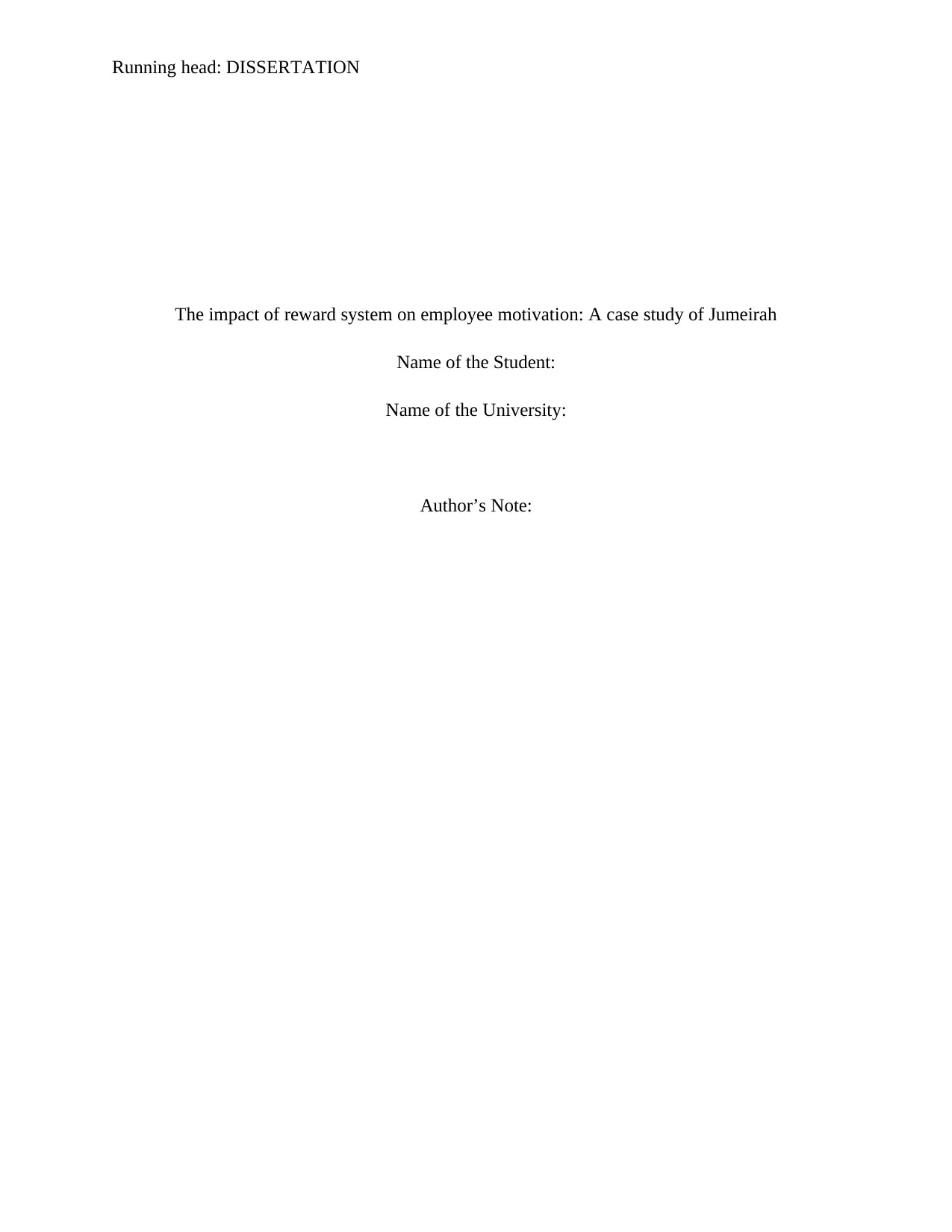
Running head: DISSERTATION
The impact of reward system on employee motivation: A case study of Jumeirah
Name of the Student:
Name of the University:
Author’s Note:
The impact of reward system on employee motivation: A case study of Jumeirah
Name of the Student:
Name of the University:
Author’s Note:
Secure Best Marks with AI Grader
Need help grading? Try our AI Grader for instant feedback on your assignments.
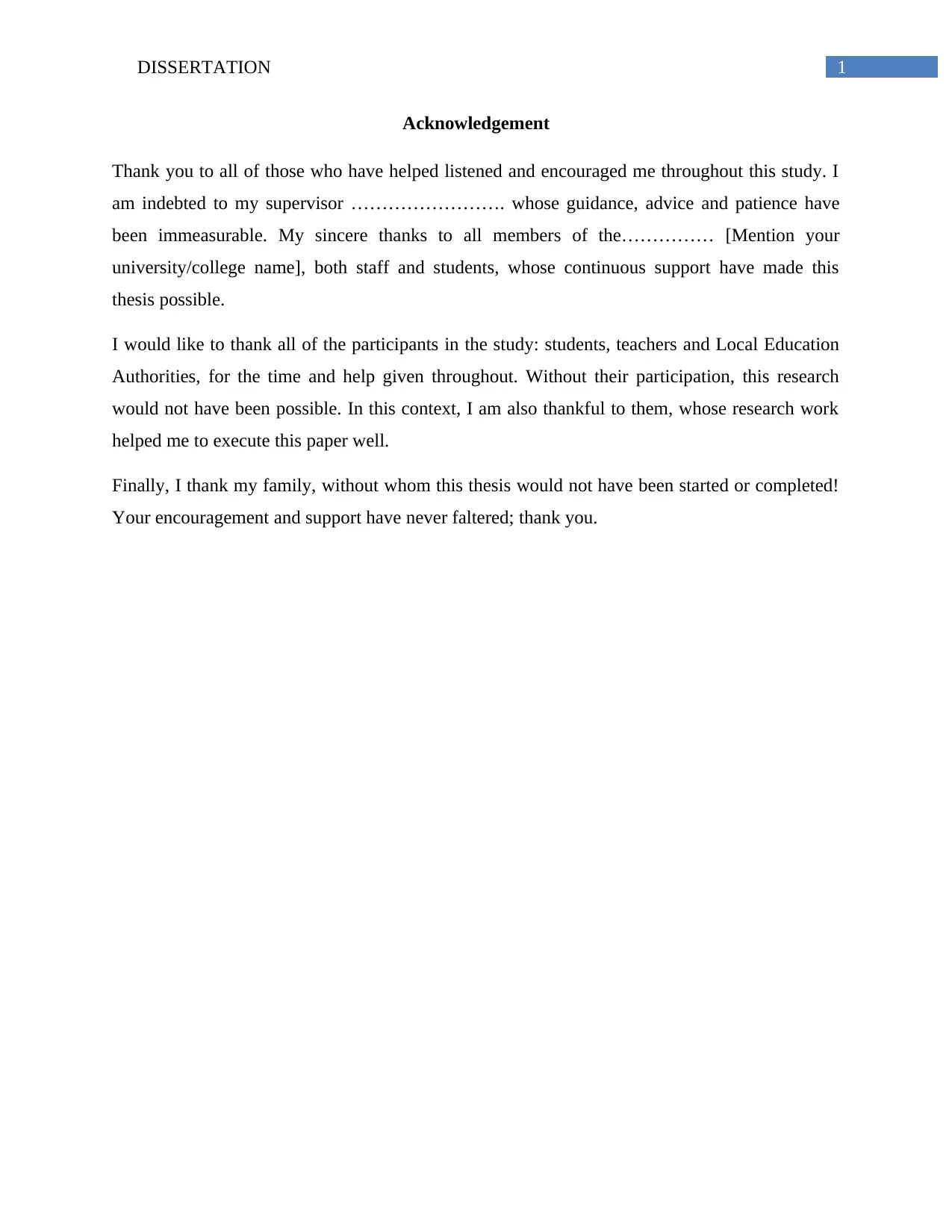
1DISSERTATION
Acknowledgement
Thank you to all of those who have helped listened and encouraged me throughout this study. I
am indebted to my supervisor ……………………. whose guidance, advice and patience have
been immeasurable. My sincere thanks to all members of the…………… [Mention your
university/college name], both staff and students, whose continuous support have made this
thesis possible.
I would like to thank all of the participants in the study: students, teachers and Local Education
Authorities, for the time and help given throughout. Without their participation, this research
would not have been possible. In this context, I am also thankful to them, whose research work
helped me to execute this paper well.
Finally, I thank my family, without whom this thesis would not have been started or completed!
Your encouragement and support have never faltered; thank you.
Acknowledgement
Thank you to all of those who have helped listened and encouraged me throughout this study. I
am indebted to my supervisor ……………………. whose guidance, advice and patience have
been immeasurable. My sincere thanks to all members of the…………… [Mention your
university/college name], both staff and students, whose continuous support have made this
thesis possible.
I would like to thank all of the participants in the study: students, teachers and Local Education
Authorities, for the time and help given throughout. Without their participation, this research
would not have been possible. In this context, I am also thankful to them, whose research work
helped me to execute this paper well.
Finally, I thank my family, without whom this thesis would not have been started or completed!
Your encouragement and support have never faltered; thank you.
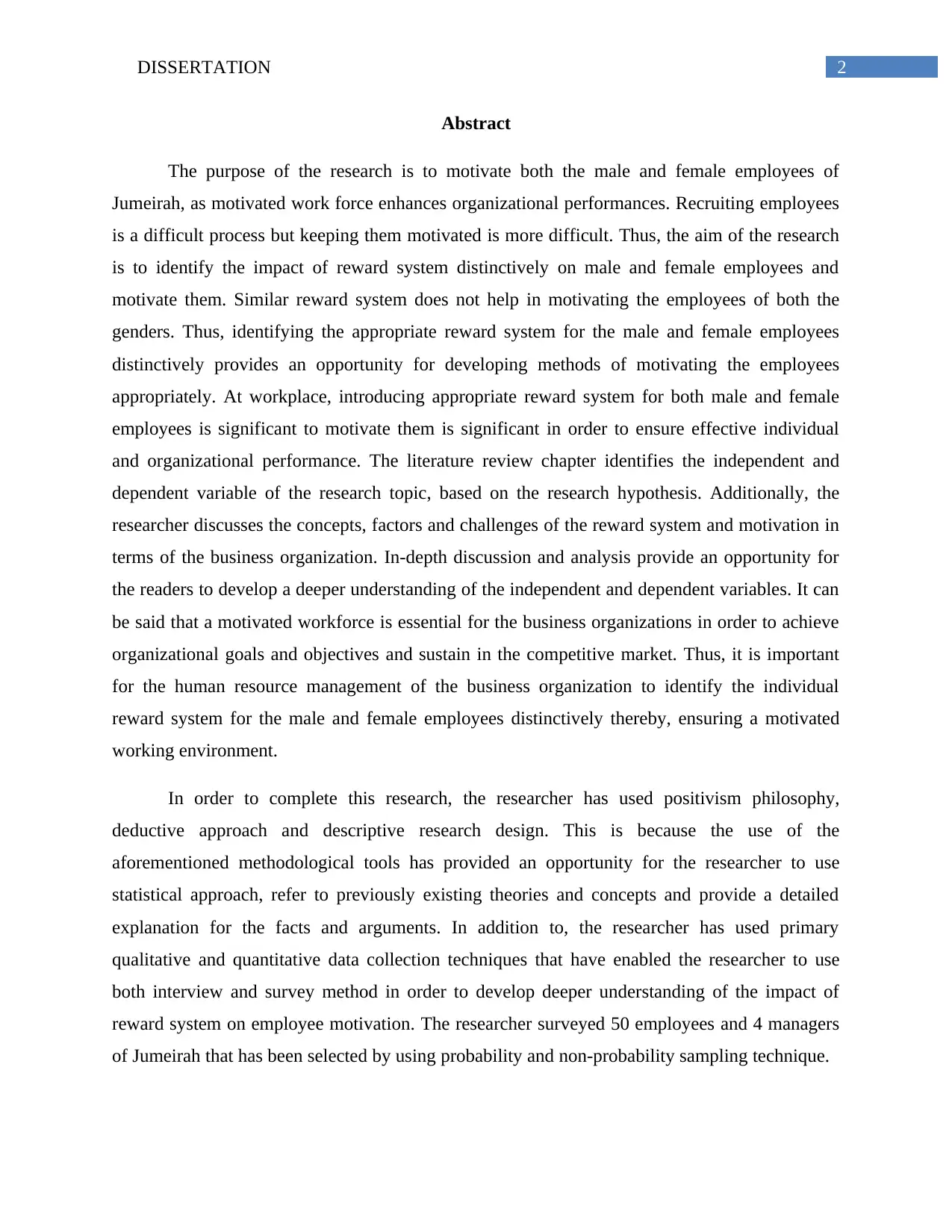
2DISSERTATION
Abstract
The purpose of the research is to motivate both the male and female employees of
Jumeirah, as motivated work force enhances organizational performances. Recruiting employees
is a difficult process but keeping them motivated is more difficult. Thus, the aim of the research
is to identify the impact of reward system distinctively on male and female employees and
motivate them. Similar reward system does not help in motivating the employees of both the
genders. Thus, identifying the appropriate reward system for the male and female employees
distinctively provides an opportunity for developing methods of motivating the employees
appropriately. At workplace, introducing appropriate reward system for both male and female
employees is significant to motivate them is significant in order to ensure effective individual
and organizational performance. The literature review chapter identifies the independent and
dependent variable of the research topic, based on the research hypothesis. Additionally, the
researcher discusses the concepts, factors and challenges of the reward system and motivation in
terms of the business organization. In-depth discussion and analysis provide an opportunity for
the readers to develop a deeper understanding of the independent and dependent variables. It can
be said that a motivated workforce is essential for the business organizations in order to achieve
organizational goals and objectives and sustain in the competitive market. Thus, it is important
for the human resource management of the business organization to identify the individual
reward system for the male and female employees distinctively thereby, ensuring a motivated
working environment.
In order to complete this research, the researcher has used positivism philosophy,
deductive approach and descriptive research design. This is because the use of the
aforementioned methodological tools has provided an opportunity for the researcher to use
statistical approach, refer to previously existing theories and concepts and provide a detailed
explanation for the facts and arguments. In addition to, the researcher has used primary
qualitative and quantitative data collection techniques that have enabled the researcher to use
both interview and survey method in order to develop deeper understanding of the impact of
reward system on employee motivation. The researcher surveyed 50 employees and 4 managers
of Jumeirah that has been selected by using probability and non-probability sampling technique.
Abstract
The purpose of the research is to motivate both the male and female employees of
Jumeirah, as motivated work force enhances organizational performances. Recruiting employees
is a difficult process but keeping them motivated is more difficult. Thus, the aim of the research
is to identify the impact of reward system distinctively on male and female employees and
motivate them. Similar reward system does not help in motivating the employees of both the
genders. Thus, identifying the appropriate reward system for the male and female employees
distinctively provides an opportunity for developing methods of motivating the employees
appropriately. At workplace, introducing appropriate reward system for both male and female
employees is significant to motivate them is significant in order to ensure effective individual
and organizational performance. The literature review chapter identifies the independent and
dependent variable of the research topic, based on the research hypothesis. Additionally, the
researcher discusses the concepts, factors and challenges of the reward system and motivation in
terms of the business organization. In-depth discussion and analysis provide an opportunity for
the readers to develop a deeper understanding of the independent and dependent variables. It can
be said that a motivated workforce is essential for the business organizations in order to achieve
organizational goals and objectives and sustain in the competitive market. Thus, it is important
for the human resource management of the business organization to identify the individual
reward system for the male and female employees distinctively thereby, ensuring a motivated
working environment.
In order to complete this research, the researcher has used positivism philosophy,
deductive approach and descriptive research design. This is because the use of the
aforementioned methodological tools has provided an opportunity for the researcher to use
statistical approach, refer to previously existing theories and concepts and provide a detailed
explanation for the facts and arguments. In addition to, the researcher has used primary
qualitative and quantitative data collection techniques that have enabled the researcher to use
both interview and survey method in order to develop deeper understanding of the impact of
reward system on employee motivation. The researcher surveyed 50 employees and 4 managers
of Jumeirah that has been selected by using probability and non-probability sampling technique.
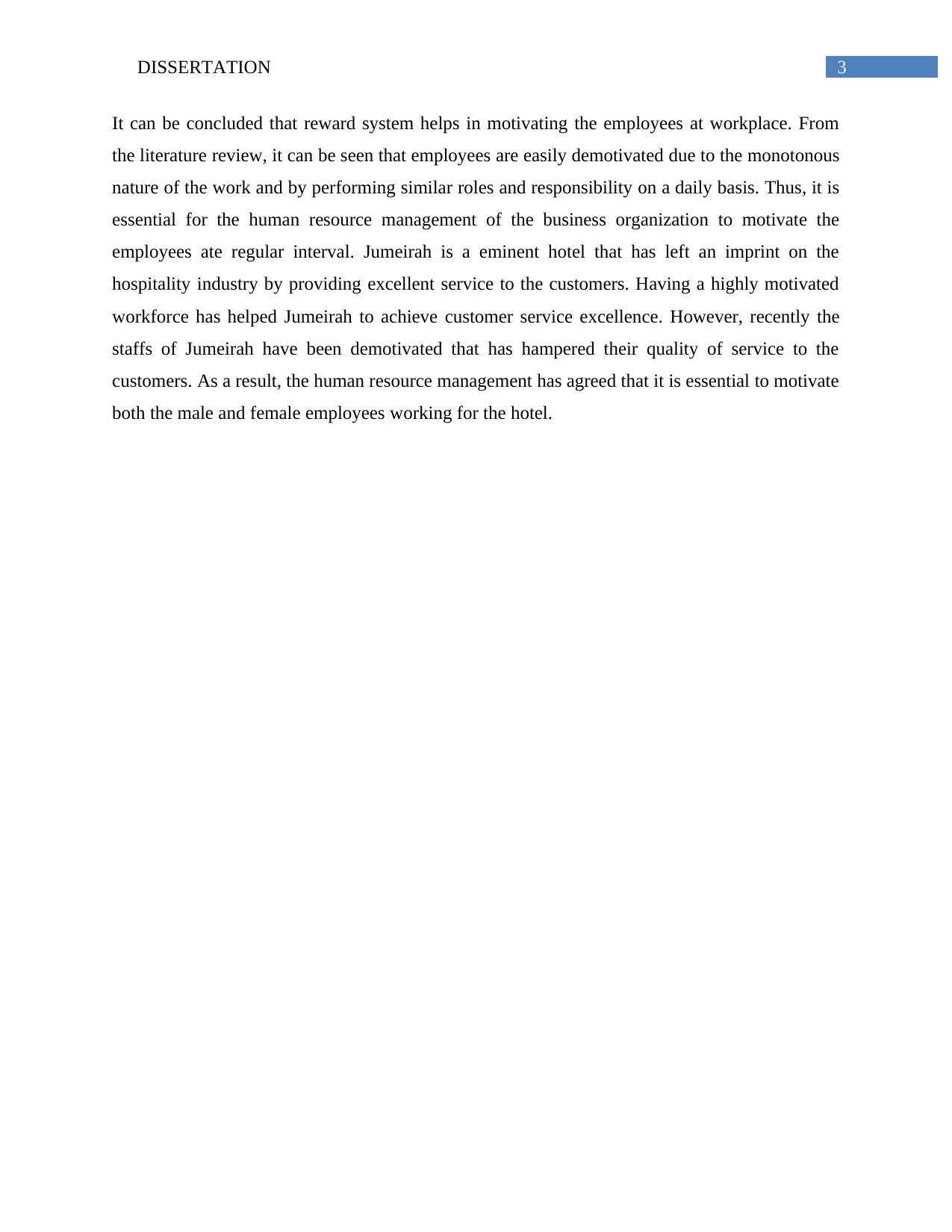
3DISSERTATION
It can be concluded that reward system helps in motivating the employees at workplace. From
the literature review, it can be seen that employees are easily demotivated due to the monotonous
nature of the work and by performing similar roles and responsibility on a daily basis. Thus, it is
essential for the human resource management of the business organization to motivate the
employees ate regular interval. Jumeirah is a eminent hotel that has left an imprint on the
hospitality industry by providing excellent service to the customers. Having a highly motivated
workforce has helped Jumeirah to achieve customer service excellence. However, recently the
staffs of Jumeirah have been demotivated that has hampered their quality of service to the
customers. As a result, the human resource management has agreed that it is essential to motivate
both the male and female employees working for the hotel.
It can be concluded that reward system helps in motivating the employees at workplace. From
the literature review, it can be seen that employees are easily demotivated due to the monotonous
nature of the work and by performing similar roles and responsibility on a daily basis. Thus, it is
essential for the human resource management of the business organization to motivate the
employees ate regular interval. Jumeirah is a eminent hotel that has left an imprint on the
hospitality industry by providing excellent service to the customers. Having a highly motivated
workforce has helped Jumeirah to achieve customer service excellence. However, recently the
staffs of Jumeirah have been demotivated that has hampered their quality of service to the
customers. As a result, the human resource management has agreed that it is essential to motivate
both the male and female employees working for the hotel.
Secure Best Marks with AI Grader
Need help grading? Try our AI Grader for instant feedback on your assignments.
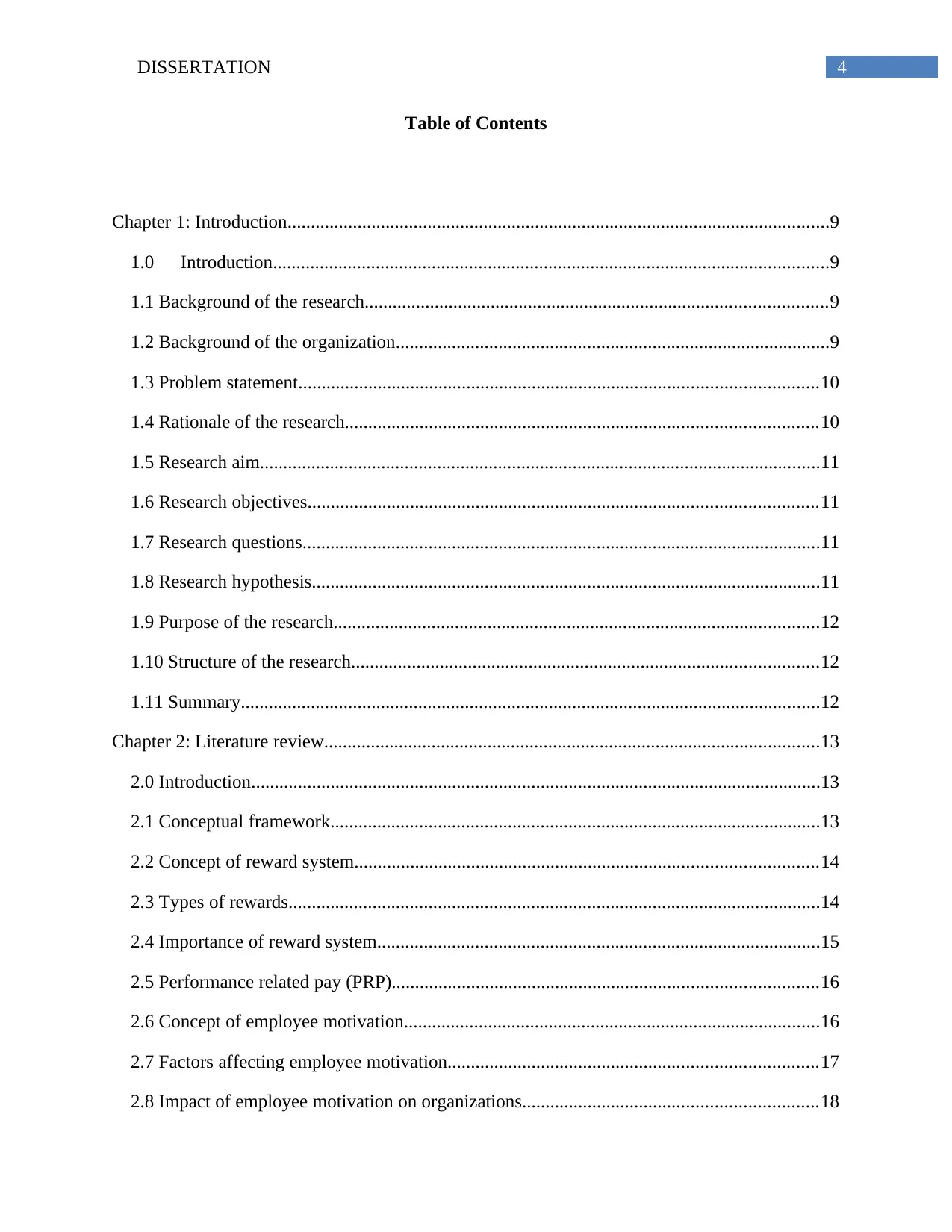
4DISSERTATION
Table of Contents
Chapter 1: Introduction....................................................................................................................9
1.0 Introduction.......................................................................................................................9
1.1 Background of the research...................................................................................................9
1.2 Background of the organization.............................................................................................9
1.3 Problem statement...............................................................................................................10
1.4 Rationale of the research.....................................................................................................10
1.5 Research aim........................................................................................................................11
1.6 Research objectives.............................................................................................................11
1.7 Research questions...............................................................................................................11
1.8 Research hypothesis.............................................................................................................11
1.9 Purpose of the research........................................................................................................12
1.10 Structure of the research....................................................................................................12
1.11 Summary............................................................................................................................12
Chapter 2: Literature review..........................................................................................................13
2.0 Introduction..........................................................................................................................13
2.1 Conceptual framework.........................................................................................................13
2.2 Concept of reward system...................................................................................................14
2.3 Types of rewards..................................................................................................................14
2.4 Importance of reward system...............................................................................................15
2.5 Performance related pay (PRP)...........................................................................................16
2.6 Concept of employee motivation.........................................................................................16
2.7 Factors affecting employee motivation...............................................................................17
2.8 Impact of employee motivation on organizations...............................................................18
Table of Contents
Chapter 1: Introduction....................................................................................................................9
1.0 Introduction.......................................................................................................................9
1.1 Background of the research...................................................................................................9
1.2 Background of the organization.............................................................................................9
1.3 Problem statement...............................................................................................................10
1.4 Rationale of the research.....................................................................................................10
1.5 Research aim........................................................................................................................11
1.6 Research objectives.............................................................................................................11
1.7 Research questions...............................................................................................................11
1.8 Research hypothesis.............................................................................................................11
1.9 Purpose of the research........................................................................................................12
1.10 Structure of the research....................................................................................................12
1.11 Summary............................................................................................................................12
Chapter 2: Literature review..........................................................................................................13
2.0 Introduction..........................................................................................................................13
2.1 Conceptual framework.........................................................................................................13
2.2 Concept of reward system...................................................................................................14
2.3 Types of rewards..................................................................................................................14
2.4 Importance of reward system...............................................................................................15
2.5 Performance related pay (PRP)...........................................................................................16
2.6 Concept of employee motivation.........................................................................................16
2.7 Factors affecting employee motivation...............................................................................17
2.8 Impact of employee motivation on organizations...............................................................18
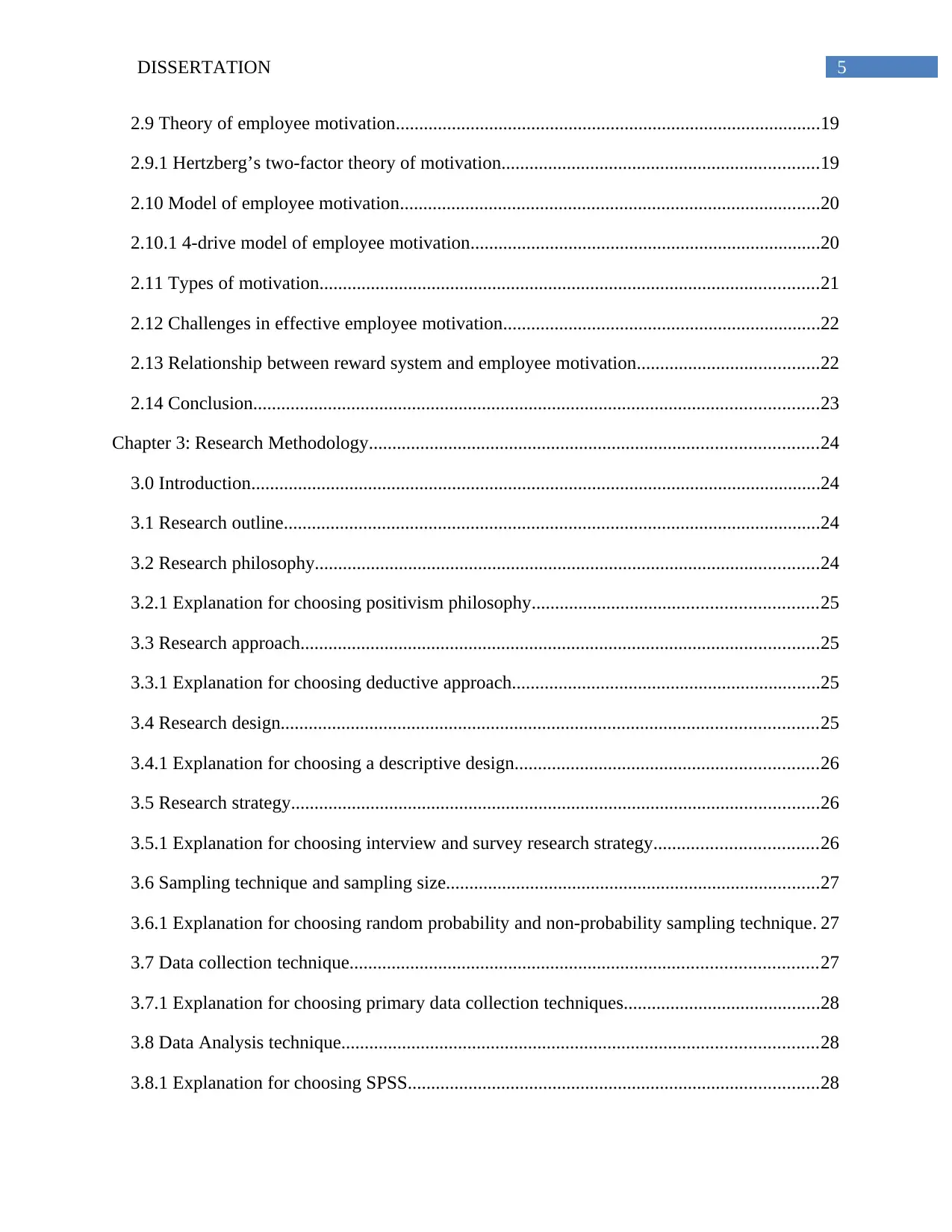
5DISSERTATION
2.9 Theory of employee motivation...........................................................................................19
2.9.1 Hertzberg’s two-factor theory of motivation....................................................................19
2.10 Model of employee motivation..........................................................................................20
2.10.1 4-drive model of employee motivation...........................................................................20
2.11 Types of motivation...........................................................................................................21
2.12 Challenges in effective employee motivation....................................................................22
2.13 Relationship between reward system and employee motivation.......................................22
2.14 Conclusion.........................................................................................................................23
Chapter 3: Research Methodology................................................................................................24
3.0 Introduction..........................................................................................................................24
3.1 Research outline...................................................................................................................24
3.2 Research philosophy............................................................................................................24
3.2.1 Explanation for choosing positivism philosophy.............................................................25
3.3 Research approach...............................................................................................................25
3.3.1 Explanation for choosing deductive approach..................................................................25
3.4 Research design...................................................................................................................25
3.4.1 Explanation for choosing a descriptive design.................................................................26
3.5 Research strategy.................................................................................................................26
3.5.1 Explanation for choosing interview and survey research strategy...................................26
3.6 Sampling technique and sampling size................................................................................27
3.6.1 Explanation for choosing random probability and non-probability sampling technique. 27
3.7 Data collection technique....................................................................................................27
3.7.1 Explanation for choosing primary data collection techniques..........................................28
3.8 Data Analysis technique......................................................................................................28
3.8.1 Explanation for choosing SPSS........................................................................................28
2.9 Theory of employee motivation...........................................................................................19
2.9.1 Hertzberg’s two-factor theory of motivation....................................................................19
2.10 Model of employee motivation..........................................................................................20
2.10.1 4-drive model of employee motivation...........................................................................20
2.11 Types of motivation...........................................................................................................21
2.12 Challenges in effective employee motivation....................................................................22
2.13 Relationship between reward system and employee motivation.......................................22
2.14 Conclusion.........................................................................................................................23
Chapter 3: Research Methodology................................................................................................24
3.0 Introduction..........................................................................................................................24
3.1 Research outline...................................................................................................................24
3.2 Research philosophy............................................................................................................24
3.2.1 Explanation for choosing positivism philosophy.............................................................25
3.3 Research approach...............................................................................................................25
3.3.1 Explanation for choosing deductive approach..................................................................25
3.4 Research design...................................................................................................................25
3.4.1 Explanation for choosing a descriptive design.................................................................26
3.5 Research strategy.................................................................................................................26
3.5.1 Explanation for choosing interview and survey research strategy...................................26
3.6 Sampling technique and sampling size................................................................................27
3.6.1 Explanation for choosing random probability and non-probability sampling technique. 27
3.7 Data collection technique....................................................................................................27
3.7.1 Explanation for choosing primary data collection techniques..........................................28
3.8 Data Analysis technique......................................................................................................28
3.8.1 Explanation for choosing SPSS........................................................................................28
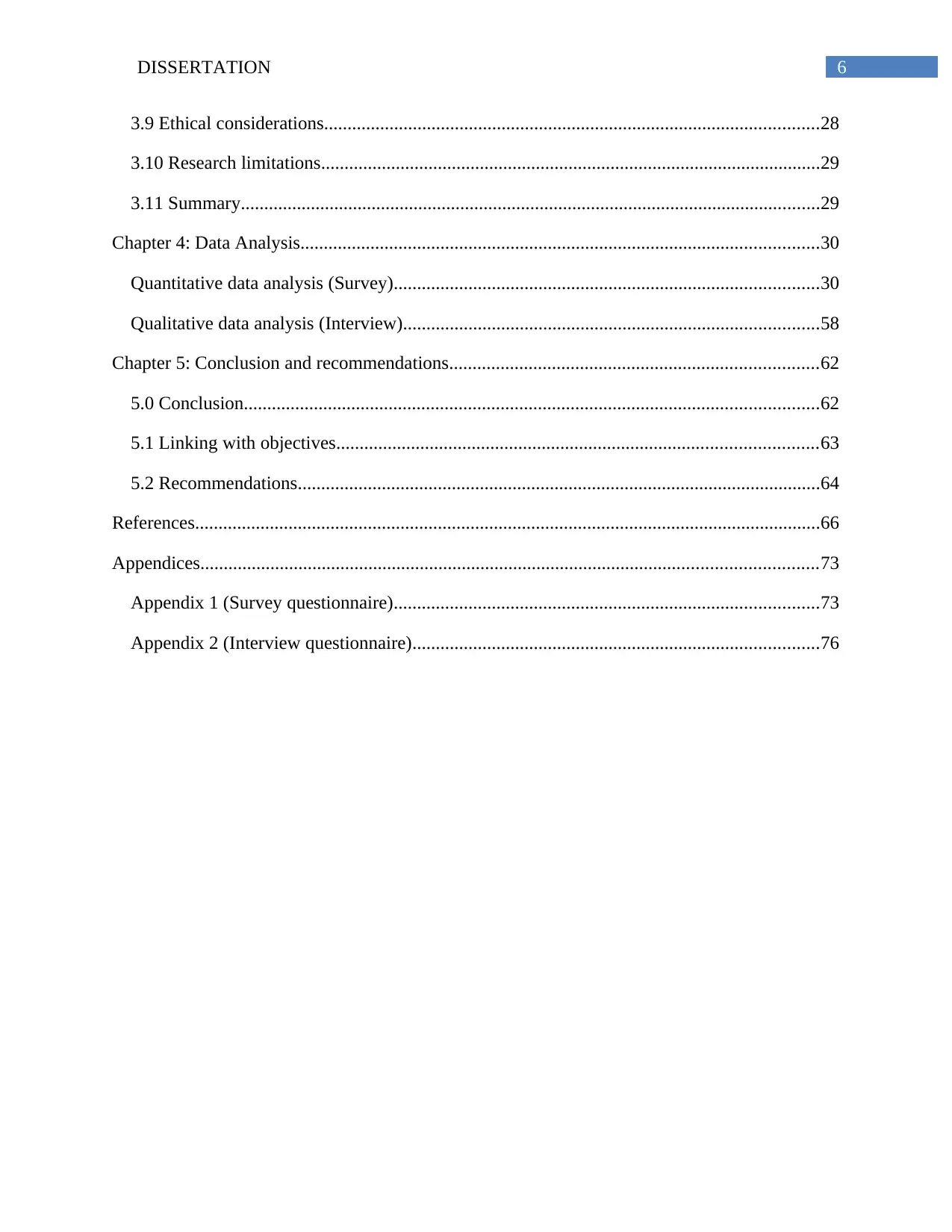
6DISSERTATION
3.9 Ethical considerations..........................................................................................................28
3.10 Research limitations...........................................................................................................29
3.11 Summary............................................................................................................................29
Chapter 4: Data Analysis...............................................................................................................30
Quantitative data analysis (Survey)...........................................................................................30
Qualitative data analysis (Interview).........................................................................................58
Chapter 5: Conclusion and recommendations...............................................................................62
5.0 Conclusion...........................................................................................................................62
5.1 Linking with objectives.......................................................................................................63
5.2 Recommendations................................................................................................................64
References......................................................................................................................................66
Appendices....................................................................................................................................73
Appendix 1 (Survey questionnaire)...........................................................................................73
Appendix 2 (Interview questionnaire).......................................................................................76
3.9 Ethical considerations..........................................................................................................28
3.10 Research limitations...........................................................................................................29
3.11 Summary............................................................................................................................29
Chapter 4: Data Analysis...............................................................................................................30
Quantitative data analysis (Survey)...........................................................................................30
Qualitative data analysis (Interview).........................................................................................58
Chapter 5: Conclusion and recommendations...............................................................................62
5.0 Conclusion...........................................................................................................................62
5.1 Linking with objectives.......................................................................................................63
5.2 Recommendations................................................................................................................64
References......................................................................................................................................66
Appendices....................................................................................................................................73
Appendix 1 (Survey questionnaire)...........................................................................................73
Appendix 2 (Interview questionnaire).......................................................................................76
Paraphrase This Document
Need a fresh take? Get an instant paraphrase of this document with our AI Paraphraser

7DISSERTATION
List of Figures
Figure 1: Conceptual framework...................................................................................................13
Figure 2: 4-Drive Model of Employee Motivation........................................................................21
Figure 3: Age.................................................................................................................................30
Figure 4: Gender............................................................................................................................31
Figure 5: Duration of work at Jumeirah........................................................................................32
Figure 6: Effectiveness of reward in motivation...........................................................................33
Figure 7: Types of reward motivating employees.........................................................................34
Figure 8: Effect of organizational policies in reward system........................................................35
Figure 9: Effectiveness of reward system on motivation..............................................................36
Figure 10: Effect of reward system in male and female employees..............................................37
Figure 11: Satisfaction level of reward system..............................................................................38
Figure 12: Improving the reward system at Jumeirah...................................................................39
List of Figures
Figure 1: Conceptual framework...................................................................................................13
Figure 2: 4-Drive Model of Employee Motivation........................................................................21
Figure 3: Age.................................................................................................................................30
Figure 4: Gender............................................................................................................................31
Figure 5: Duration of work at Jumeirah........................................................................................32
Figure 6: Effectiveness of reward in motivation...........................................................................33
Figure 7: Types of reward motivating employees.........................................................................34
Figure 8: Effect of organizational policies in reward system........................................................35
Figure 9: Effectiveness of reward system on motivation..............................................................36
Figure 10: Effect of reward system in male and female employees..............................................37
Figure 11: Satisfaction level of reward system..............................................................................38
Figure 12: Improving the reward system at Jumeirah...................................................................39
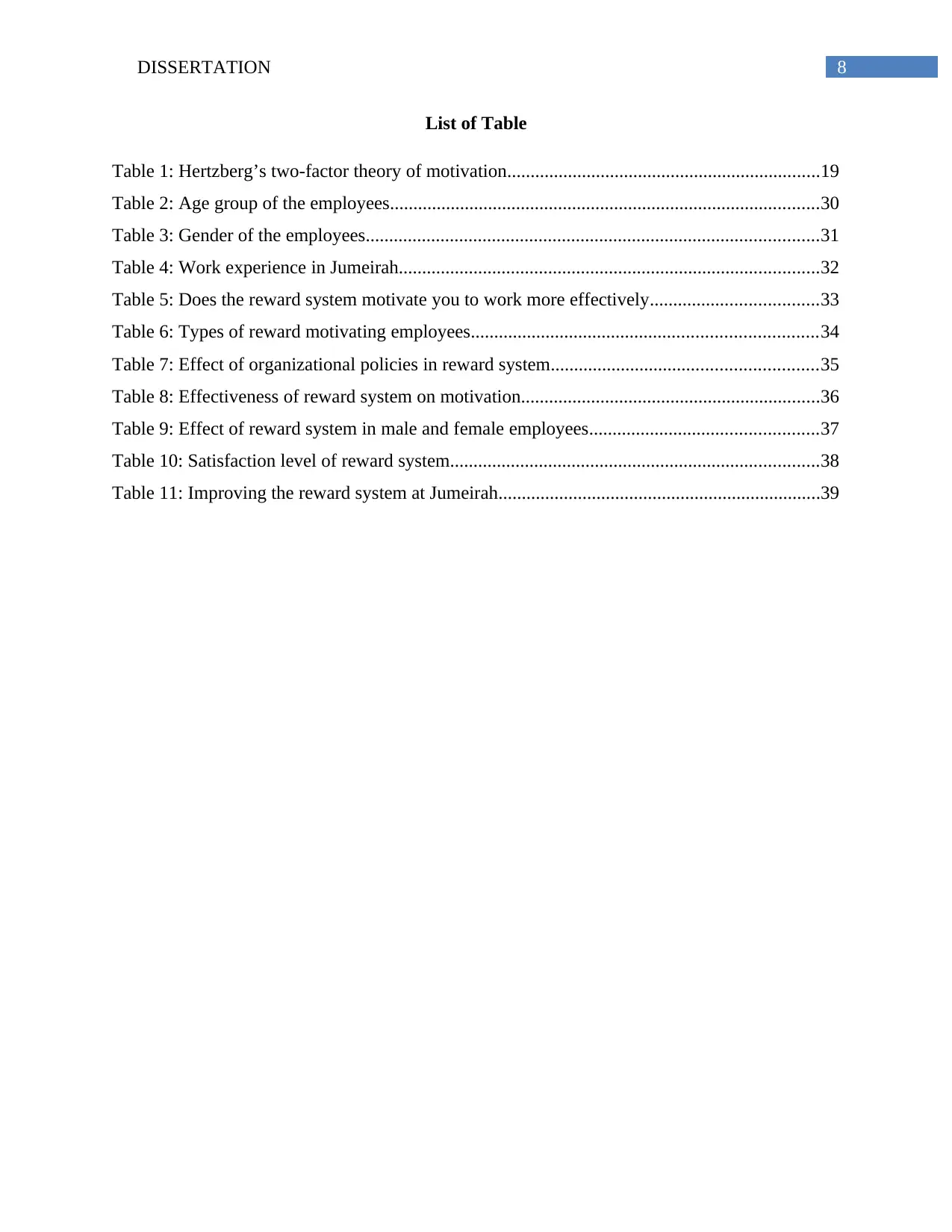
8DISSERTATION
List of Table
Table 1: Hertzberg’s two-factor theory of motivation...................................................................19
Table 2: Age group of the employees............................................................................................30
Table 3: Gender of the employees.................................................................................................31
Table 4: Work experience in Jumeirah..........................................................................................32
Table 5: Does the reward system motivate you to work more effectively....................................33
Table 6: Types of reward motivating employees..........................................................................34
Table 7: Effect of organizational policies in reward system.........................................................35
Table 8: Effectiveness of reward system on motivation................................................................36
Table 9: Effect of reward system in male and female employees.................................................37
Table 10: Satisfaction level of reward system...............................................................................38
Table 11: Improving the reward system at Jumeirah.....................................................................39
List of Table
Table 1: Hertzberg’s two-factor theory of motivation...................................................................19
Table 2: Age group of the employees............................................................................................30
Table 3: Gender of the employees.................................................................................................31
Table 4: Work experience in Jumeirah..........................................................................................32
Table 5: Does the reward system motivate you to work more effectively....................................33
Table 6: Types of reward motivating employees..........................................................................34
Table 7: Effect of organizational policies in reward system.........................................................35
Table 8: Effectiveness of reward system on motivation................................................................36
Table 9: Effect of reward system in male and female employees.................................................37
Table 10: Satisfaction level of reward system...............................................................................38
Table 11: Improving the reward system at Jumeirah.....................................................................39

9DISSERTATION
Chapter 1: Introduction
1.0 Introduction
At workplace, introducing appropriate reward system for both male and female employees is
significant to motivate them is significant in order to ensure effective individual and
organizational performance. As commented by ( Njoroge & Yazdanifard, 2014), a motivated
workforce is essential for the business organizations, as this helps in achieving organizational
goals and objectives. This is because reward helps in enhancing the morale boosts of the
individual workers thereby, motivating them to work better towards their job roles and
responsibilities. This provides an opportunity for the business organizations to sustain the market
competition in the competitive market by gaining competitive advantage. The needs and
requirements of the male and female employees differ due to distinctive individualities that is,
individual beliefs, attitudes, cultures, needs and requirements
1.1 Background of the research
The work environment has changed considerably over the years in terms of the work
force and the nature of the work. One of the major reasons for the change in the working
environment is due to the gender differences. Gender difference highlights different approach of
doing work and different opportunities provided to the male and female employees. Previously,
the work environment encountered less female employees compared to male employees.
Recently, the ratio of female to male employees has increased at the workplace. As a result, it is
essential for the human resource management of the business organization to identify and
implement a distinctive reward system for the male and female employees thereby, ensuring
effective motivation (Lazaroiu, 2015).
1.2 Background of the organization
Jumeirah is a Dubai based international luxury chain of hotels that was established in
1997. Jumeirah collaborated with Dubai Holding in 2004 and since then the hotel chain has
expanded in different countries globally. Professional golfer Rory Mcllory was the brand
ambassador of the chain of hotels from 2007-2012 (Jumeriah.com, 2018). Jumeirah chain of
hotels has announced its expansion in the Asia and China in 2016. The company has also
established their chain in Maldives where both the genders of employees are being employed and
Chapter 1: Introduction
1.0 Introduction
At workplace, introducing appropriate reward system for both male and female employees is
significant to motivate them is significant in order to ensure effective individual and
organizational performance. As commented by ( Njoroge & Yazdanifard, 2014), a motivated
workforce is essential for the business organizations, as this helps in achieving organizational
goals and objectives. This is because reward helps in enhancing the morale boosts of the
individual workers thereby, motivating them to work better towards their job roles and
responsibilities. This provides an opportunity for the business organizations to sustain the market
competition in the competitive market by gaining competitive advantage. The needs and
requirements of the male and female employees differ due to distinctive individualities that is,
individual beliefs, attitudes, cultures, needs and requirements
1.1 Background of the research
The work environment has changed considerably over the years in terms of the work
force and the nature of the work. One of the major reasons for the change in the working
environment is due to the gender differences. Gender difference highlights different approach of
doing work and different opportunities provided to the male and female employees. Previously,
the work environment encountered less female employees compared to male employees.
Recently, the ratio of female to male employees has increased at the workplace. As a result, it is
essential for the human resource management of the business organization to identify and
implement a distinctive reward system for the male and female employees thereby, ensuring
effective motivation (Lazaroiu, 2015).
1.2 Background of the organization
Jumeirah is a Dubai based international luxury chain of hotels that was established in
1997. Jumeirah collaborated with Dubai Holding in 2004 and since then the hotel chain has
expanded in different countries globally. Professional golfer Rory Mcllory was the brand
ambassador of the chain of hotels from 2007-2012 (Jumeriah.com, 2018). Jumeirah chain of
hotels has announced its expansion in the Asia and China in 2016. The company has also
established their chain in Maldives where both the genders of employees are being employed and
Secure Best Marks with AI Grader
Need help grading? Try our AI Grader for instant feedback on your assignments.
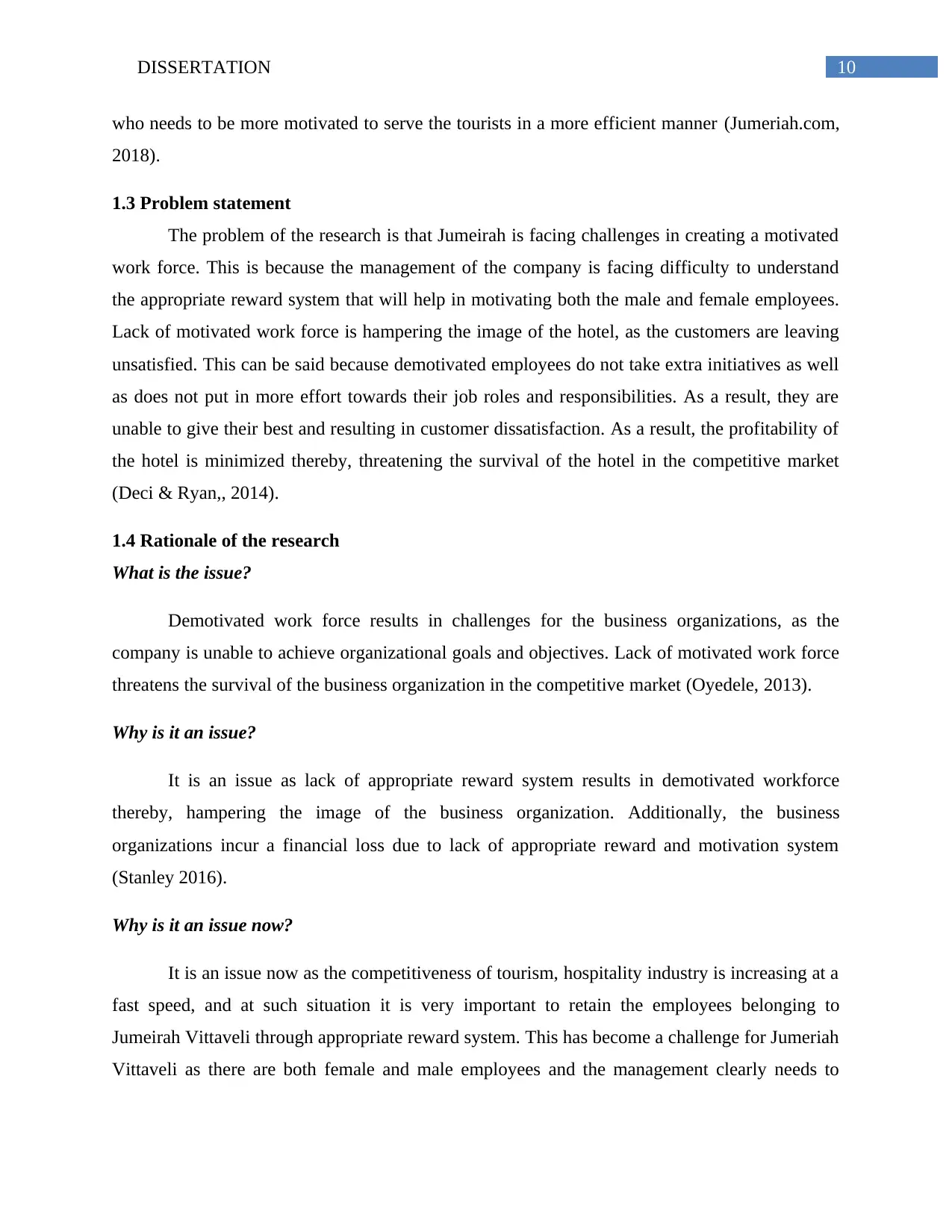
10DISSERTATION
who needs to be more motivated to serve the tourists in a more efficient manner (Jumeriah.com,
2018).
1.3 Problem statement
The problem of the research is that Jumeirah is facing challenges in creating a motivated
work force. This is because the management of the company is facing difficulty to understand
the appropriate reward system that will help in motivating both the male and female employees.
Lack of motivated work force is hampering the image of the hotel, as the customers are leaving
unsatisfied. This can be said because demotivated employees do not take extra initiatives as well
as does not put in more effort towards their job roles and responsibilities. As a result, they are
unable to give their best and resulting in customer dissatisfaction. As a result, the profitability of
the hotel is minimized thereby, threatening the survival of the hotel in the competitive market
(Deci & Ryan,, 2014).
1.4 Rationale of the research
What is the issue?
Demotivated work force results in challenges for the business organizations, as the
company is unable to achieve organizational goals and objectives. Lack of motivated work force
threatens the survival of the business organization in the competitive market (Oyedele, 2013).
Why is it an issue?
It is an issue as lack of appropriate reward system results in demotivated workforce
thereby, hampering the image of the business organization. Additionally, the business
organizations incur a financial loss due to lack of appropriate reward and motivation system
(Stanley 2016).
Why is it an issue now?
It is an issue now as the competitiveness of tourism, hospitality industry is increasing at a
fast speed, and at such situation it is very important to retain the employees belonging to
Jumeirah Vittaveli through appropriate reward system. This has become a challenge for Jumeriah
Vittaveli as there are both female and male employees and the management clearly needs to
who needs to be more motivated to serve the tourists in a more efficient manner (Jumeriah.com,
2018).
1.3 Problem statement
The problem of the research is that Jumeirah is facing challenges in creating a motivated
work force. This is because the management of the company is facing difficulty to understand
the appropriate reward system that will help in motivating both the male and female employees.
Lack of motivated work force is hampering the image of the hotel, as the customers are leaving
unsatisfied. This can be said because demotivated employees do not take extra initiatives as well
as does not put in more effort towards their job roles and responsibilities. As a result, they are
unable to give their best and resulting in customer dissatisfaction. As a result, the profitability of
the hotel is minimized thereby, threatening the survival of the hotel in the competitive market
(Deci & Ryan,, 2014).
1.4 Rationale of the research
What is the issue?
Demotivated work force results in challenges for the business organizations, as the
company is unable to achieve organizational goals and objectives. Lack of motivated work force
threatens the survival of the business organization in the competitive market (Oyedele, 2013).
Why is it an issue?
It is an issue as lack of appropriate reward system results in demotivated workforce
thereby, hampering the image of the business organization. Additionally, the business
organizations incur a financial loss due to lack of appropriate reward and motivation system
(Stanley 2016).
Why is it an issue now?
It is an issue now as the competitiveness of tourism, hospitality industry is increasing at a
fast speed, and at such situation it is very important to retain the employees belonging to
Jumeirah Vittaveli through appropriate reward system. This has become a challenge for Jumeriah
Vittaveli as there are both female and male employees and the management clearly needs to
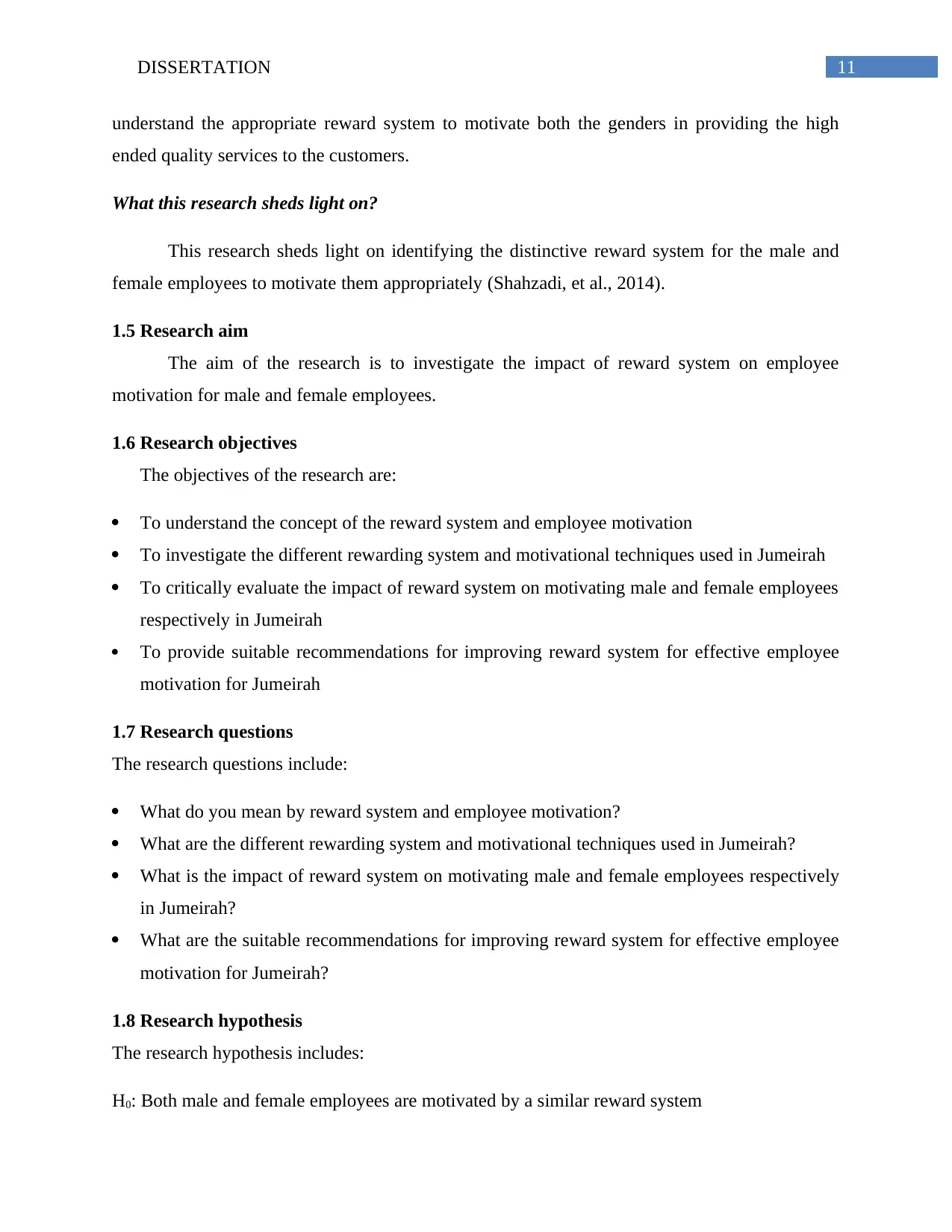
11DISSERTATION
understand the appropriate reward system to motivate both the genders in providing the high
ended quality services to the customers.
What this research sheds light on?
This research sheds light on identifying the distinctive reward system for the male and
female employees to motivate them appropriately (Shahzadi, et al., 2014).
1.5 Research aim
The aim of the research is to investigate the impact of reward system on employee
motivation for male and female employees.
1.6 Research objectives
The objectives of the research are:
To understand the concept of the reward system and employee motivation
To investigate the different rewarding system and motivational techniques used in Jumeirah
To critically evaluate the impact of reward system on motivating male and female employees
respectively in Jumeirah
To provide suitable recommendations for improving reward system for effective employee
motivation for Jumeirah
1.7 Research questions
The research questions include:
What do you mean by reward system and employee motivation?
What are the different rewarding system and motivational techniques used in Jumeirah?
What is the impact of reward system on motivating male and female employees respectively
in Jumeirah?
What are the suitable recommendations for improving reward system for effective employee
motivation for Jumeirah?
1.8 Research hypothesis
The research hypothesis includes:
H0: Both male and female employees are motivated by a similar reward system
understand the appropriate reward system to motivate both the genders in providing the high
ended quality services to the customers.
What this research sheds light on?
This research sheds light on identifying the distinctive reward system for the male and
female employees to motivate them appropriately (Shahzadi, et al., 2014).
1.5 Research aim
The aim of the research is to investigate the impact of reward system on employee
motivation for male and female employees.
1.6 Research objectives
The objectives of the research are:
To understand the concept of the reward system and employee motivation
To investigate the different rewarding system and motivational techniques used in Jumeirah
To critically evaluate the impact of reward system on motivating male and female employees
respectively in Jumeirah
To provide suitable recommendations for improving reward system for effective employee
motivation for Jumeirah
1.7 Research questions
The research questions include:
What do you mean by reward system and employee motivation?
What are the different rewarding system and motivational techniques used in Jumeirah?
What is the impact of reward system on motivating male and female employees respectively
in Jumeirah?
What are the suitable recommendations for improving reward system for effective employee
motivation for Jumeirah?
1.8 Research hypothesis
The research hypothesis includes:
H0: Both male and female employees are motivated by a similar reward system
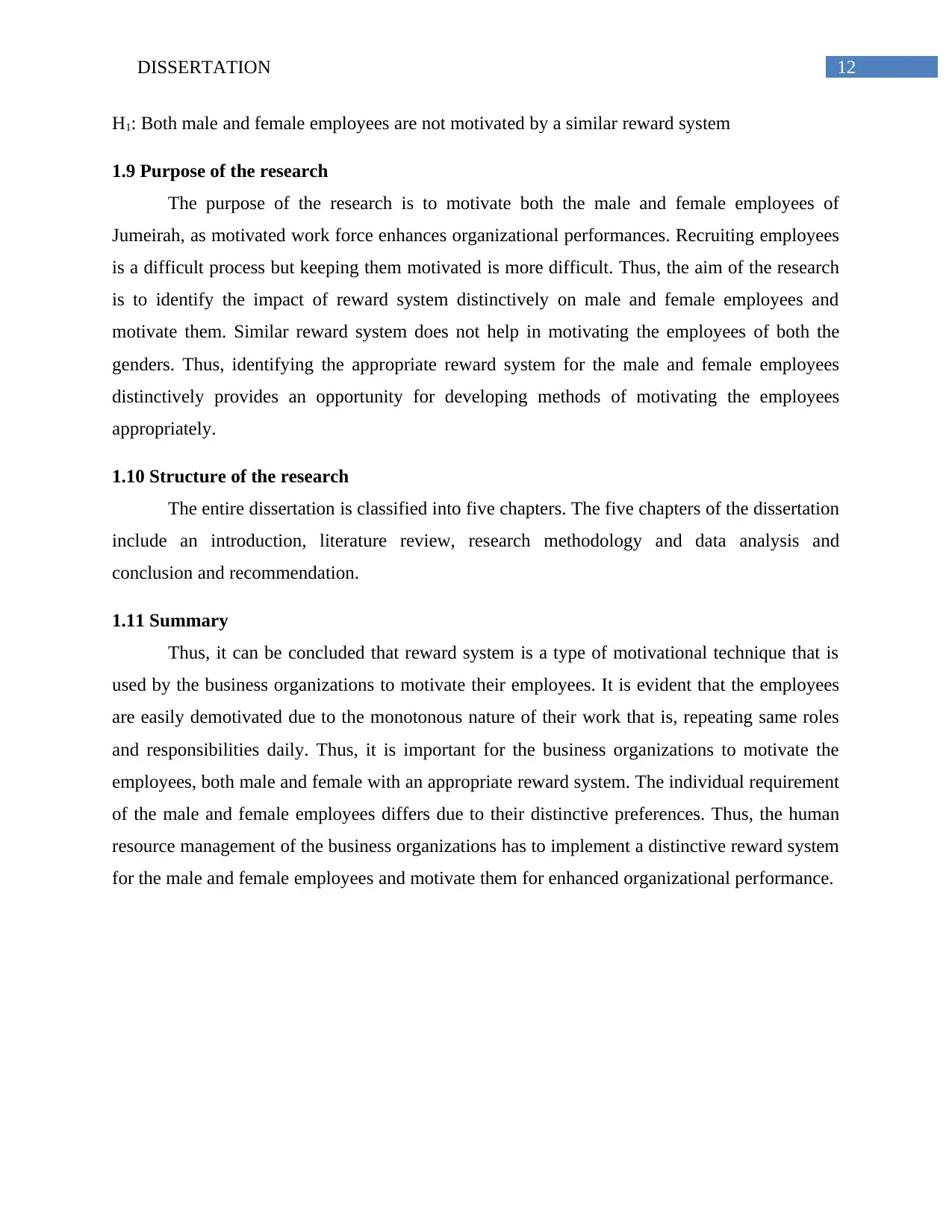
12DISSERTATION
H1: Both male and female employees are not motivated by a similar reward system
1.9 Purpose of the research
The purpose of the research is to motivate both the male and female employees of
Jumeirah, as motivated work force enhances organizational performances. Recruiting employees
is a difficult process but keeping them motivated is more difficult. Thus, the aim of the research
is to identify the impact of reward system distinctively on male and female employees and
motivate them. Similar reward system does not help in motivating the employees of both the
genders. Thus, identifying the appropriate reward system for the male and female employees
distinctively provides an opportunity for developing methods of motivating the employees
appropriately.
1.10 Structure of the research
The entire dissertation is classified into five chapters. The five chapters of the dissertation
include an introduction, literature review, research methodology and data analysis and
conclusion and recommendation.
1.11 Summary
Thus, it can be concluded that reward system is a type of motivational technique that is
used by the business organizations to motivate their employees. It is evident that the employees
are easily demotivated due to the monotonous nature of their work that is, repeating same roles
and responsibilities daily. Thus, it is important for the business organizations to motivate the
employees, both male and female with an appropriate reward system. The individual requirement
of the male and female employees differs due to their distinctive preferences. Thus, the human
resource management of the business organizations has to implement a distinctive reward system
for the male and female employees and motivate them for enhanced organizational performance.
H1: Both male and female employees are not motivated by a similar reward system
1.9 Purpose of the research
The purpose of the research is to motivate both the male and female employees of
Jumeirah, as motivated work force enhances organizational performances. Recruiting employees
is a difficult process but keeping them motivated is more difficult. Thus, the aim of the research
is to identify the impact of reward system distinctively on male and female employees and
motivate them. Similar reward system does not help in motivating the employees of both the
genders. Thus, identifying the appropriate reward system for the male and female employees
distinctively provides an opportunity for developing methods of motivating the employees
appropriately.
1.10 Structure of the research
The entire dissertation is classified into five chapters. The five chapters of the dissertation
include an introduction, literature review, research methodology and data analysis and
conclusion and recommendation.
1.11 Summary
Thus, it can be concluded that reward system is a type of motivational technique that is
used by the business organizations to motivate their employees. It is evident that the employees
are easily demotivated due to the monotonous nature of their work that is, repeating same roles
and responsibilities daily. Thus, it is important for the business organizations to motivate the
employees, both male and female with an appropriate reward system. The individual requirement
of the male and female employees differs due to their distinctive preferences. Thus, the human
resource management of the business organizations has to implement a distinctive reward system
for the male and female employees and motivate them for enhanced organizational performance.
Paraphrase This Document
Need a fresh take? Get an instant paraphrase of this document with our AI Paraphraser
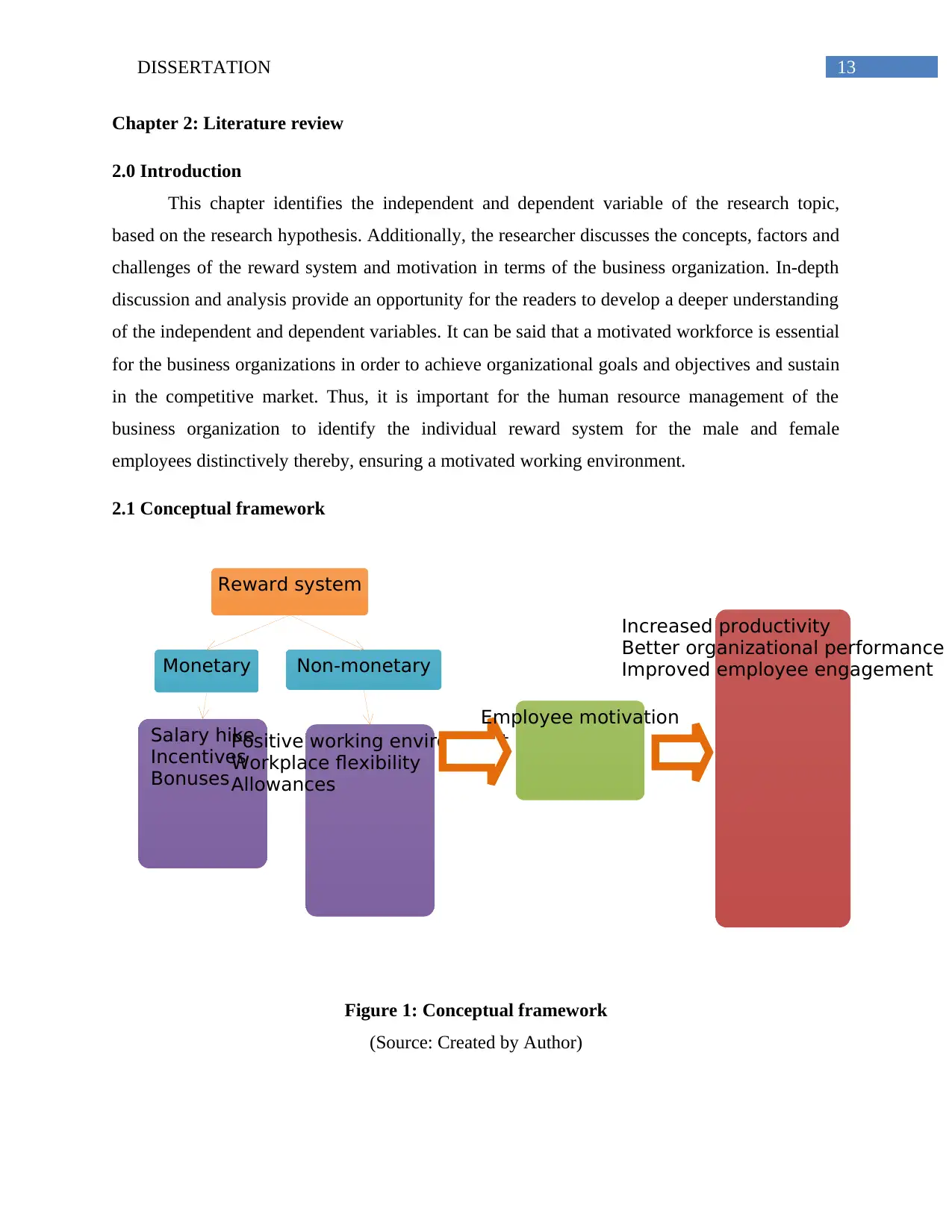
13DISSERTATION
Reward system
Monetary Non-monetary
Salary hike
Incentives
Bonuses
Positive working environment
Workplace flexibility
Allowances
Employee motivation
Increased productivity
Better organizational performance
Improved employee engagement
Chapter 2: Literature review
2.0 Introduction
This chapter identifies the independent and dependent variable of the research topic,
based on the research hypothesis. Additionally, the researcher discusses the concepts, factors and
challenges of the reward system and motivation in terms of the business organization. In-depth
discussion and analysis provide an opportunity for the readers to develop a deeper understanding
of the independent and dependent variables. It can be said that a motivated workforce is essential
for the business organizations in order to achieve organizational goals and objectives and sustain
in the competitive market. Thus, it is important for the human resource management of the
business organization to identify the individual reward system for the male and female
employees distinctively thereby, ensuring a motivated working environment.
2.1 Conceptual framework
Figure 1: Conceptual framework
(Source: Created by Author)
Reward system
Monetary Non-monetary
Salary hike
Incentives
Bonuses
Positive working environment
Workplace flexibility
Allowances
Employee motivation
Increased productivity
Better organizational performance
Improved employee engagement
Chapter 2: Literature review
2.0 Introduction
This chapter identifies the independent and dependent variable of the research topic,
based on the research hypothesis. Additionally, the researcher discusses the concepts, factors and
challenges of the reward system and motivation in terms of the business organization. In-depth
discussion and analysis provide an opportunity for the readers to develop a deeper understanding
of the independent and dependent variables. It can be said that a motivated workforce is essential
for the business organizations in order to achieve organizational goals and objectives and sustain
in the competitive market. Thus, it is important for the human resource management of the
business organization to identify the individual reward system for the male and female
employees distinctively thereby, ensuring a motivated working environment.
2.1 Conceptual framework
Figure 1: Conceptual framework
(Source: Created by Author)
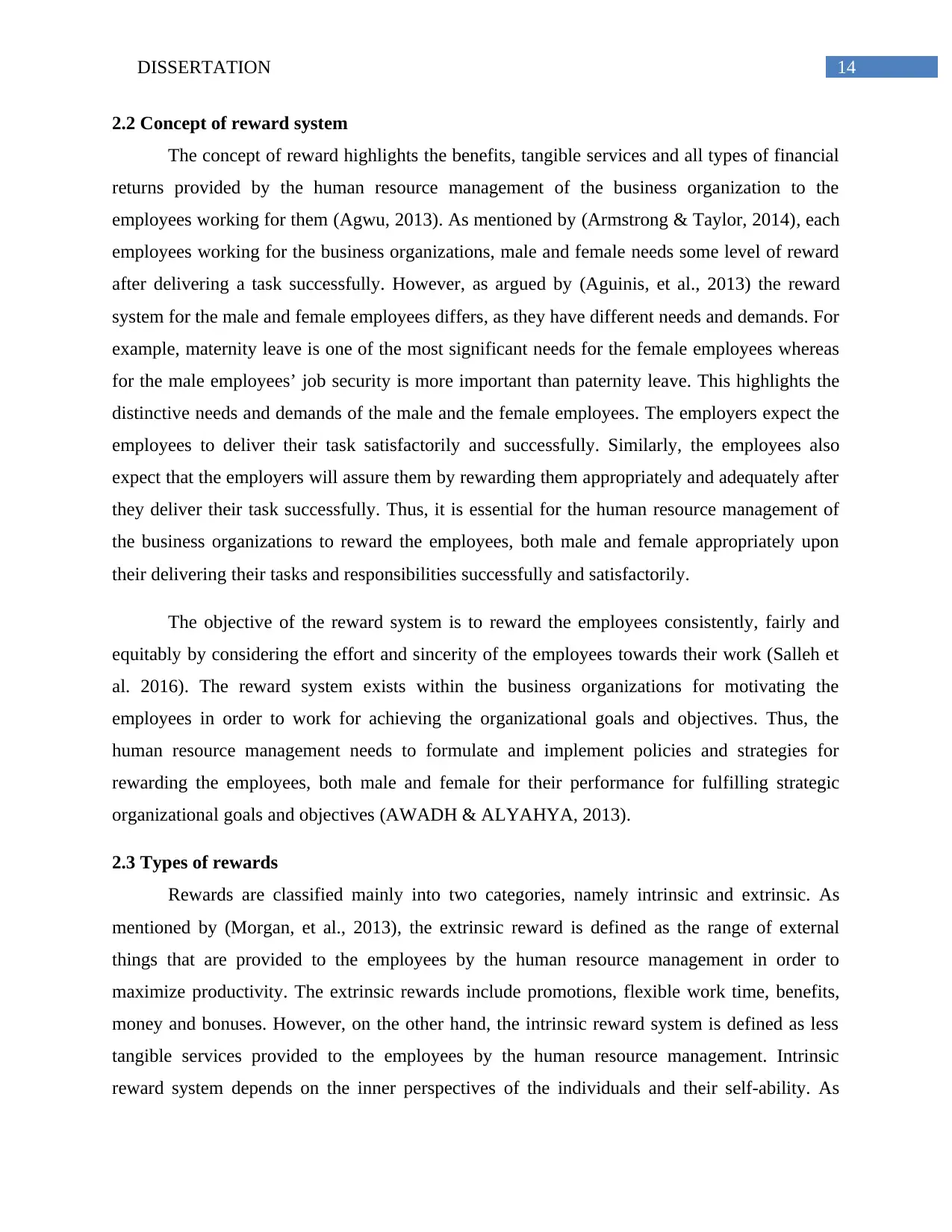
14DISSERTATION
2.2 Concept of reward system
The concept of reward highlights the benefits, tangible services and all types of financial
returns provided by the human resource management of the business organization to the
employees working for them (Agwu, 2013). As mentioned by (Armstrong & Taylor, 2014), each
employees working for the business organizations, male and female needs some level of reward
after delivering a task successfully. However, as argued by (Aguinis, et al., 2013) the reward
system for the male and female employees differs, as they have different needs and demands. For
example, maternity leave is one of the most significant needs for the female employees whereas
for the male employees’ job security is more important than paternity leave. This highlights the
distinctive needs and demands of the male and the female employees. The employers expect the
employees to deliver their task satisfactorily and successfully. Similarly, the employees also
expect that the employers will assure them by rewarding them appropriately and adequately after
they deliver their task successfully. Thus, it is essential for the human resource management of
the business organizations to reward the employees, both male and female appropriately upon
their delivering their tasks and responsibilities successfully and satisfactorily.
The objective of the reward system is to reward the employees consistently, fairly and
equitably by considering the effort and sincerity of the employees towards their work (Salleh et
al. 2016). The reward system exists within the business organizations for motivating the
employees in order to work for achieving the organizational goals and objectives. Thus, the
human resource management needs to formulate and implement policies and strategies for
rewarding the employees, both male and female for their performance for fulfilling strategic
organizational goals and objectives (AWADH & ALYAHYA, 2013).
2.3 Types of rewards
Rewards are classified mainly into two categories, namely intrinsic and extrinsic. As
mentioned by (Morgan, et al., 2013), the extrinsic reward is defined as the range of external
things that are provided to the employees by the human resource management in order to
maximize productivity. The extrinsic rewards include promotions, flexible work time, benefits,
money and bonuses. However, on the other hand, the intrinsic reward system is defined as less
tangible services provided to the employees by the human resource management. Intrinsic
reward system depends on the inner perspectives of the individuals and their self-ability. As
2.2 Concept of reward system
The concept of reward highlights the benefits, tangible services and all types of financial
returns provided by the human resource management of the business organization to the
employees working for them (Agwu, 2013). As mentioned by (Armstrong & Taylor, 2014), each
employees working for the business organizations, male and female needs some level of reward
after delivering a task successfully. However, as argued by (Aguinis, et al., 2013) the reward
system for the male and female employees differs, as they have different needs and demands. For
example, maternity leave is one of the most significant needs for the female employees whereas
for the male employees’ job security is more important than paternity leave. This highlights the
distinctive needs and demands of the male and the female employees. The employers expect the
employees to deliver their task satisfactorily and successfully. Similarly, the employees also
expect that the employers will assure them by rewarding them appropriately and adequately after
they deliver their task successfully. Thus, it is essential for the human resource management of
the business organizations to reward the employees, both male and female appropriately upon
their delivering their tasks and responsibilities successfully and satisfactorily.
The objective of the reward system is to reward the employees consistently, fairly and
equitably by considering the effort and sincerity of the employees towards their work (Salleh et
al. 2016). The reward system exists within the business organizations for motivating the
employees in order to work for achieving the organizational goals and objectives. Thus, the
human resource management needs to formulate and implement policies and strategies for
rewarding the employees, both male and female for their performance for fulfilling strategic
organizational goals and objectives (AWADH & ALYAHYA, 2013).
2.3 Types of rewards
Rewards are classified mainly into two categories, namely intrinsic and extrinsic. As
mentioned by (Morgan, et al., 2013), the extrinsic reward is defined as the range of external
things that are provided to the employees by the human resource management in order to
maximize productivity. The extrinsic rewards include promotions, flexible work time, benefits,
money and bonuses. However, on the other hand, the intrinsic reward system is defined as less
tangible services provided to the employees by the human resource management. Intrinsic
reward system depends on the inner perspectives of the individuals and their self-ability. As
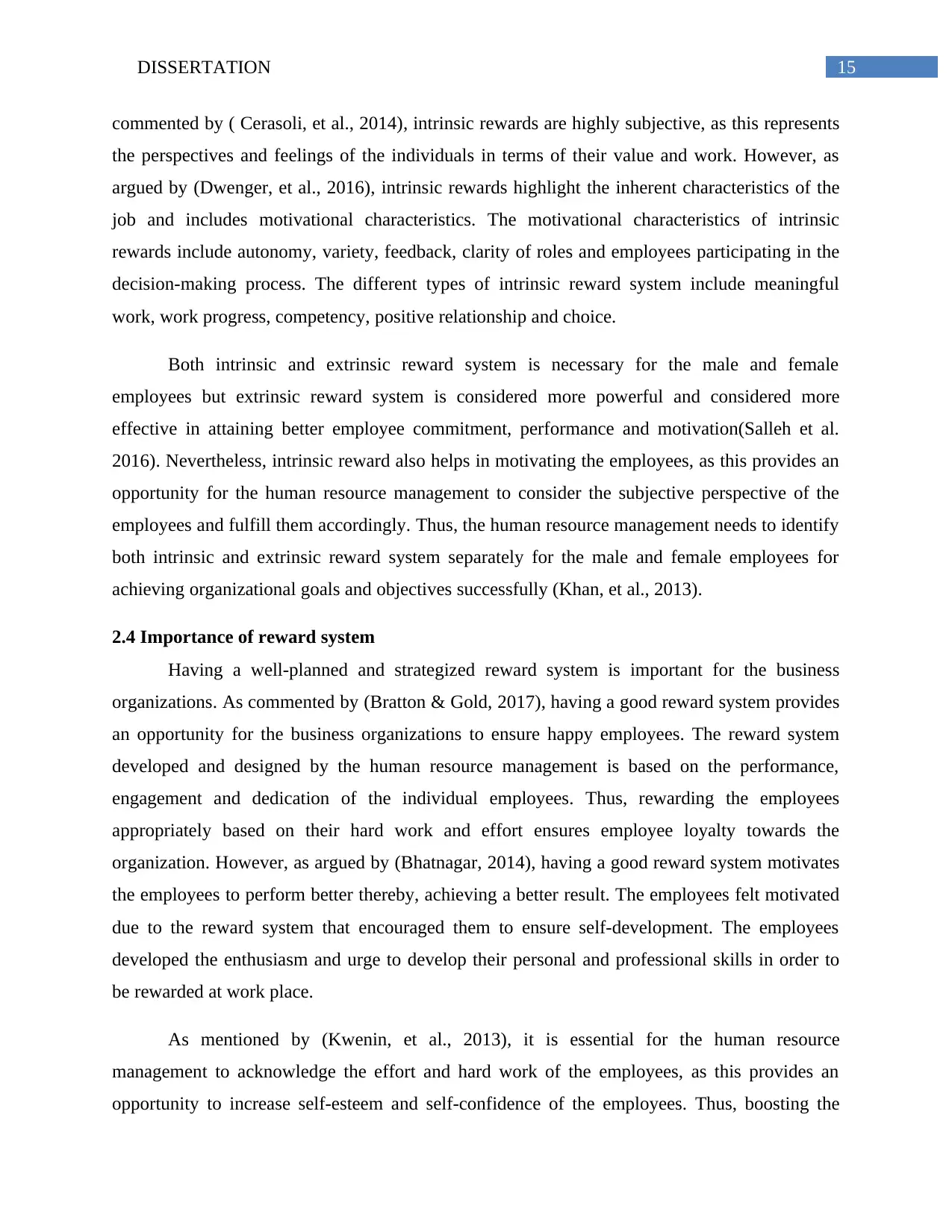
15DISSERTATION
commented by ( Cerasoli, et al., 2014), intrinsic rewards are highly subjective, as this represents
the perspectives and feelings of the individuals in terms of their value and work. However, as
argued by (Dwenger, et al., 2016), intrinsic rewards highlight the inherent characteristics of the
job and includes motivational characteristics. The motivational characteristics of intrinsic
rewards include autonomy, variety, feedback, clarity of roles and employees participating in the
decision-making process. The different types of intrinsic reward system include meaningful
work, work progress, competency, positive relationship and choice.
Both intrinsic and extrinsic reward system is necessary for the male and female
employees but extrinsic reward system is considered more powerful and considered more
effective in attaining better employee commitment, performance and motivation(Salleh et al.
2016). Nevertheless, intrinsic reward also helps in motivating the employees, as this provides an
opportunity for the human resource management to consider the subjective perspective of the
employees and fulfill them accordingly. Thus, the human resource management needs to identify
both intrinsic and extrinsic reward system separately for the male and female employees for
achieving organizational goals and objectives successfully (Khan, et al., 2013).
2.4 Importance of reward system
Having a well-planned and strategized reward system is important for the business
organizations. As commented by (Bratton & Gold, 2017), having a good reward system provides
an opportunity for the business organizations to ensure happy employees. The reward system
developed and designed by the human resource management is based on the performance,
engagement and dedication of the individual employees. Thus, rewarding the employees
appropriately based on their hard work and effort ensures employee loyalty towards the
organization. However, as argued by (Bhatnagar, 2014), having a good reward system motivates
the employees to perform better thereby, achieving a better result. The employees felt motivated
due to the reward system that encouraged them to ensure self-development. The employees
developed the enthusiasm and urge to develop their personal and professional skills in order to
be rewarded at work place.
As mentioned by (Kwenin, et al., 2013), it is essential for the human resource
management to acknowledge the effort and hard work of the employees, as this provides an
opportunity to increase self-esteem and self-confidence of the employees. Thus, boosting the
commented by ( Cerasoli, et al., 2014), intrinsic rewards are highly subjective, as this represents
the perspectives and feelings of the individuals in terms of their value and work. However, as
argued by (Dwenger, et al., 2016), intrinsic rewards highlight the inherent characteristics of the
job and includes motivational characteristics. The motivational characteristics of intrinsic
rewards include autonomy, variety, feedback, clarity of roles and employees participating in the
decision-making process. The different types of intrinsic reward system include meaningful
work, work progress, competency, positive relationship and choice.
Both intrinsic and extrinsic reward system is necessary for the male and female
employees but extrinsic reward system is considered more powerful and considered more
effective in attaining better employee commitment, performance and motivation(Salleh et al.
2016). Nevertheless, intrinsic reward also helps in motivating the employees, as this provides an
opportunity for the human resource management to consider the subjective perspective of the
employees and fulfill them accordingly. Thus, the human resource management needs to identify
both intrinsic and extrinsic reward system separately for the male and female employees for
achieving organizational goals and objectives successfully (Khan, et al., 2013).
2.4 Importance of reward system
Having a well-planned and strategized reward system is important for the business
organizations. As commented by (Bratton & Gold, 2017), having a good reward system provides
an opportunity for the business organizations to ensure happy employees. The reward system
developed and designed by the human resource management is based on the performance,
engagement and dedication of the individual employees. Thus, rewarding the employees
appropriately based on their hard work and effort ensures employee loyalty towards the
organization. However, as argued by (Bhatnagar, 2014), having a good reward system motivates
the employees to perform better thereby, achieving a better result. The employees felt motivated
due to the reward system that encouraged them to ensure self-development. The employees
developed the enthusiasm and urge to develop their personal and professional skills in order to
be rewarded at work place.
As mentioned by (Kwenin, et al., 2013), it is essential for the human resource
management to acknowledge the effort and hard work of the employees, as this provides an
opportunity to increase self-esteem and self-confidence of the employees. Thus, boosting the
Secure Best Marks with AI Grader
Need help grading? Try our AI Grader for instant feedback on your assignments.
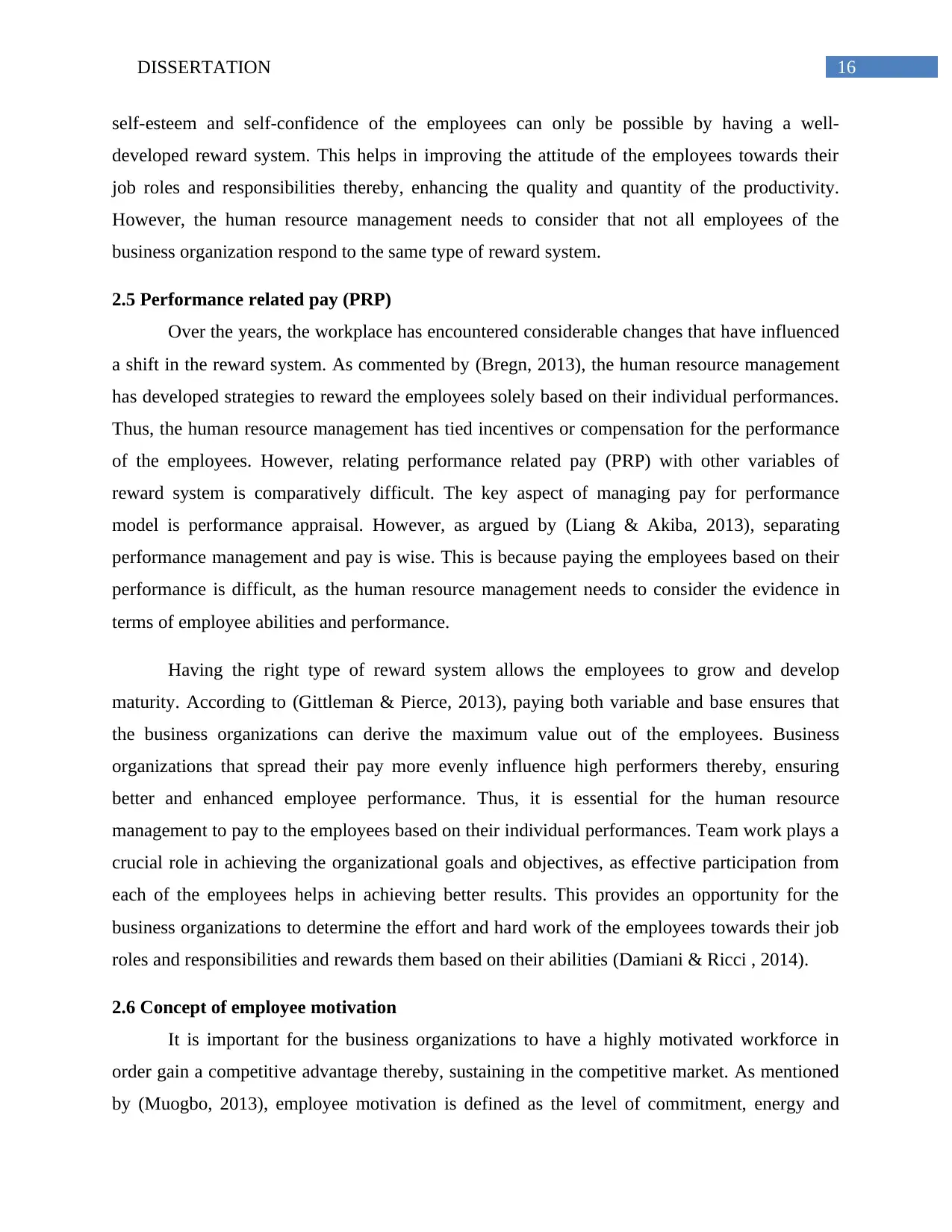
16DISSERTATION
self-esteem and self-confidence of the employees can only be possible by having a well-
developed reward system. This helps in improving the attitude of the employees towards their
job roles and responsibilities thereby, enhancing the quality and quantity of the productivity.
However, the human resource management needs to consider that not all employees of the
business organization respond to the same type of reward system.
2.5 Performance related pay (PRP)
Over the years, the workplace has encountered considerable changes that have influenced
a shift in the reward system. As commented by (Bregn, 2013), the human resource management
has developed strategies to reward the employees solely based on their individual performances.
Thus, the human resource management has tied incentives or compensation for the performance
of the employees. However, relating performance related pay (PRP) with other variables of
reward system is comparatively difficult. The key aspect of managing pay for performance
model is performance appraisal. However, as argued by (Liang & Akiba, 2013), separating
performance management and pay is wise. This is because paying the employees based on their
performance is difficult, as the human resource management needs to consider the evidence in
terms of employee abilities and performance.
Having the right type of reward system allows the employees to grow and develop
maturity. According to (Gittleman & Pierce, 2013), paying both variable and base ensures that
the business organizations can derive the maximum value out of the employees. Business
organizations that spread their pay more evenly influence high performers thereby, ensuring
better and enhanced employee performance. Thus, it is essential for the human resource
management to pay to the employees based on their individual performances. Team work plays a
crucial role in achieving the organizational goals and objectives, as effective participation from
each of the employees helps in achieving better results. This provides an opportunity for the
business organizations to determine the effort and hard work of the employees towards their job
roles and responsibilities and rewards them based on their abilities (Damiani & Ricci , 2014).
2.6 Concept of employee motivation
It is important for the business organizations to have a highly motivated workforce in
order gain a competitive advantage thereby, sustaining in the competitive market. As mentioned
by (Muogbo, 2013), employee motivation is defined as the level of commitment, energy and
self-esteem and self-confidence of the employees can only be possible by having a well-
developed reward system. This helps in improving the attitude of the employees towards their
job roles and responsibilities thereby, enhancing the quality and quantity of the productivity.
However, the human resource management needs to consider that not all employees of the
business organization respond to the same type of reward system.
2.5 Performance related pay (PRP)
Over the years, the workplace has encountered considerable changes that have influenced
a shift in the reward system. As commented by (Bregn, 2013), the human resource management
has developed strategies to reward the employees solely based on their individual performances.
Thus, the human resource management has tied incentives or compensation for the performance
of the employees. However, relating performance related pay (PRP) with other variables of
reward system is comparatively difficult. The key aspect of managing pay for performance
model is performance appraisal. However, as argued by (Liang & Akiba, 2013), separating
performance management and pay is wise. This is because paying the employees based on their
performance is difficult, as the human resource management needs to consider the evidence in
terms of employee abilities and performance.
Having the right type of reward system allows the employees to grow and develop
maturity. According to (Gittleman & Pierce, 2013), paying both variable and base ensures that
the business organizations can derive the maximum value out of the employees. Business
organizations that spread their pay more evenly influence high performers thereby, ensuring
better and enhanced employee performance. Thus, it is essential for the human resource
management to pay to the employees based on their individual performances. Team work plays a
crucial role in achieving the organizational goals and objectives, as effective participation from
each of the employees helps in achieving better results. This provides an opportunity for the
business organizations to determine the effort and hard work of the employees towards their job
roles and responsibilities and rewards them based on their abilities (Damiani & Ricci , 2014).
2.6 Concept of employee motivation
It is important for the business organizations to have a highly motivated workforce in
order gain a competitive advantage thereby, sustaining in the competitive market. As mentioned
by (Muogbo, 2013), employee motivation is defined as the level of commitment, energy and
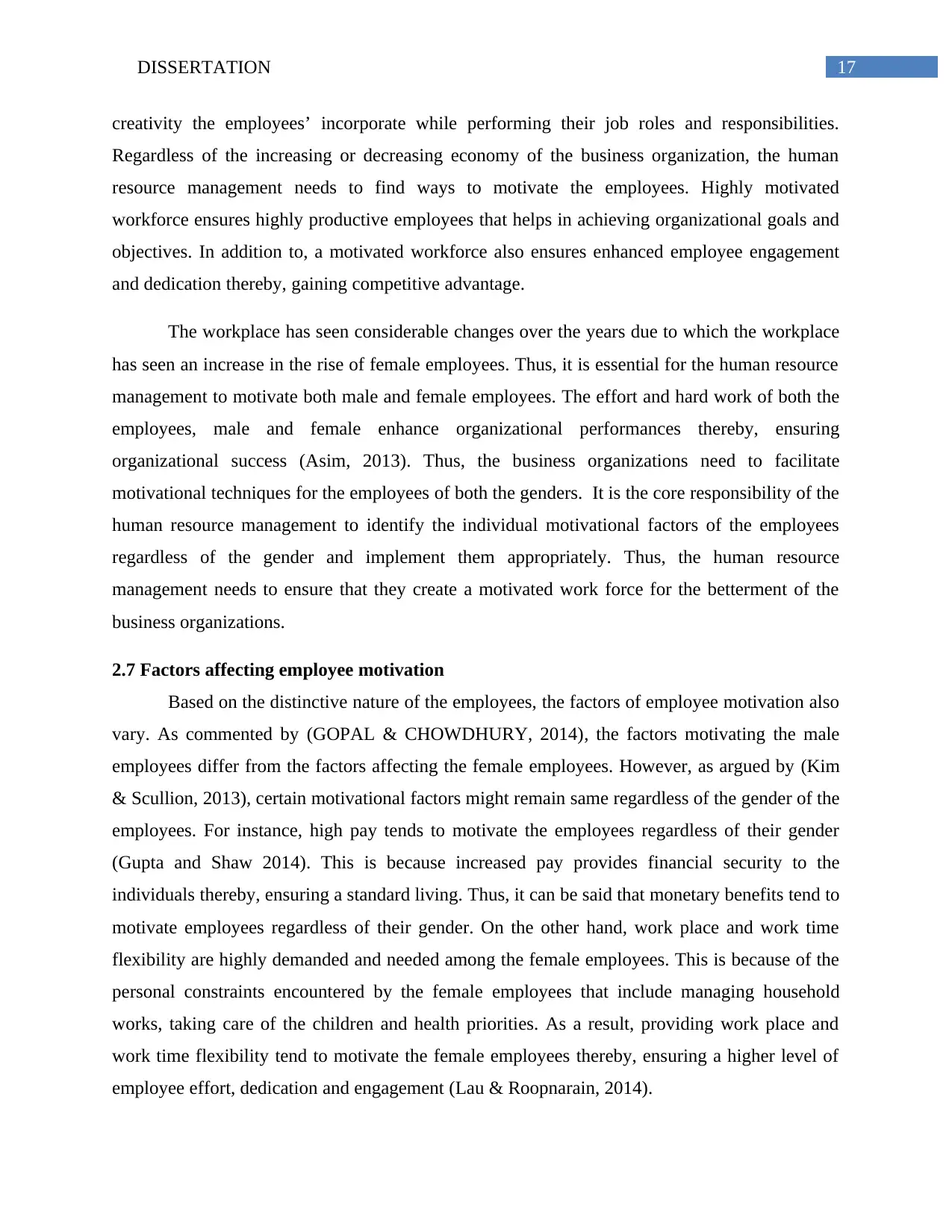
17DISSERTATION
creativity the employees’ incorporate while performing their job roles and responsibilities.
Regardless of the increasing or decreasing economy of the business organization, the human
resource management needs to find ways to motivate the employees. Highly motivated
workforce ensures highly productive employees that helps in achieving organizational goals and
objectives. In addition to, a motivated workforce also ensures enhanced employee engagement
and dedication thereby, gaining competitive advantage.
The workplace has seen considerable changes over the years due to which the workplace
has seen an increase in the rise of female employees. Thus, it is essential for the human resource
management to motivate both male and female employees. The effort and hard work of both the
employees, male and female enhance organizational performances thereby, ensuring
organizational success (Asim, 2013). Thus, the business organizations need to facilitate
motivational techniques for the employees of both the genders. It is the core responsibility of the
human resource management to identify the individual motivational factors of the employees
regardless of the gender and implement them appropriately. Thus, the human resource
management needs to ensure that they create a motivated work force for the betterment of the
business organizations.
2.7 Factors affecting employee motivation
Based on the distinctive nature of the employees, the factors of employee motivation also
vary. As commented by (GOPAL & CHOWDHURY, 2014), the factors motivating the male
employees differ from the factors affecting the female employees. However, as argued by (Kim
& Scullion, 2013), certain motivational factors might remain same regardless of the gender of the
employees. For instance, high pay tends to motivate the employees regardless of their gender
(Gupta and Shaw 2014). This is because increased pay provides financial security to the
individuals thereby, ensuring a standard living. Thus, it can be said that monetary benefits tend to
motivate employees regardless of their gender. On the other hand, work place and work time
flexibility are highly demanded and needed among the female employees. This is because of the
personal constraints encountered by the female employees that include managing household
works, taking care of the children and health priorities. As a result, providing work place and
work time flexibility tend to motivate the female employees thereby, ensuring a higher level of
employee effort, dedication and engagement (Lau & Roopnarain, 2014).
creativity the employees’ incorporate while performing their job roles and responsibilities.
Regardless of the increasing or decreasing economy of the business organization, the human
resource management needs to find ways to motivate the employees. Highly motivated
workforce ensures highly productive employees that helps in achieving organizational goals and
objectives. In addition to, a motivated workforce also ensures enhanced employee engagement
and dedication thereby, gaining competitive advantage.
The workplace has seen considerable changes over the years due to which the workplace
has seen an increase in the rise of female employees. Thus, it is essential for the human resource
management to motivate both male and female employees. The effort and hard work of both the
employees, male and female enhance organizational performances thereby, ensuring
organizational success (Asim, 2013). Thus, the business organizations need to facilitate
motivational techniques for the employees of both the genders. It is the core responsibility of the
human resource management to identify the individual motivational factors of the employees
regardless of the gender and implement them appropriately. Thus, the human resource
management needs to ensure that they create a motivated work force for the betterment of the
business organizations.
2.7 Factors affecting employee motivation
Based on the distinctive nature of the employees, the factors of employee motivation also
vary. As commented by (GOPAL & CHOWDHURY, 2014), the factors motivating the male
employees differ from the factors affecting the female employees. However, as argued by (Kim
& Scullion, 2013), certain motivational factors might remain same regardless of the gender of the
employees. For instance, high pay tends to motivate the employees regardless of their gender
(Gupta and Shaw 2014). This is because increased pay provides financial security to the
individuals thereby, ensuring a standard living. Thus, it can be said that monetary benefits tend to
motivate employees regardless of their gender. On the other hand, work place and work time
flexibility are highly demanded and needed among the female employees. This is because of the
personal constraints encountered by the female employees that include managing household
works, taking care of the children and health priorities. As a result, providing work place and
work time flexibility tend to motivate the female employees thereby, ensuring a higher level of
employee effort, dedication and engagement (Lau & Roopnarain, 2014).
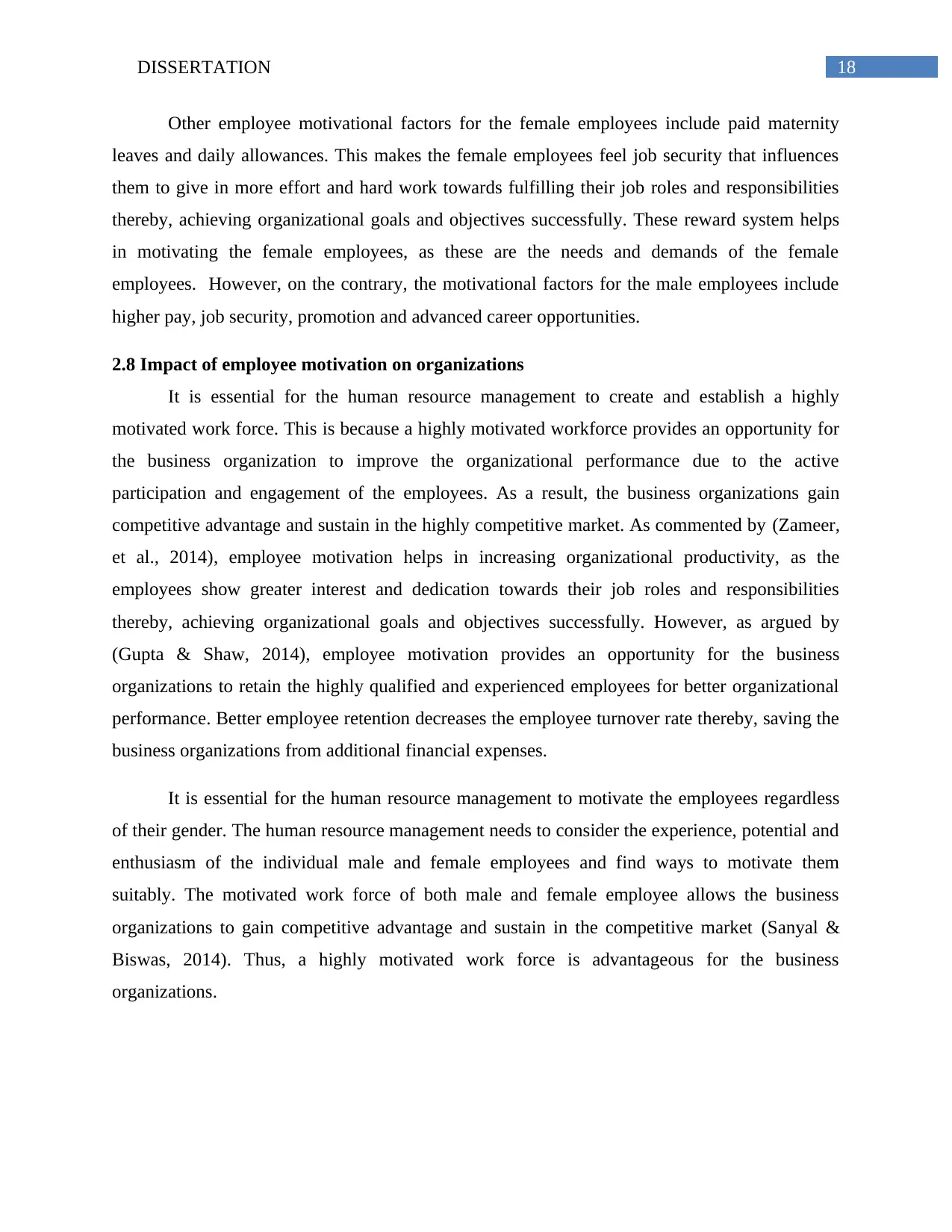
18DISSERTATION
Other employee motivational factors for the female employees include paid maternity
leaves and daily allowances. This makes the female employees feel job security that influences
them to give in more effort and hard work towards fulfilling their job roles and responsibilities
thereby, achieving organizational goals and objectives successfully. These reward system helps
in motivating the female employees, as these are the needs and demands of the female
employees. However, on the contrary, the motivational factors for the male employees include
higher pay, job security, promotion and advanced career opportunities.
2.8 Impact of employee motivation on organizations
It is essential for the human resource management to create and establish a highly
motivated work force. This is because a highly motivated workforce provides an opportunity for
the business organization to improve the organizational performance due to the active
participation and engagement of the employees. As a result, the business organizations gain
competitive advantage and sustain in the highly competitive market. As commented by (Zameer,
et al., 2014), employee motivation helps in increasing organizational productivity, as the
employees show greater interest and dedication towards their job roles and responsibilities
thereby, achieving organizational goals and objectives successfully. However, as argued by
(Gupta & Shaw, 2014), employee motivation provides an opportunity for the business
organizations to retain the highly qualified and experienced employees for better organizational
performance. Better employee retention decreases the employee turnover rate thereby, saving the
business organizations from additional financial expenses.
It is essential for the human resource management to motivate the employees regardless
of their gender. The human resource management needs to consider the experience, potential and
enthusiasm of the individual male and female employees and find ways to motivate them
suitably. The motivated work force of both male and female employee allows the business
organizations to gain competitive advantage and sustain in the competitive market (Sanyal &
Biswas, 2014). Thus, a highly motivated work force is advantageous for the business
organizations.
Other employee motivational factors for the female employees include paid maternity
leaves and daily allowances. This makes the female employees feel job security that influences
them to give in more effort and hard work towards fulfilling their job roles and responsibilities
thereby, achieving organizational goals and objectives successfully. These reward system helps
in motivating the female employees, as these are the needs and demands of the female
employees. However, on the contrary, the motivational factors for the male employees include
higher pay, job security, promotion and advanced career opportunities.
2.8 Impact of employee motivation on organizations
It is essential for the human resource management to create and establish a highly
motivated work force. This is because a highly motivated workforce provides an opportunity for
the business organization to improve the organizational performance due to the active
participation and engagement of the employees. As a result, the business organizations gain
competitive advantage and sustain in the highly competitive market. As commented by (Zameer,
et al., 2014), employee motivation helps in increasing organizational productivity, as the
employees show greater interest and dedication towards their job roles and responsibilities
thereby, achieving organizational goals and objectives successfully. However, as argued by
(Gupta & Shaw, 2014), employee motivation provides an opportunity for the business
organizations to retain the highly qualified and experienced employees for better organizational
performance. Better employee retention decreases the employee turnover rate thereby, saving the
business organizations from additional financial expenses.
It is essential for the human resource management to motivate the employees regardless
of their gender. The human resource management needs to consider the experience, potential and
enthusiasm of the individual male and female employees and find ways to motivate them
suitably. The motivated work force of both male and female employee allows the business
organizations to gain competitive advantage and sustain in the competitive market (Sanyal &
Biswas, 2014). Thus, a highly motivated work force is advantageous for the business
organizations.
Paraphrase This Document
Need a fresh take? Get an instant paraphrase of this document with our AI Paraphraser
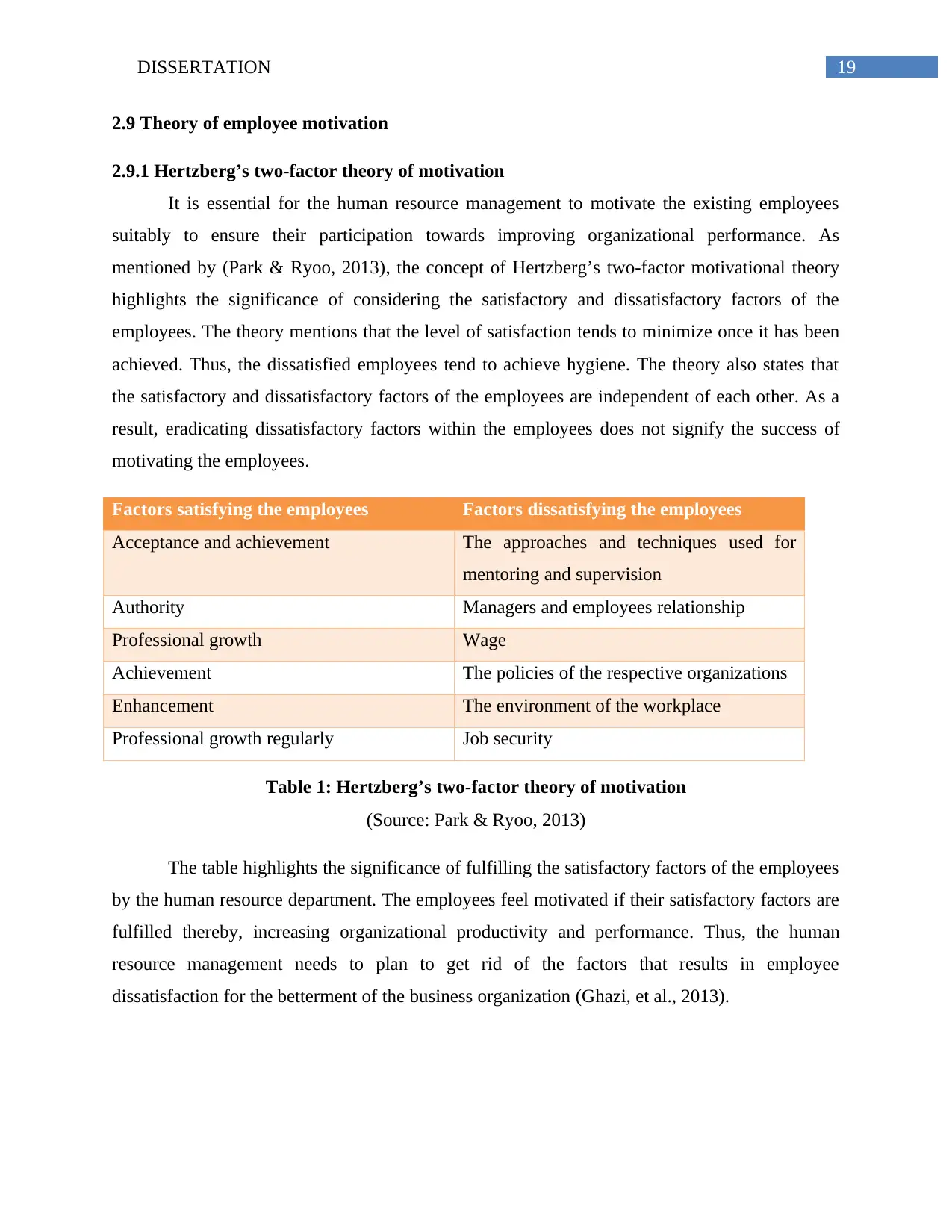
19DISSERTATION
2.9 Theory of employee motivation
2.9.1 Hertzberg’s two-factor theory of motivation
It is essential for the human resource management to motivate the existing employees
suitably to ensure their participation towards improving organizational performance. As
mentioned by (Park & Ryoo, 2013), the concept of Hertzberg’s two-factor motivational theory
highlights the significance of considering the satisfactory and dissatisfactory factors of the
employees. The theory mentions that the level of satisfaction tends to minimize once it has been
achieved. Thus, the dissatisfied employees tend to achieve hygiene. The theory also states that
the satisfactory and dissatisfactory factors of the employees are independent of each other. As a
result, eradicating dissatisfactory factors within the employees does not signify the success of
motivating the employees.
Factors satisfying the employees Factors dissatisfying the employees
Acceptance and achievement The approaches and techniques used for
mentoring and supervision
Authority Managers and employees relationship
Professional growth Wage
Achievement The policies of the respective organizations
Enhancement The environment of the workplace
Professional growth regularly Job security
Table 1: Hertzberg’s two-factor theory of motivation
(Source: Park & Ryoo, 2013)
The table highlights the significance of fulfilling the satisfactory factors of the employees
by the human resource department. The employees feel motivated if their satisfactory factors are
fulfilled thereby, increasing organizational productivity and performance. Thus, the human
resource management needs to plan to get rid of the factors that results in employee
dissatisfaction for the betterment of the business organization (Ghazi, et al., 2013).
2.9 Theory of employee motivation
2.9.1 Hertzberg’s two-factor theory of motivation
It is essential for the human resource management to motivate the existing employees
suitably to ensure their participation towards improving organizational performance. As
mentioned by (Park & Ryoo, 2013), the concept of Hertzberg’s two-factor motivational theory
highlights the significance of considering the satisfactory and dissatisfactory factors of the
employees. The theory mentions that the level of satisfaction tends to minimize once it has been
achieved. Thus, the dissatisfied employees tend to achieve hygiene. The theory also states that
the satisfactory and dissatisfactory factors of the employees are independent of each other. As a
result, eradicating dissatisfactory factors within the employees does not signify the success of
motivating the employees.
Factors satisfying the employees Factors dissatisfying the employees
Acceptance and achievement The approaches and techniques used for
mentoring and supervision
Authority Managers and employees relationship
Professional growth Wage
Achievement The policies of the respective organizations
Enhancement The environment of the workplace
Professional growth regularly Job security
Table 1: Hertzberg’s two-factor theory of motivation
(Source: Park & Ryoo, 2013)
The table highlights the significance of fulfilling the satisfactory factors of the employees
by the human resource department. The employees feel motivated if their satisfactory factors are
fulfilled thereby, increasing organizational productivity and performance. Thus, the human
resource management needs to plan to get rid of the factors that results in employee
dissatisfaction for the betterment of the business organization (Ghazi, et al., 2013).
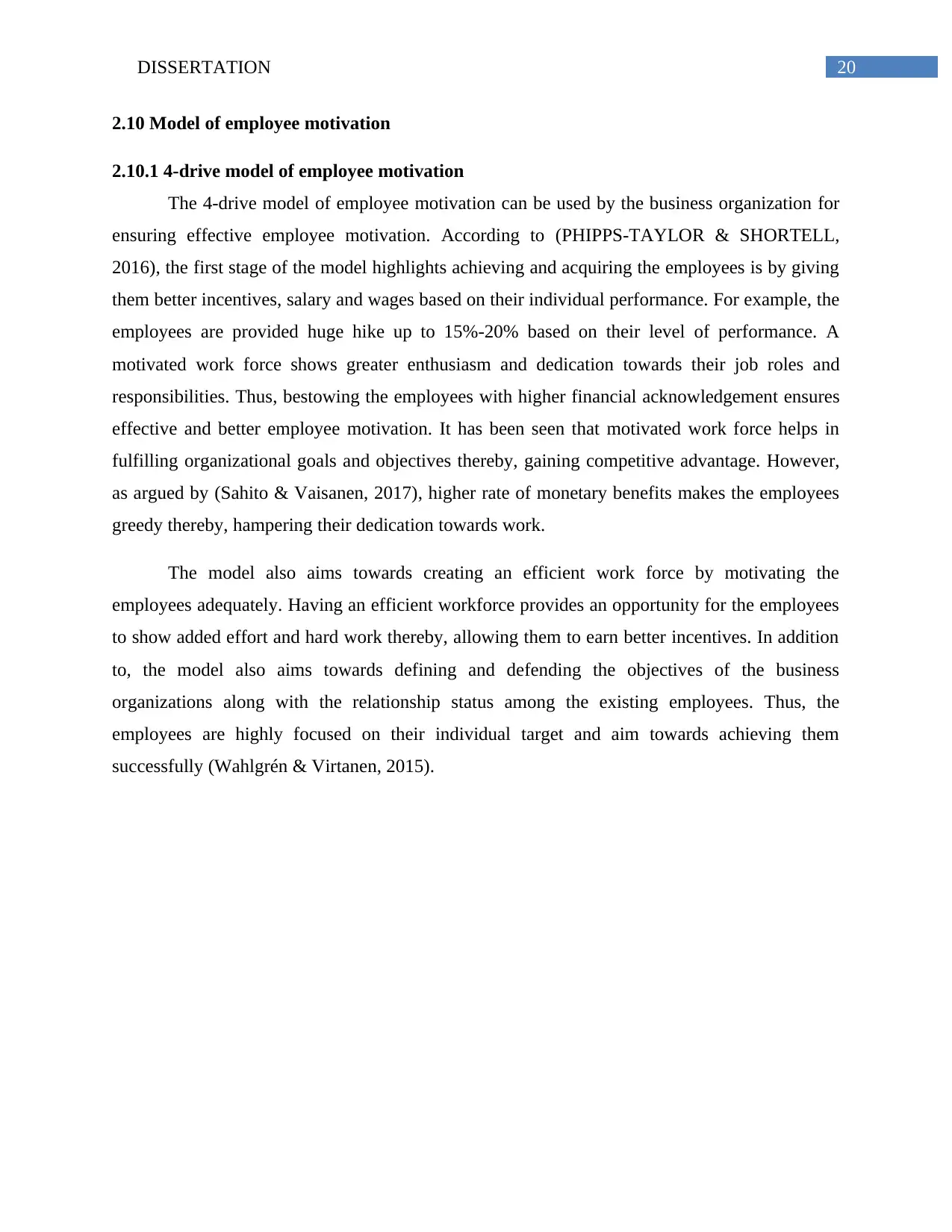
20DISSERTATION
2.10 Model of employee motivation
2.10.1 4-drive model of employee motivation
The 4-drive model of employee motivation can be used by the business organization for
ensuring effective employee motivation. According to (PHIPPS-TAYLOR & SHORTELL,
2016), the first stage of the model highlights achieving and acquiring the employees is by giving
them better incentives, salary and wages based on their individual performance. For example, the
employees are provided huge hike up to 15%-20% based on their level of performance. A
motivated work force shows greater enthusiasm and dedication towards their job roles and
responsibilities. Thus, bestowing the employees with higher financial acknowledgement ensures
effective and better employee motivation. It has been seen that motivated work force helps in
fulfilling organizational goals and objectives thereby, gaining competitive advantage. However,
as argued by (Sahito & Vaisanen, 2017), higher rate of monetary benefits makes the employees
greedy thereby, hampering their dedication towards work.
The model also aims towards creating an efficient work force by motivating the
employees adequately. Having an efficient workforce provides an opportunity for the employees
to show added effort and hard work thereby, allowing them to earn better incentives. In addition
to, the model also aims towards defining and defending the objectives of the business
organizations along with the relationship status among the existing employees. Thus, the
employees are highly focused on their individual target and aim towards achieving them
successfully (Wahlgrén & Virtanen, 2015).
2.10 Model of employee motivation
2.10.1 4-drive model of employee motivation
The 4-drive model of employee motivation can be used by the business organization for
ensuring effective employee motivation. According to (PHIPPS-TAYLOR & SHORTELL,
2016), the first stage of the model highlights achieving and acquiring the employees is by giving
them better incentives, salary and wages based on their individual performance. For example, the
employees are provided huge hike up to 15%-20% based on their level of performance. A
motivated work force shows greater enthusiasm and dedication towards their job roles and
responsibilities. Thus, bestowing the employees with higher financial acknowledgement ensures
effective and better employee motivation. It has been seen that motivated work force helps in
fulfilling organizational goals and objectives thereby, gaining competitive advantage. However,
as argued by (Sahito & Vaisanen, 2017), higher rate of monetary benefits makes the employees
greedy thereby, hampering their dedication towards work.
The model also aims towards creating an efficient work force by motivating the
employees adequately. Having an efficient workforce provides an opportunity for the employees
to show added effort and hard work thereby, allowing them to earn better incentives. In addition
to, the model also aims towards defining and defending the objectives of the business
organizations along with the relationship status among the existing employees. Thus, the
employees are highly focused on their individual target and aim towards achieving them
successfully (Wahlgrén & Virtanen, 2015).
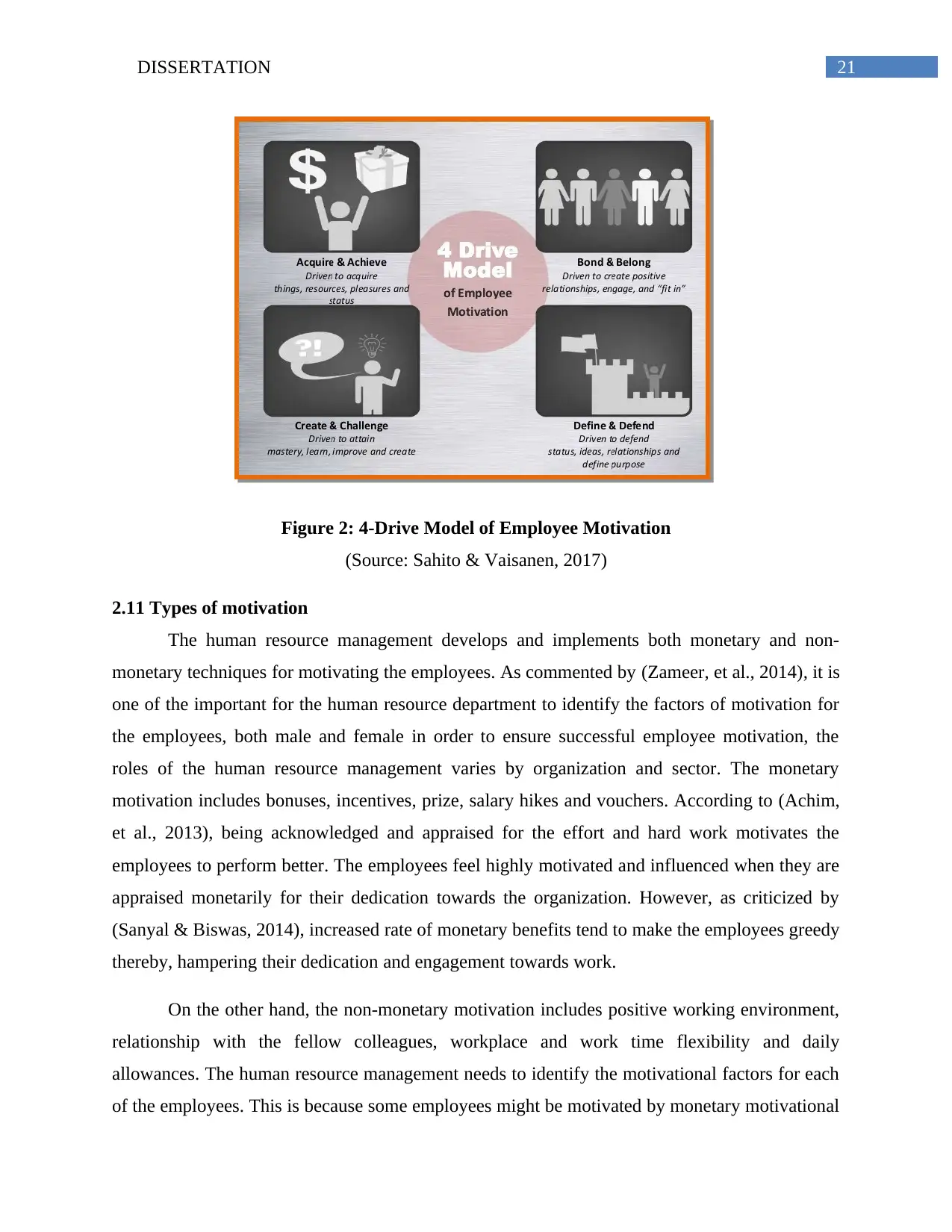
21DISSERTATION
Figure 2: 4-Drive Model of Employee Motivation
(Source: Sahito & Vaisanen, 2017)
2.11 Types of motivation
The human resource management develops and implements both monetary and non-
monetary techniques for motivating the employees. As commented by (Zameer, et al., 2014), it is
one of the important for the human resource department to identify the factors of motivation for
the employees, both male and female in order to ensure successful employee motivation, the
roles of the human resource management varies by organization and sector. The monetary
motivation includes bonuses, incentives, prize, salary hikes and vouchers. According to (Achim,
et al., 2013), being acknowledged and appraised for the effort and hard work motivates the
employees to perform better. The employees feel highly motivated and influenced when they are
appraised monetarily for their dedication towards the organization. However, as criticized by
(Sanyal & Biswas, 2014), increased rate of monetary benefits tend to make the employees greedy
thereby, hampering their dedication and engagement towards work.
On the other hand, the non-monetary motivation includes positive working environment,
relationship with the fellow colleagues, workplace and work time flexibility and daily
allowances. The human resource management needs to identify the motivational factors for each
of the employees. This is because some employees might be motivated by monetary motivational
Figure 2: 4-Drive Model of Employee Motivation
(Source: Sahito & Vaisanen, 2017)
2.11 Types of motivation
The human resource management develops and implements both monetary and non-
monetary techniques for motivating the employees. As commented by (Zameer, et al., 2014), it is
one of the important for the human resource department to identify the factors of motivation for
the employees, both male and female in order to ensure successful employee motivation, the
roles of the human resource management varies by organization and sector. The monetary
motivation includes bonuses, incentives, prize, salary hikes and vouchers. According to (Achim,
et al., 2013), being acknowledged and appraised for the effort and hard work motivates the
employees to perform better. The employees feel highly motivated and influenced when they are
appraised monetarily for their dedication towards the organization. However, as criticized by
(Sanyal & Biswas, 2014), increased rate of monetary benefits tend to make the employees greedy
thereby, hampering their dedication and engagement towards work.
On the other hand, the non-monetary motivation includes positive working environment,
relationship with the fellow colleagues, workplace and work time flexibility and daily
allowances. The human resource management needs to identify the motivational factors for each
of the employees. This is because some employees might be motivated by monetary motivational
Secure Best Marks with AI Grader
Need help grading? Try our AI Grader for instant feedback on your assignments.
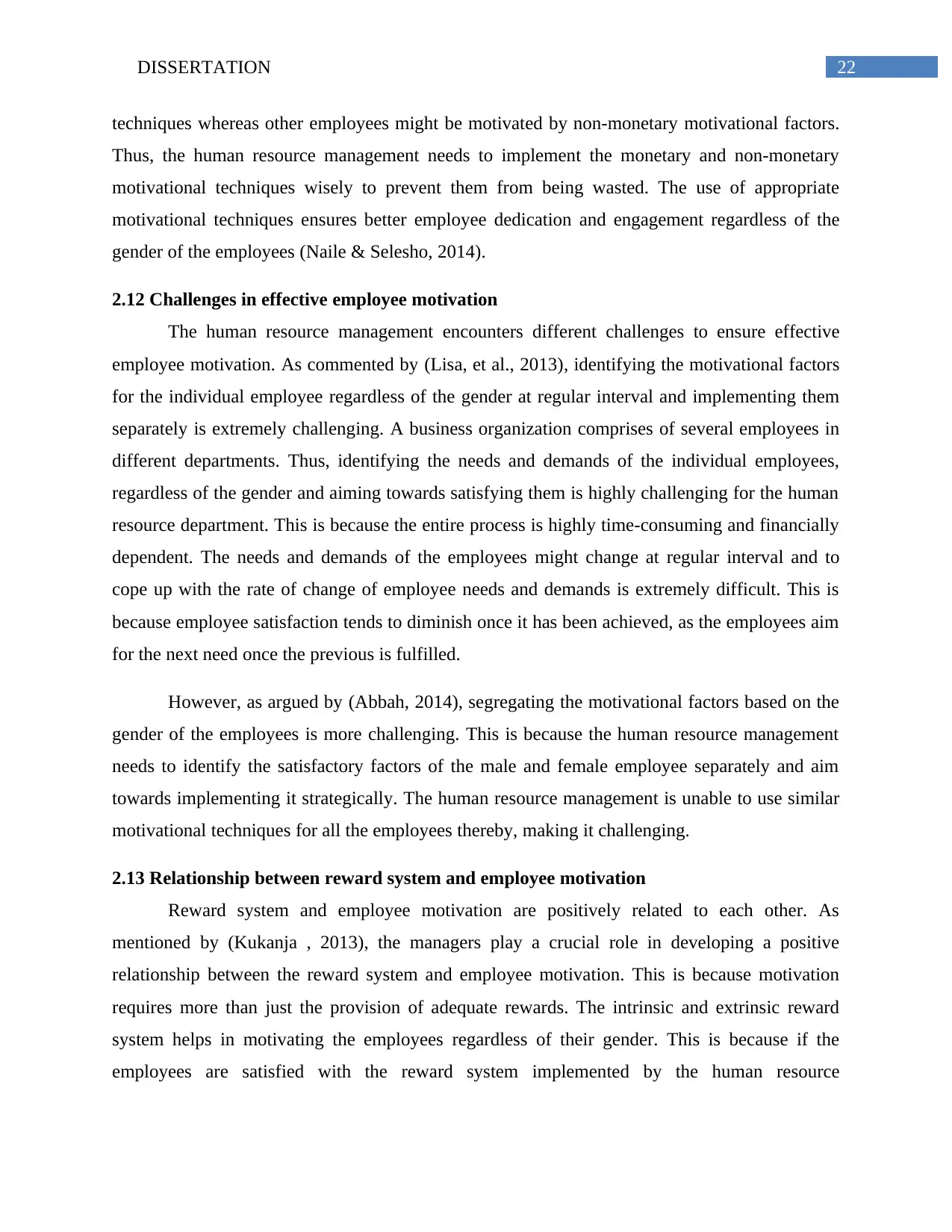
22DISSERTATION
techniques whereas other employees might be motivated by non-monetary motivational factors.
Thus, the human resource management needs to implement the monetary and non-monetary
motivational techniques wisely to prevent them from being wasted. The use of appropriate
motivational techniques ensures better employee dedication and engagement regardless of the
gender of the employees (Naile & Selesho, 2014).
2.12 Challenges in effective employee motivation
The human resource management encounters different challenges to ensure effective
employee motivation. As commented by (Lisa, et al., 2013), identifying the motivational factors
for the individual employee regardless of the gender at regular interval and implementing them
separately is extremely challenging. A business organization comprises of several employees in
different departments. Thus, identifying the needs and demands of the individual employees,
regardless of the gender and aiming towards satisfying them is highly challenging for the human
resource department. This is because the entire process is highly time-consuming and financially
dependent. The needs and demands of the employees might change at regular interval and to
cope up with the rate of change of employee needs and demands is extremely difficult. This is
because employee satisfaction tends to diminish once it has been achieved, as the employees aim
for the next need once the previous is fulfilled.
However, as argued by (Abbah, 2014), segregating the motivational factors based on the
gender of the employees is more challenging. This is because the human resource management
needs to identify the satisfactory factors of the male and female employee separately and aim
towards implementing it strategically. The human resource management is unable to use similar
motivational techniques for all the employees thereby, making it challenging.
2.13 Relationship between reward system and employee motivation
Reward system and employee motivation are positively related to each other. As
mentioned by (Kukanja , 2013), the managers play a crucial role in developing a positive
relationship between the reward system and employee motivation. This is because motivation
requires more than just the provision of adequate rewards. The intrinsic and extrinsic reward
system helps in motivating the employees regardless of their gender. This is because if the
employees are satisfied with the reward system implemented by the human resource
techniques whereas other employees might be motivated by non-monetary motivational factors.
Thus, the human resource management needs to implement the monetary and non-monetary
motivational techniques wisely to prevent them from being wasted. The use of appropriate
motivational techniques ensures better employee dedication and engagement regardless of the
gender of the employees (Naile & Selesho, 2014).
2.12 Challenges in effective employee motivation
The human resource management encounters different challenges to ensure effective
employee motivation. As commented by (Lisa, et al., 2013), identifying the motivational factors
for the individual employee regardless of the gender at regular interval and implementing them
separately is extremely challenging. A business organization comprises of several employees in
different departments. Thus, identifying the needs and demands of the individual employees,
regardless of the gender and aiming towards satisfying them is highly challenging for the human
resource department. This is because the entire process is highly time-consuming and financially
dependent. The needs and demands of the employees might change at regular interval and to
cope up with the rate of change of employee needs and demands is extremely difficult. This is
because employee satisfaction tends to diminish once it has been achieved, as the employees aim
for the next need once the previous is fulfilled.
However, as argued by (Abbah, 2014), segregating the motivational factors based on the
gender of the employees is more challenging. This is because the human resource management
needs to identify the satisfactory factors of the male and female employee separately and aim
towards implementing it strategically. The human resource management is unable to use similar
motivational techniques for all the employees thereby, making it challenging.
2.13 Relationship between reward system and employee motivation
Reward system and employee motivation are positively related to each other. As
mentioned by (Kukanja , 2013), the managers play a crucial role in developing a positive
relationship between the reward system and employee motivation. This is because motivation
requires more than just the provision of adequate rewards. The intrinsic and extrinsic reward
system helps in motivating the employees regardless of their gender. This is because if the
employees are satisfied with the reward system implemented by the human resource
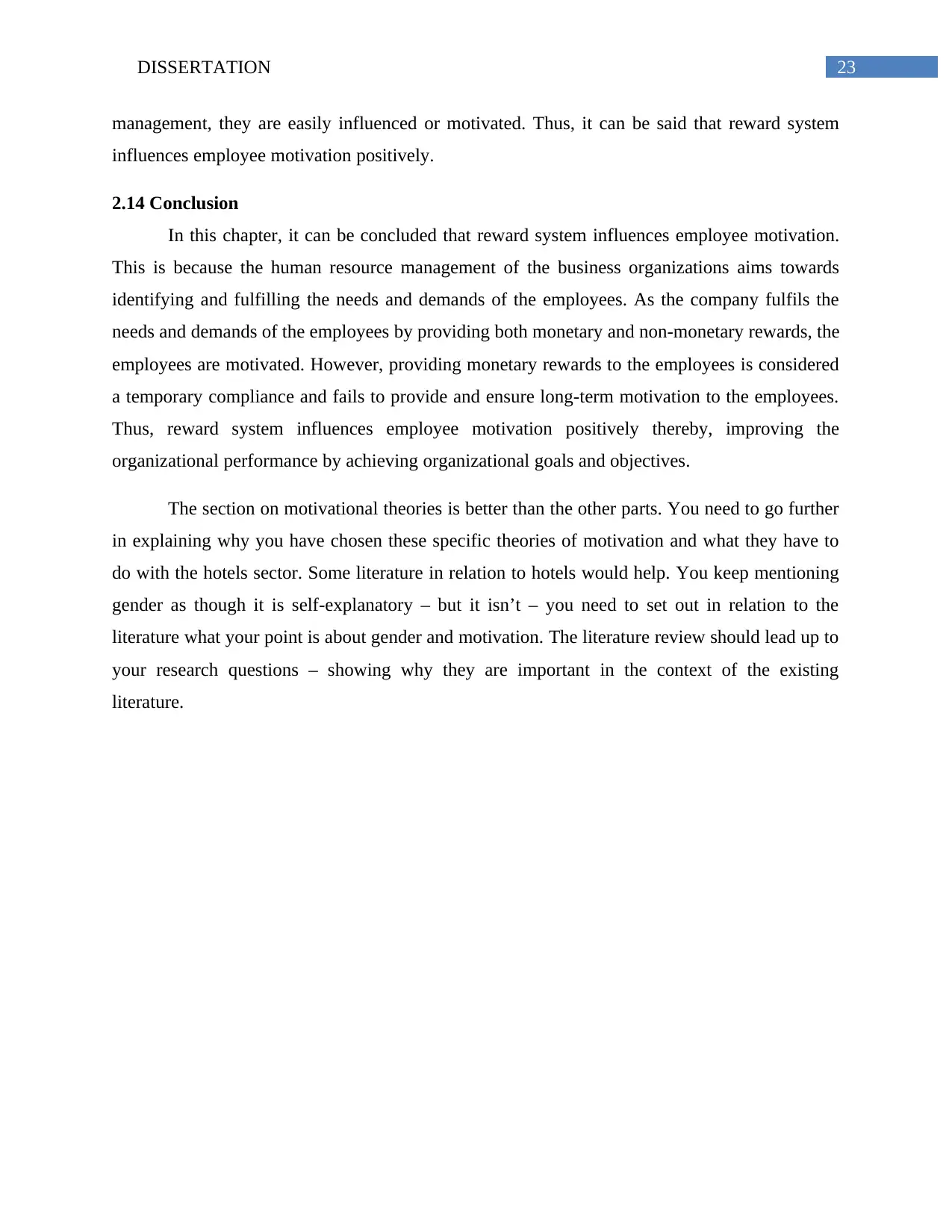
23DISSERTATION
management, they are easily influenced or motivated. Thus, it can be said that reward system
influences employee motivation positively.
2.14 Conclusion
In this chapter, it can be concluded that reward system influences employee motivation.
This is because the human resource management of the business organizations aims towards
identifying and fulfilling the needs and demands of the employees. As the company fulfils the
needs and demands of the employees by providing both monetary and non-monetary rewards, the
employees are motivated. However, providing monetary rewards to the employees is considered
a temporary compliance and fails to provide and ensure long-term motivation to the employees.
Thus, reward system influences employee motivation positively thereby, improving the
organizational performance by achieving organizational goals and objectives.
The section on motivational theories is better than the other parts. You need to go further
in explaining why you have chosen these specific theories of motivation and what they have to
do with the hotels sector. Some literature in relation to hotels would help. You keep mentioning
gender as though it is self-explanatory – but it isn’t – you need to set out in relation to the
literature what your point is about gender and motivation. The literature review should lead up to
your research questions – showing why they are important in the context of the existing
literature.
management, they are easily influenced or motivated. Thus, it can be said that reward system
influences employee motivation positively.
2.14 Conclusion
In this chapter, it can be concluded that reward system influences employee motivation.
This is because the human resource management of the business organizations aims towards
identifying and fulfilling the needs and demands of the employees. As the company fulfils the
needs and demands of the employees by providing both monetary and non-monetary rewards, the
employees are motivated. However, providing monetary rewards to the employees is considered
a temporary compliance and fails to provide and ensure long-term motivation to the employees.
Thus, reward system influences employee motivation positively thereby, improving the
organizational performance by achieving organizational goals and objectives.
The section on motivational theories is better than the other parts. You need to go further
in explaining why you have chosen these specific theories of motivation and what they have to
do with the hotels sector. Some literature in relation to hotels would help. You keep mentioning
gender as though it is self-explanatory – but it isn’t – you need to set out in relation to the
literature what your point is about gender and motivation. The literature review should lead up to
your research questions – showing why they are important in the context of the existing
literature.
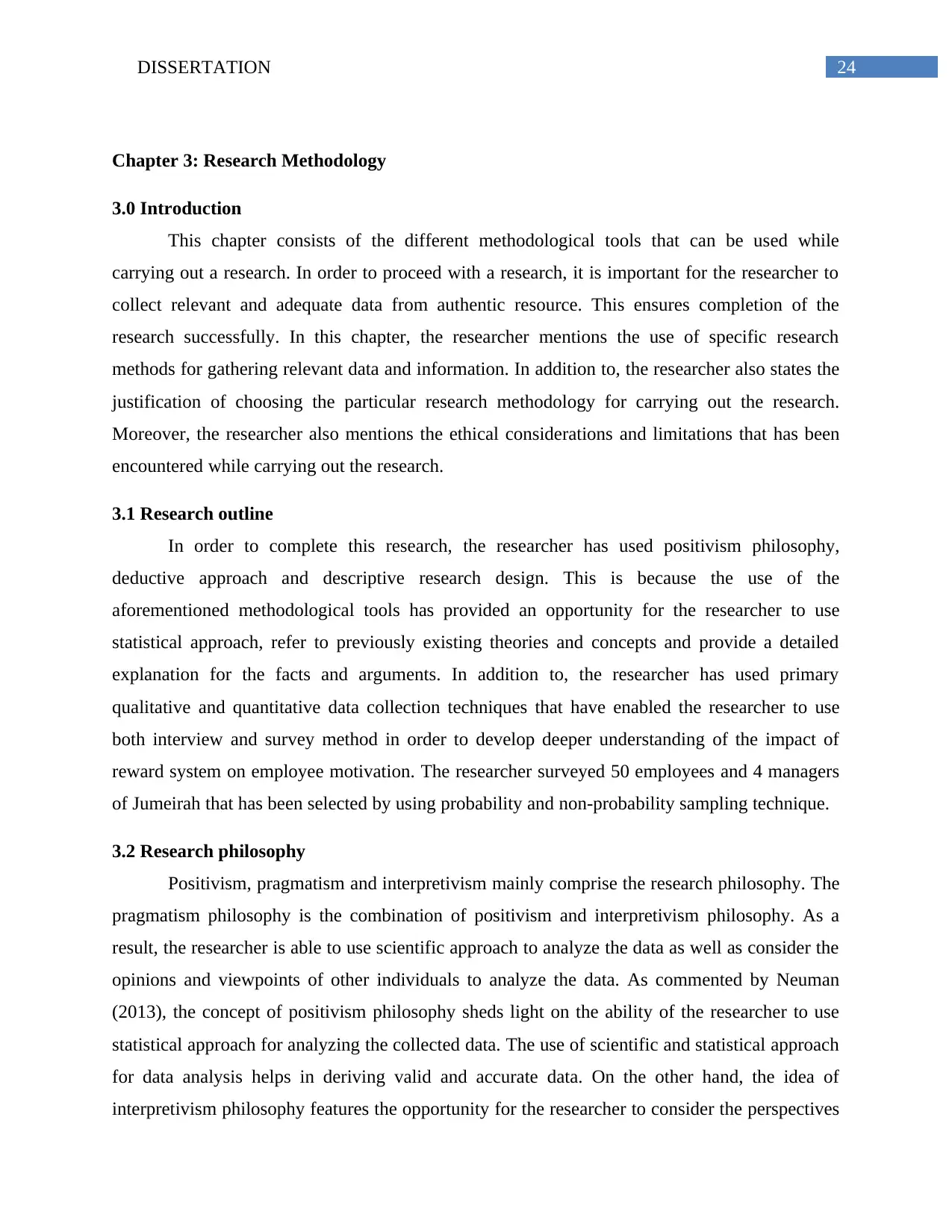
24DISSERTATION
Chapter 3: Research Methodology
3.0 Introduction
This chapter consists of the different methodological tools that can be used while
carrying out a research. In order to proceed with a research, it is important for the researcher to
collect relevant and adequate data from authentic resource. This ensures completion of the
research successfully. In this chapter, the researcher mentions the use of specific research
methods for gathering relevant data and information. In addition to, the researcher also states the
justification of choosing the particular research methodology for carrying out the research.
Moreover, the researcher also mentions the ethical considerations and limitations that has been
encountered while carrying out the research.
3.1 Research outline
In order to complete this research, the researcher has used positivism philosophy,
deductive approach and descriptive research design. This is because the use of the
aforementioned methodological tools has provided an opportunity for the researcher to use
statistical approach, refer to previously existing theories and concepts and provide a detailed
explanation for the facts and arguments. In addition to, the researcher has used primary
qualitative and quantitative data collection techniques that have enabled the researcher to use
both interview and survey method in order to develop deeper understanding of the impact of
reward system on employee motivation. The researcher surveyed 50 employees and 4 managers
of Jumeirah that has been selected by using probability and non-probability sampling technique.
3.2 Research philosophy
Positivism, pragmatism and interpretivism mainly comprise the research philosophy. The
pragmatism philosophy is the combination of positivism and interpretivism philosophy. As a
result, the researcher is able to use scientific approach to analyze the data as well as consider the
opinions and viewpoints of other individuals to analyze the data. As commented by Neuman
(2013), the concept of positivism philosophy sheds light on the ability of the researcher to use
statistical approach for analyzing the collected data. The use of scientific and statistical approach
for data analysis helps in deriving valid and accurate data. On the other hand, the idea of
interpretivism philosophy features the opportunity for the researcher to consider the perspectives
Chapter 3: Research Methodology
3.0 Introduction
This chapter consists of the different methodological tools that can be used while
carrying out a research. In order to proceed with a research, it is important for the researcher to
collect relevant and adequate data from authentic resource. This ensures completion of the
research successfully. In this chapter, the researcher mentions the use of specific research
methods for gathering relevant data and information. In addition to, the researcher also states the
justification of choosing the particular research methodology for carrying out the research.
Moreover, the researcher also mentions the ethical considerations and limitations that has been
encountered while carrying out the research.
3.1 Research outline
In order to complete this research, the researcher has used positivism philosophy,
deductive approach and descriptive research design. This is because the use of the
aforementioned methodological tools has provided an opportunity for the researcher to use
statistical approach, refer to previously existing theories and concepts and provide a detailed
explanation for the facts and arguments. In addition to, the researcher has used primary
qualitative and quantitative data collection techniques that have enabled the researcher to use
both interview and survey method in order to develop deeper understanding of the impact of
reward system on employee motivation. The researcher surveyed 50 employees and 4 managers
of Jumeirah that has been selected by using probability and non-probability sampling technique.
3.2 Research philosophy
Positivism, pragmatism and interpretivism mainly comprise the research philosophy. The
pragmatism philosophy is the combination of positivism and interpretivism philosophy. As a
result, the researcher is able to use scientific approach to analyze the data as well as consider the
opinions and viewpoints of other individuals to analyze the data. As commented by Neuman
(2013), the concept of positivism philosophy sheds light on the ability of the researcher to use
statistical approach for analyzing the collected data. The use of scientific and statistical approach
for data analysis helps in deriving valid and accurate data. On the other hand, the idea of
interpretivism philosophy features the opportunity for the researcher to consider the perspectives
Paraphrase This Document
Need a fresh take? Get an instant paraphrase of this document with our AI Paraphraser
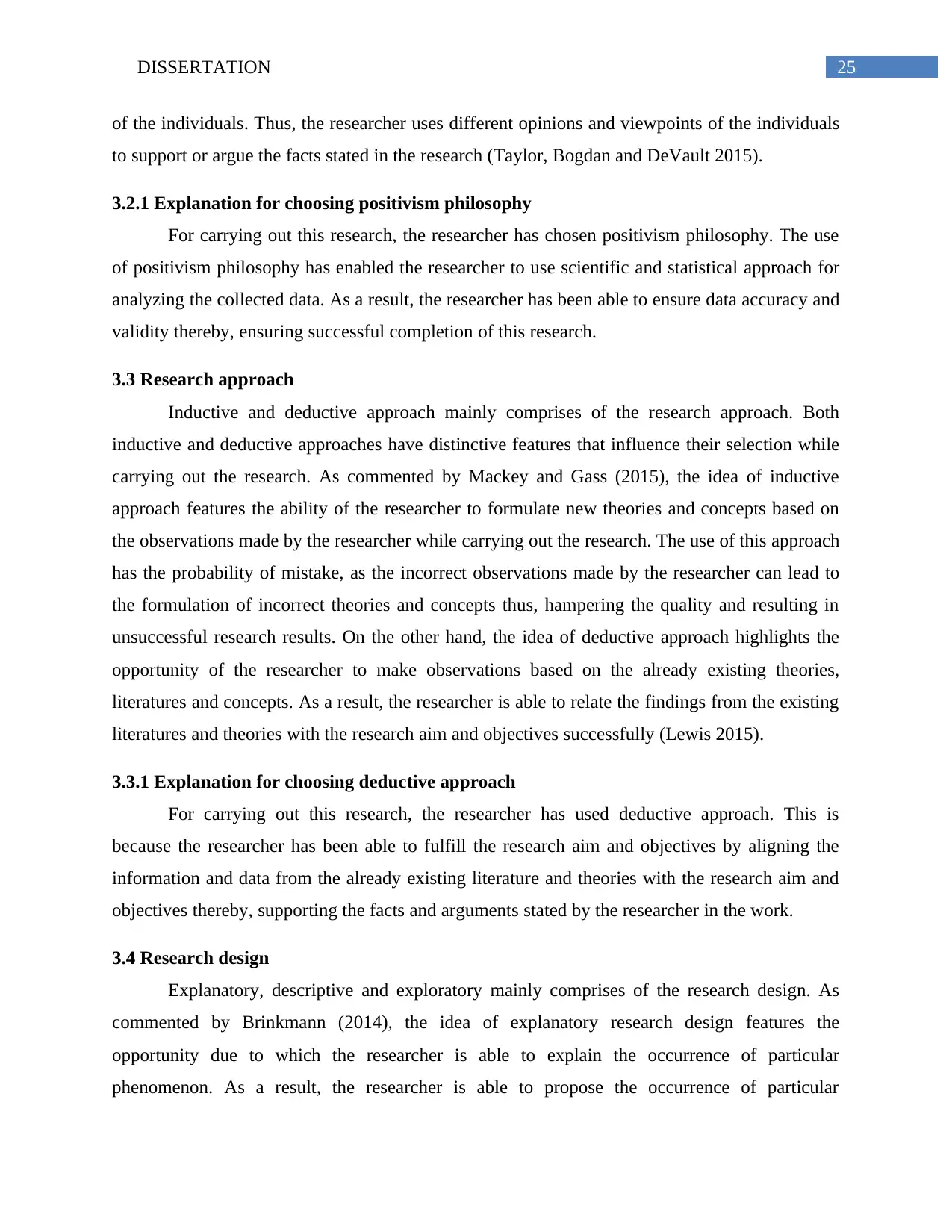
25DISSERTATION
of the individuals. Thus, the researcher uses different opinions and viewpoints of the individuals
to support or argue the facts stated in the research (Taylor, Bogdan and DeVault 2015).
3.2.1 Explanation for choosing positivism philosophy
For carrying out this research, the researcher has chosen positivism philosophy. The use
of positivism philosophy has enabled the researcher to use scientific and statistical approach for
analyzing the collected data. As a result, the researcher has been able to ensure data accuracy and
validity thereby, ensuring successful completion of this research.
3.3 Research approach
Inductive and deductive approach mainly comprises of the research approach. Both
inductive and deductive approaches have distinctive features that influence their selection while
carrying out the research. As commented by Mackey and Gass (2015), the idea of inductive
approach features the ability of the researcher to formulate new theories and concepts based on
the observations made by the researcher while carrying out the research. The use of this approach
has the probability of mistake, as the incorrect observations made by the researcher can lead to
the formulation of incorrect theories and concepts thus, hampering the quality and resulting in
unsuccessful research results. On the other hand, the idea of deductive approach highlights the
opportunity of the researcher to make observations based on the already existing theories,
literatures and concepts. As a result, the researcher is able to relate the findings from the existing
literatures and theories with the research aim and objectives successfully (Lewis 2015).
3.3.1 Explanation for choosing deductive approach
For carrying out this research, the researcher has used deductive approach. This is
because the researcher has been able to fulfill the research aim and objectives by aligning the
information and data from the already existing literature and theories with the research aim and
objectives thereby, supporting the facts and arguments stated by the researcher in the work.
3.4 Research design
Explanatory, descriptive and exploratory mainly comprises of the research design. As
commented by Brinkmann (2014), the idea of explanatory research design features the
opportunity due to which the researcher is able to explain the occurrence of particular
phenomenon. As a result, the researcher is able to propose the occurrence of particular
of the individuals. Thus, the researcher uses different opinions and viewpoints of the individuals
to support or argue the facts stated in the research (Taylor, Bogdan and DeVault 2015).
3.2.1 Explanation for choosing positivism philosophy
For carrying out this research, the researcher has chosen positivism philosophy. The use
of positivism philosophy has enabled the researcher to use scientific and statistical approach for
analyzing the collected data. As a result, the researcher has been able to ensure data accuracy and
validity thereby, ensuring successful completion of this research.
3.3 Research approach
Inductive and deductive approach mainly comprises of the research approach. Both
inductive and deductive approaches have distinctive features that influence their selection while
carrying out the research. As commented by Mackey and Gass (2015), the idea of inductive
approach features the ability of the researcher to formulate new theories and concepts based on
the observations made by the researcher while carrying out the research. The use of this approach
has the probability of mistake, as the incorrect observations made by the researcher can lead to
the formulation of incorrect theories and concepts thus, hampering the quality and resulting in
unsuccessful research results. On the other hand, the idea of deductive approach highlights the
opportunity of the researcher to make observations based on the already existing theories,
literatures and concepts. As a result, the researcher is able to relate the findings from the existing
literatures and theories with the research aim and objectives successfully (Lewis 2015).
3.3.1 Explanation for choosing deductive approach
For carrying out this research, the researcher has used deductive approach. This is
because the researcher has been able to fulfill the research aim and objectives by aligning the
information and data from the already existing literature and theories with the research aim and
objectives thereby, supporting the facts and arguments stated by the researcher in the work.
3.4 Research design
Explanatory, descriptive and exploratory mainly comprises of the research design. As
commented by Brinkmann (2014), the idea of explanatory research design features the
opportunity due to which the researcher is able to explain the occurrence of particular
phenomenon. As a result, the researcher is able to propose the occurrence of particular

26DISSERTATION
phenomenon by analyzing the present data of the situation. On the other hand, the idea of
exploratory design features the ability of the researcher to examine the research hypothesis, aim
and objectives that has been formulated at the initial stage of the research. As a result, the
researcher is able to make clear the existing concepts and topics in respect to the research topic.
The idea of the descriptive design consist both the features of the explanatory and exploratory
research design.
3.4.1 Explanation for choosing a descriptive design
For carrying out this research, the researcher has chosen descriptive research design. This
is because choosing descriptive design has enabled the researcher to examine the formulated
research hypothesis and aim along with predicting the future occurrences of a particular
phenomenon. The use of descriptive research design is justified, as the researcher is able to test
the hypothesis and determine whether both male and female employees are motivated by the
similar reward system.
3.5 Research strategy
Action research, case study, interview and survey mainly comprise of research strategy.
The idea of case study research strategy features the option of referring to different secondary
resources that are related to the research topic, aim and objectives. The use of case study research
strategy helps in comparing recent and previous data thereby, ensuring successful analysis. On
the other hand, the idea of action research highlights the features of finding the main issues in the
research (Silverman 2016). Thus, the researcher provides suitable solutions according to the
identified issues while carrying out the research. The idea of interview highlights the feature of
communicating with the participants personally thereby, developing a better understanding of
their viewpoints and perspectives. However, on the contrary, the idea of survey highlights the
feature of developing the viewpoint of a particular population with respect to the research aim
and objectives (Flick 2015).
3.5.1 Explanation for choosing interview and survey research strategy
For carrying out this research, the researcher has chosen both interview and survey
research strategy. Interviewing the managers of Jumeirah enabled the researcher to find out
whether the male and female employees are motivated by the same reward system or not. In
addition to, surveying the employees of Jumeirah also helped the researcher to understand the
phenomenon by analyzing the present data of the situation. On the other hand, the idea of
exploratory design features the ability of the researcher to examine the research hypothesis, aim
and objectives that has been formulated at the initial stage of the research. As a result, the
researcher is able to make clear the existing concepts and topics in respect to the research topic.
The idea of the descriptive design consist both the features of the explanatory and exploratory
research design.
3.4.1 Explanation for choosing a descriptive design
For carrying out this research, the researcher has chosen descriptive research design. This
is because choosing descriptive design has enabled the researcher to examine the formulated
research hypothesis and aim along with predicting the future occurrences of a particular
phenomenon. The use of descriptive research design is justified, as the researcher is able to test
the hypothesis and determine whether both male and female employees are motivated by the
similar reward system.
3.5 Research strategy
Action research, case study, interview and survey mainly comprise of research strategy.
The idea of case study research strategy features the option of referring to different secondary
resources that are related to the research topic, aim and objectives. The use of case study research
strategy helps in comparing recent and previous data thereby, ensuring successful analysis. On
the other hand, the idea of action research highlights the features of finding the main issues in the
research (Silverman 2016). Thus, the researcher provides suitable solutions according to the
identified issues while carrying out the research. The idea of interview highlights the feature of
communicating with the participants personally thereby, developing a better understanding of
their viewpoints and perspectives. However, on the contrary, the idea of survey highlights the
feature of developing the viewpoint of a particular population with respect to the research aim
and objectives (Flick 2015).
3.5.1 Explanation for choosing interview and survey research strategy
For carrying out this research, the researcher has chosen both interview and survey
research strategy. Interviewing the managers of Jumeirah enabled the researcher to find out
whether the male and female employees are motivated by the same reward system or not. In
addition to, surveying the employees of Jumeirah also helped the researcher to understand the
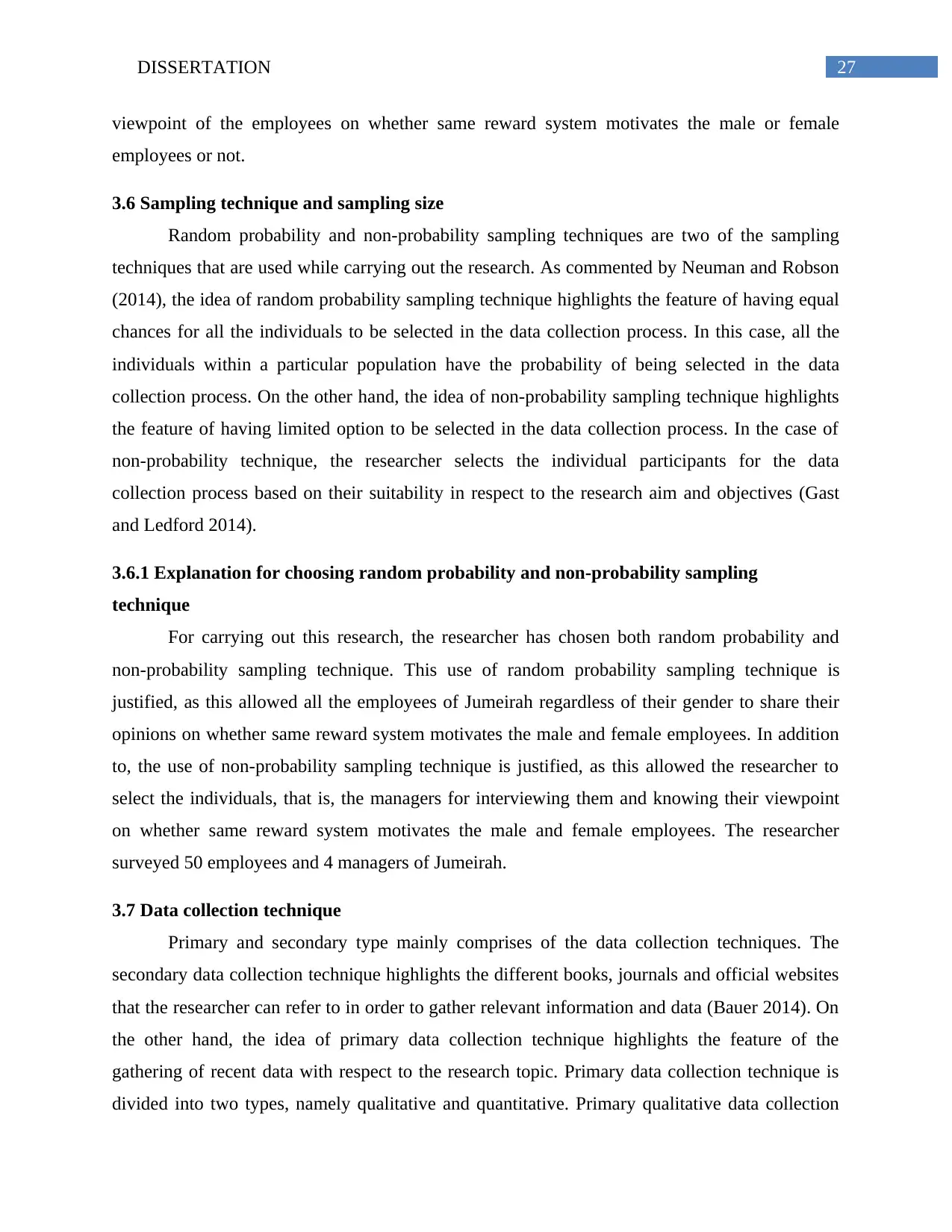
27DISSERTATION
viewpoint of the employees on whether same reward system motivates the male or female
employees or not.
3.6 Sampling technique and sampling size
Random probability and non-probability sampling techniques are two of the sampling
techniques that are used while carrying out the research. As commented by Neuman and Robson
(2014), the idea of random probability sampling technique highlights the feature of having equal
chances for all the individuals to be selected in the data collection process. In this case, all the
individuals within a particular population have the probability of being selected in the data
collection process. On the other hand, the idea of non-probability sampling technique highlights
the feature of having limited option to be selected in the data collection process. In the case of
non-probability technique, the researcher selects the individual participants for the data
collection process based on their suitability in respect to the research aim and objectives (Gast
and Ledford 2014).
3.6.1 Explanation for choosing random probability and non-probability sampling
technique
For carrying out this research, the researcher has chosen both random probability and
non-probability sampling technique. This use of random probability sampling technique is
justified, as this allowed all the employees of Jumeirah regardless of their gender to share their
opinions on whether same reward system motivates the male and female employees. In addition
to, the use of non-probability sampling technique is justified, as this allowed the researcher to
select the individuals, that is, the managers for interviewing them and knowing their viewpoint
on whether same reward system motivates the male and female employees. The researcher
surveyed 50 employees and 4 managers of Jumeirah.
3.7 Data collection technique
Primary and secondary type mainly comprises of the data collection techniques. The
secondary data collection technique highlights the different books, journals and official websites
that the researcher can refer to in order to gather relevant information and data (Bauer 2014). On
the other hand, the idea of primary data collection technique highlights the feature of the
gathering of recent data with respect to the research topic. Primary data collection technique is
divided into two types, namely qualitative and quantitative. Primary qualitative data collection
viewpoint of the employees on whether same reward system motivates the male or female
employees or not.
3.6 Sampling technique and sampling size
Random probability and non-probability sampling techniques are two of the sampling
techniques that are used while carrying out the research. As commented by Neuman and Robson
(2014), the idea of random probability sampling technique highlights the feature of having equal
chances for all the individuals to be selected in the data collection process. In this case, all the
individuals within a particular population have the probability of being selected in the data
collection process. On the other hand, the idea of non-probability sampling technique highlights
the feature of having limited option to be selected in the data collection process. In the case of
non-probability technique, the researcher selects the individual participants for the data
collection process based on their suitability in respect to the research aim and objectives (Gast
and Ledford 2014).
3.6.1 Explanation for choosing random probability and non-probability sampling
technique
For carrying out this research, the researcher has chosen both random probability and
non-probability sampling technique. This use of random probability sampling technique is
justified, as this allowed all the employees of Jumeirah regardless of their gender to share their
opinions on whether same reward system motivates the male and female employees. In addition
to, the use of non-probability sampling technique is justified, as this allowed the researcher to
select the individuals, that is, the managers for interviewing them and knowing their viewpoint
on whether same reward system motivates the male and female employees. The researcher
surveyed 50 employees and 4 managers of Jumeirah.
3.7 Data collection technique
Primary and secondary type mainly comprises of the data collection techniques. The
secondary data collection technique highlights the different books, journals and official websites
that the researcher can refer to in order to gather relevant information and data (Bauer 2014). On
the other hand, the idea of primary data collection technique highlights the feature of the
gathering of recent data with respect to the research topic. Primary data collection technique is
divided into two types, namely qualitative and quantitative. Primary qualitative data collection
Secure Best Marks with AI Grader
Need help grading? Try our AI Grader for instant feedback on your assignments.
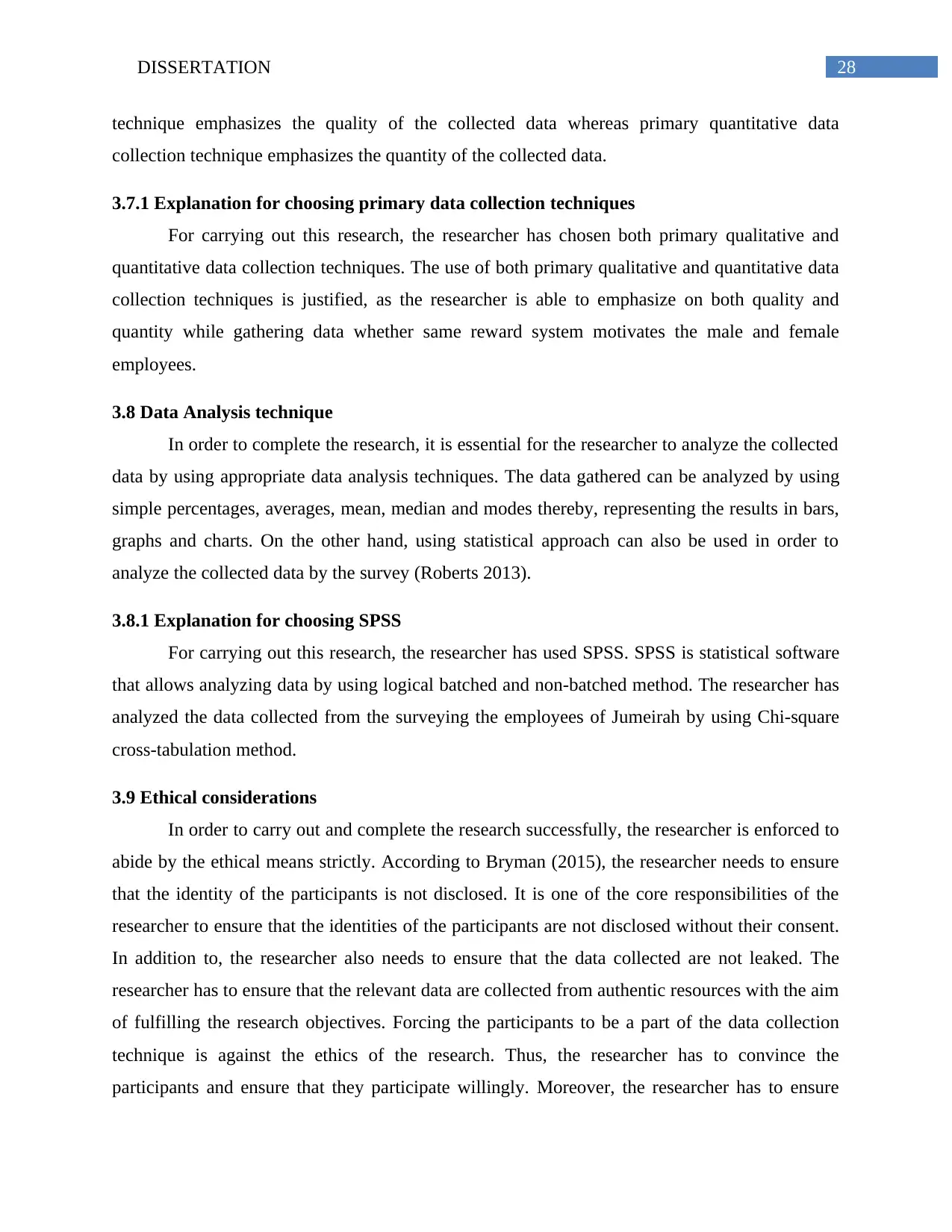
28DISSERTATION
technique emphasizes the quality of the collected data whereas primary quantitative data
collection technique emphasizes the quantity of the collected data.
3.7.1 Explanation for choosing primary data collection techniques
For carrying out this research, the researcher has chosen both primary qualitative and
quantitative data collection techniques. The use of both primary qualitative and quantitative data
collection techniques is justified, as the researcher is able to emphasize on both quality and
quantity while gathering data whether same reward system motivates the male and female
employees.
3.8 Data Analysis technique
In order to complete the research, it is essential for the researcher to analyze the collected
data by using appropriate data analysis techniques. The data gathered can be analyzed by using
simple percentages, averages, mean, median and modes thereby, representing the results in bars,
graphs and charts. On the other hand, using statistical approach can also be used in order to
analyze the collected data by the survey (Roberts 2013).
3.8.1 Explanation for choosing SPSS
For carrying out this research, the researcher has used SPSS. SPSS is statistical software
that allows analyzing data by using logical batched and non-batched method. The researcher has
analyzed the data collected from the surveying the employees of Jumeirah by using Chi-square
cross-tabulation method.
3.9 Ethical considerations
In order to carry out and complete the research successfully, the researcher is enforced to
abide by the ethical means strictly. According to Bryman (2015), the researcher needs to ensure
that the identity of the participants is not disclosed. It is one of the core responsibilities of the
researcher to ensure that the identities of the participants are not disclosed without their consent.
In addition to, the researcher also needs to ensure that the data collected are not leaked. The
researcher has to ensure that the relevant data are collected from authentic resources with the aim
of fulfilling the research objectives. Forcing the participants to be a part of the data collection
technique is against the ethics of the research. Thus, the researcher has to convince the
participants and ensure that they participate willingly. Moreover, the researcher has to ensure
technique emphasizes the quality of the collected data whereas primary quantitative data
collection technique emphasizes the quantity of the collected data.
3.7.1 Explanation for choosing primary data collection techniques
For carrying out this research, the researcher has chosen both primary qualitative and
quantitative data collection techniques. The use of both primary qualitative and quantitative data
collection techniques is justified, as the researcher is able to emphasize on both quality and
quantity while gathering data whether same reward system motivates the male and female
employees.
3.8 Data Analysis technique
In order to complete the research, it is essential for the researcher to analyze the collected
data by using appropriate data analysis techniques. The data gathered can be analyzed by using
simple percentages, averages, mean, median and modes thereby, representing the results in bars,
graphs and charts. On the other hand, using statistical approach can also be used in order to
analyze the collected data by the survey (Roberts 2013).
3.8.1 Explanation for choosing SPSS
For carrying out this research, the researcher has used SPSS. SPSS is statistical software
that allows analyzing data by using logical batched and non-batched method. The researcher has
analyzed the data collected from the surveying the employees of Jumeirah by using Chi-square
cross-tabulation method.
3.9 Ethical considerations
In order to carry out and complete the research successfully, the researcher is enforced to
abide by the ethical means strictly. According to Bryman (2015), the researcher needs to ensure
that the identity of the participants is not disclosed. It is one of the core responsibilities of the
researcher to ensure that the identities of the participants are not disclosed without their consent.
In addition to, the researcher also needs to ensure that the data collected are not leaked. The
researcher has to ensure that the relevant data are collected from authentic resources with the aim
of fulfilling the research objectives. Forcing the participants to be a part of the data collection
technique is against the ethics of the research. Thus, the researcher has to convince the
participants and ensure that they participate willingly. Moreover, the researcher has to ensure
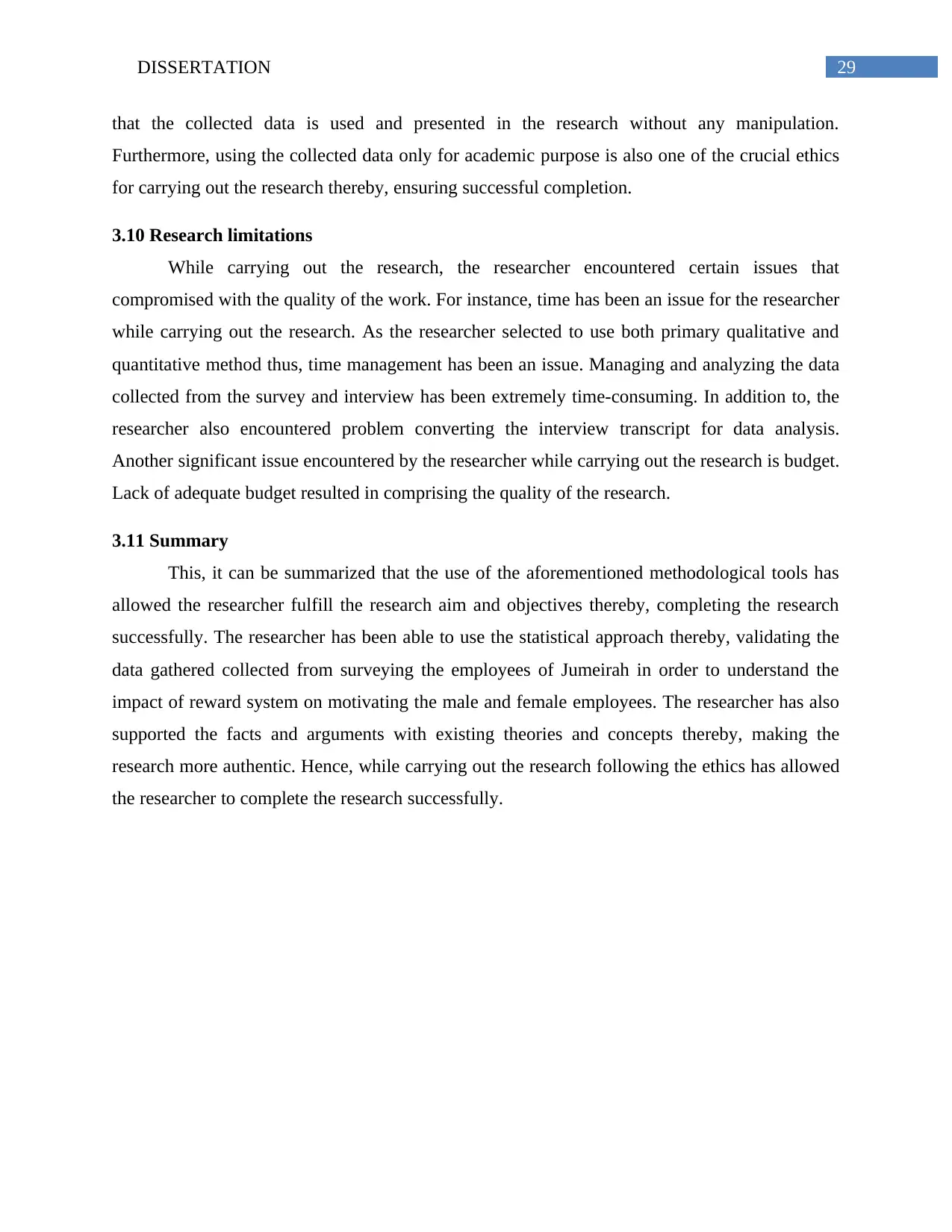
29DISSERTATION
that the collected data is used and presented in the research without any manipulation.
Furthermore, using the collected data only for academic purpose is also one of the crucial ethics
for carrying out the research thereby, ensuring successful completion.
3.10 Research limitations
While carrying out the research, the researcher encountered certain issues that
compromised with the quality of the work. For instance, time has been an issue for the researcher
while carrying out the research. As the researcher selected to use both primary qualitative and
quantitative method thus, time management has been an issue. Managing and analyzing the data
collected from the survey and interview has been extremely time-consuming. In addition to, the
researcher also encountered problem converting the interview transcript for data analysis.
Another significant issue encountered by the researcher while carrying out the research is budget.
Lack of adequate budget resulted in comprising the quality of the research.
3.11 Summary
This, it can be summarized that the use of the aforementioned methodological tools has
allowed the researcher fulfill the research aim and objectives thereby, completing the research
successfully. The researcher has been able to use the statistical approach thereby, validating the
data gathered collected from surveying the employees of Jumeirah in order to understand the
impact of reward system on motivating the male and female employees. The researcher has also
supported the facts and arguments with existing theories and concepts thereby, making the
research more authentic. Hence, while carrying out the research following the ethics has allowed
the researcher to complete the research successfully.
that the collected data is used and presented in the research without any manipulation.
Furthermore, using the collected data only for academic purpose is also one of the crucial ethics
for carrying out the research thereby, ensuring successful completion.
3.10 Research limitations
While carrying out the research, the researcher encountered certain issues that
compromised with the quality of the work. For instance, time has been an issue for the researcher
while carrying out the research. As the researcher selected to use both primary qualitative and
quantitative method thus, time management has been an issue. Managing and analyzing the data
collected from the survey and interview has been extremely time-consuming. In addition to, the
researcher also encountered problem converting the interview transcript for data analysis.
Another significant issue encountered by the researcher while carrying out the research is budget.
Lack of adequate budget resulted in comprising the quality of the research.
3.11 Summary
This, it can be summarized that the use of the aforementioned methodological tools has
allowed the researcher fulfill the research aim and objectives thereby, completing the research
successfully. The researcher has been able to use the statistical approach thereby, validating the
data gathered collected from surveying the employees of Jumeirah in order to understand the
impact of reward system on motivating the male and female employees. The researcher has also
supported the facts and arguments with existing theories and concepts thereby, making the
research more authentic. Hence, while carrying out the research following the ethics has allowed
the researcher to complete the research successfully.
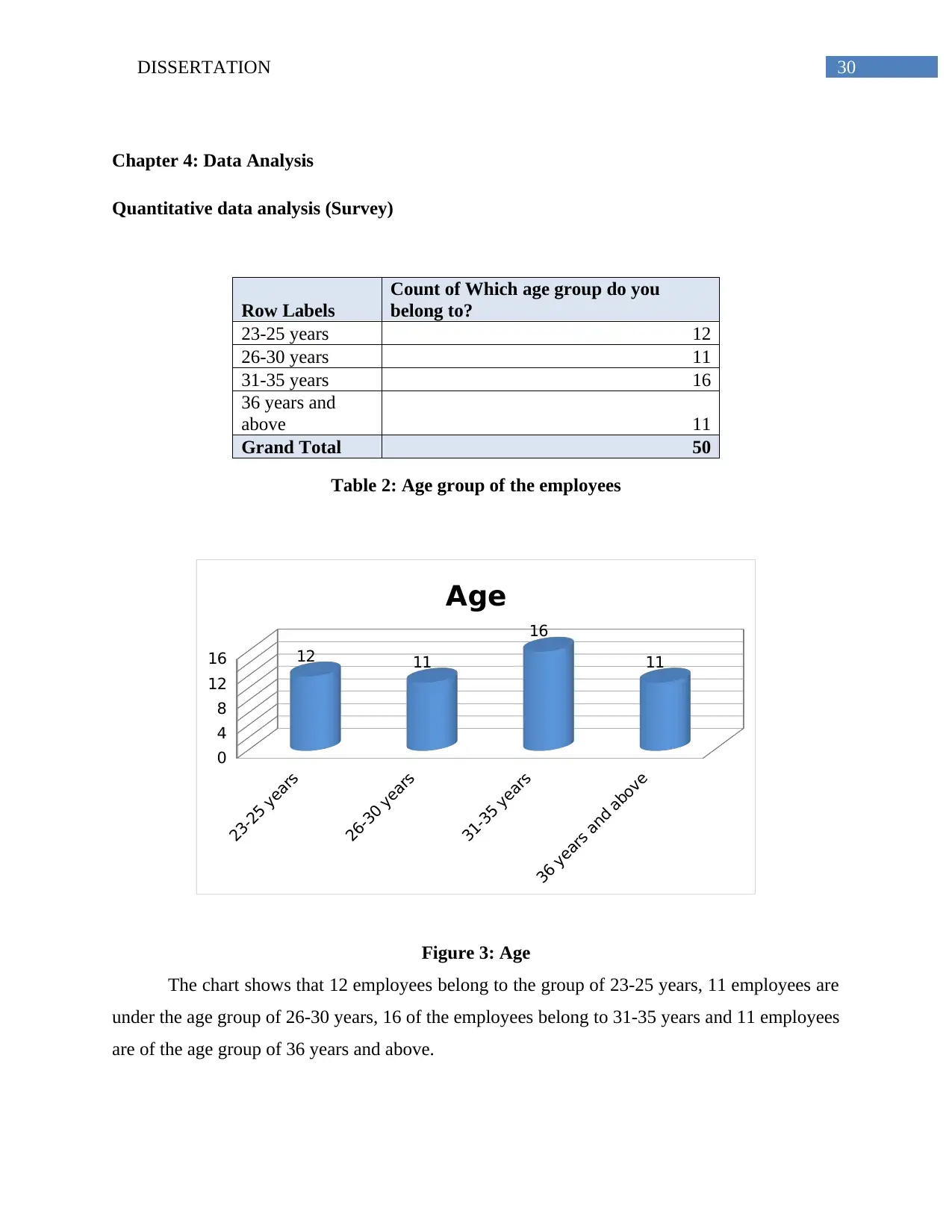
30DISSERTATION
Chapter 4: Data Analysis
Quantitative data analysis (Survey)
Row Labels
Count of Which age group do you
belong to?
23-25 years 12
26-30 years 11
31-35 years 16
36 years and
above 11
Grand Total 50
Table 2: Age group of the employees
23-25 years
26-30 years
31-35 years
36 years and above
0
4
8
12
16 12 11
16
11
Age
Figure 3: Age
The chart shows that 12 employees belong to the group of 23-25 years, 11 employees are
under the age group of 26-30 years, 16 of the employees belong to 31-35 years and 11 employees
are of the age group of 36 years and above.
Chapter 4: Data Analysis
Quantitative data analysis (Survey)
Row Labels
Count of Which age group do you
belong to?
23-25 years 12
26-30 years 11
31-35 years 16
36 years and
above 11
Grand Total 50
Table 2: Age group of the employees
23-25 years
26-30 years
31-35 years
36 years and above
0
4
8
12
16 12 11
16
11
Age
Figure 3: Age
The chart shows that 12 employees belong to the group of 23-25 years, 11 employees are
under the age group of 26-30 years, 16 of the employees belong to 31-35 years and 11 employees
are of the age group of 36 years and above.
Paraphrase This Document
Need a fresh take? Get an instant paraphrase of this document with our AI Paraphraser
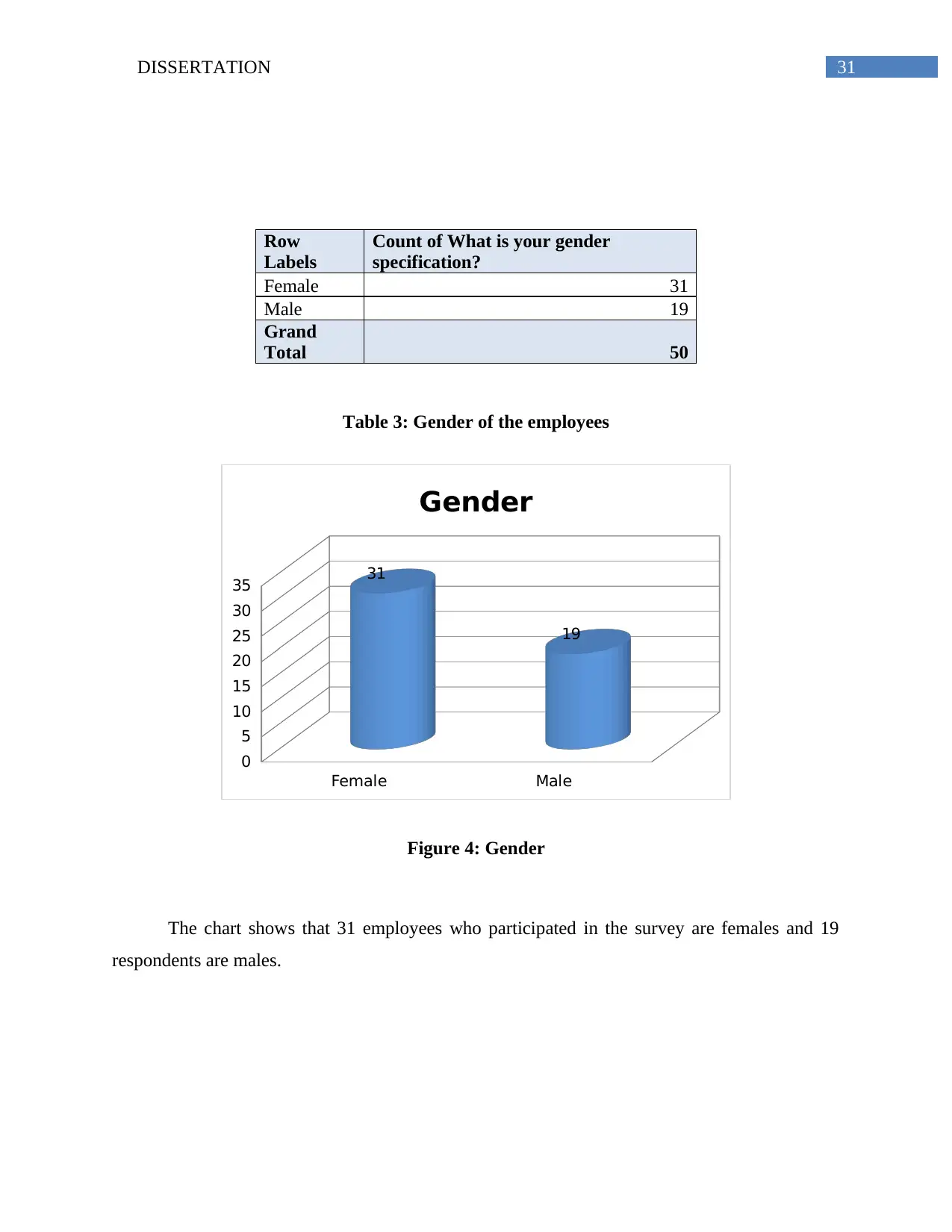
31DISSERTATION
Row
Labels
Count of What is your gender
specification?
Female 31
Male 19
Grand
Total 50
Table 3: Gender of the employees
Female Male
0
5
10
15
20
25
30
35 31
19
Gender
Figure 4: Gender
The chart shows that 31 employees who participated in the survey are females and 19
respondents are males.
Row
Labels
Count of What is your gender
specification?
Female 31
Male 19
Grand
Total 50
Table 3: Gender of the employees
Female Male
0
5
10
15
20
25
30
35 31
19
Gender
Figure 4: Gender
The chart shows that 31 employees who participated in the survey are females and 19
respondents are males.

32DISSERTATION
Row Labels
Count of How long have you been working in
Jumeirah?
0-2 years 11
10 years and
above 12
3-5 years 18
6-9 years 9
Grand Total 50
Table 4: Work experience in Jumeirah
0-2 years 10 years and above 3-5 years 6-9 years
0
2
4
6
8
10
12
14
16
18
Duration of working at Jumeirah
Figure 5: Duration of work at Jumeirah
The above chart shows that 11 employees are working in the company for 0-2 years, 18
employees are working for 3-5 years, 9 employees are working for 6-9 years and 12 employees
are working for 10 years and above within the organization.
Row
Labels
Count of Does the reward system motivates you to work more
effectively?
Maybe 15
No 19
Row Labels
Count of How long have you been working in
Jumeirah?
0-2 years 11
10 years and
above 12
3-5 years 18
6-9 years 9
Grand Total 50
Table 4: Work experience in Jumeirah
0-2 years 10 years and above 3-5 years 6-9 years
0
2
4
6
8
10
12
14
16
18
Duration of working at Jumeirah
Figure 5: Duration of work at Jumeirah
The above chart shows that 11 employees are working in the company for 0-2 years, 18
employees are working for 3-5 years, 9 employees are working for 6-9 years and 12 employees
are working for 10 years and above within the organization.
Row
Labels
Count of Does the reward system motivates you to work more
effectively?
Maybe 15
No 19

33DISSERTATION
Yes 16
Grand
Total 50
Table 5: Does the reward system motivate you to work more effectively
Maybe No Yes
0
5
10
15
20
Effectiveness of reward in moti-
vation
Figure 6: Effectiveness of reward in motivation
16 of the employees have stated that reward system within the organization helps in
working effectively where as 19 of the employees denied with the fact. 15 employees had no
opinion regarding whether motivation helps them in working more effectively within the
organization.
Yes 16
Grand
Total 50
Table 5: Does the reward system motivate you to work more effectively
Maybe No Yes
0
5
10
15
20
Effectiveness of reward in moti-
vation
Figure 6: Effectiveness of reward in motivation
16 of the employees have stated that reward system within the organization helps in
working effectively where as 19 of the employees denied with the fact. 15 employees had no
opinion regarding whether motivation helps them in working more effectively within the
organization.
Secure Best Marks with AI Grader
Need help grading? Try our AI Grader for instant feedback on your assignments.
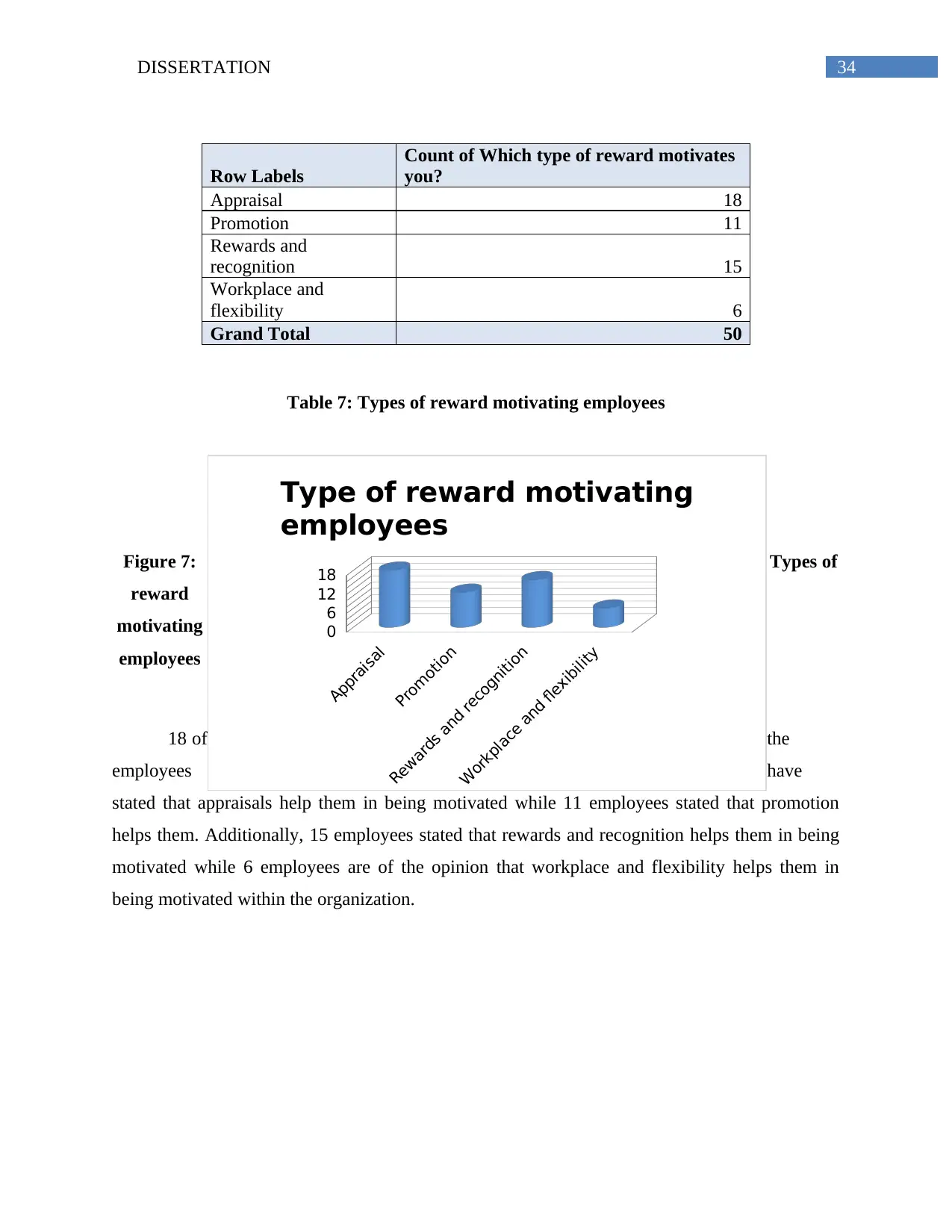
34DISSERTATION
Row Labels
Count of Which type of reward motivates
you?
Appraisal 18
Promotion 11
Rewards and
recognition 15
Workplace and
flexibility 6
Grand Total 50
Table 7: Types of reward motivating employees
Figure 7: Types of
reward
motivating
employees
18 of the
employees have
stated that appraisals help them in being motivated while 11 employees stated that promotion
helps them. Additionally, 15 employees stated that rewards and recognition helps them in being
motivated while 6 employees are of the opinion that workplace and flexibility helps them in
being motivated within the organization.
Appraisal
Promotion
Rewards and recognition
Workplace and flexibility
0
6
12
18
Type of reward motivating
employees
Row Labels
Count of Which type of reward motivates
you?
Appraisal 18
Promotion 11
Rewards and
recognition 15
Workplace and
flexibility 6
Grand Total 50
Table 7: Types of reward motivating employees
Figure 7: Types of
reward
motivating
employees
18 of the
employees have
stated that appraisals help them in being motivated while 11 employees stated that promotion
helps them. Additionally, 15 employees stated that rewards and recognition helps them in being
motivated while 6 employees are of the opinion that workplace and flexibility helps them in
being motivated within the organization.
Appraisal
Promotion
Rewards and recognition
Workplace and flexibility
0
6
12
18
Type of reward motivating
employees
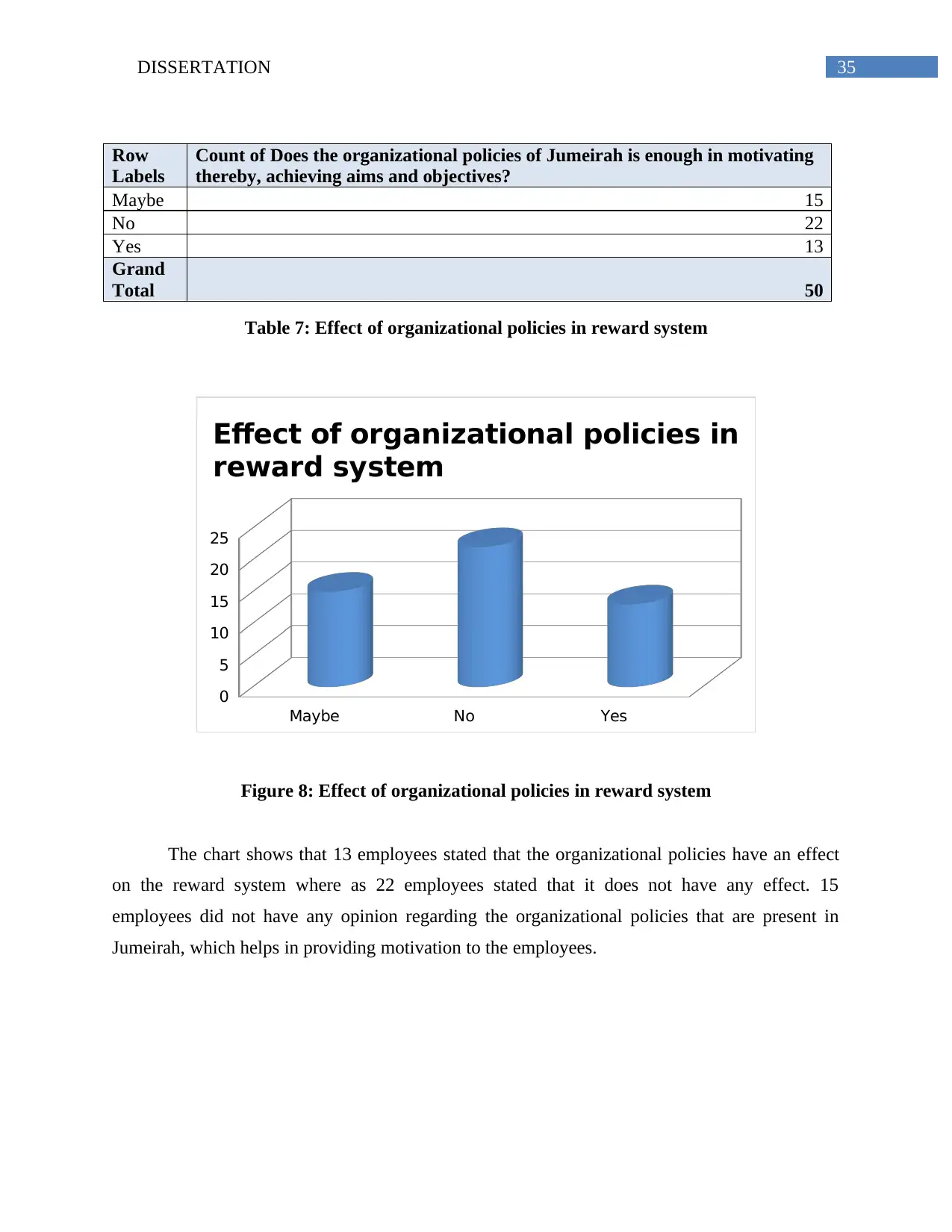
35DISSERTATION
Row
Labels
Count of Does the organizational policies of Jumeirah is enough in motivating
thereby, achieving aims and objectives?
Maybe 15
No 22
Yes 13
Grand
Total 50
Table 7: Effect of organizational policies in reward system
Maybe No Yes
0
5
10
15
20
25
Effect of organizational policies in
reward system
Figure 8: Effect of organizational policies in reward system
The chart shows that 13 employees stated that the organizational policies have an effect
on the reward system where as 22 employees stated that it does not have any effect. 15
employees did not have any opinion regarding the organizational policies that are present in
Jumeirah, which helps in providing motivation to the employees.
Row
Labels
Count of Does the organizational policies of Jumeirah is enough in motivating
thereby, achieving aims and objectives?
Maybe 15
No 22
Yes 13
Grand
Total 50
Table 7: Effect of organizational policies in reward system
Maybe No Yes
0
5
10
15
20
25
Effect of organizational policies in
reward system
Figure 8: Effect of organizational policies in reward system
The chart shows that 13 employees stated that the organizational policies have an effect
on the reward system where as 22 employees stated that it does not have any effect. 15
employees did not have any opinion regarding the organizational policies that are present in
Jumeirah, which helps in providing motivation to the employees.
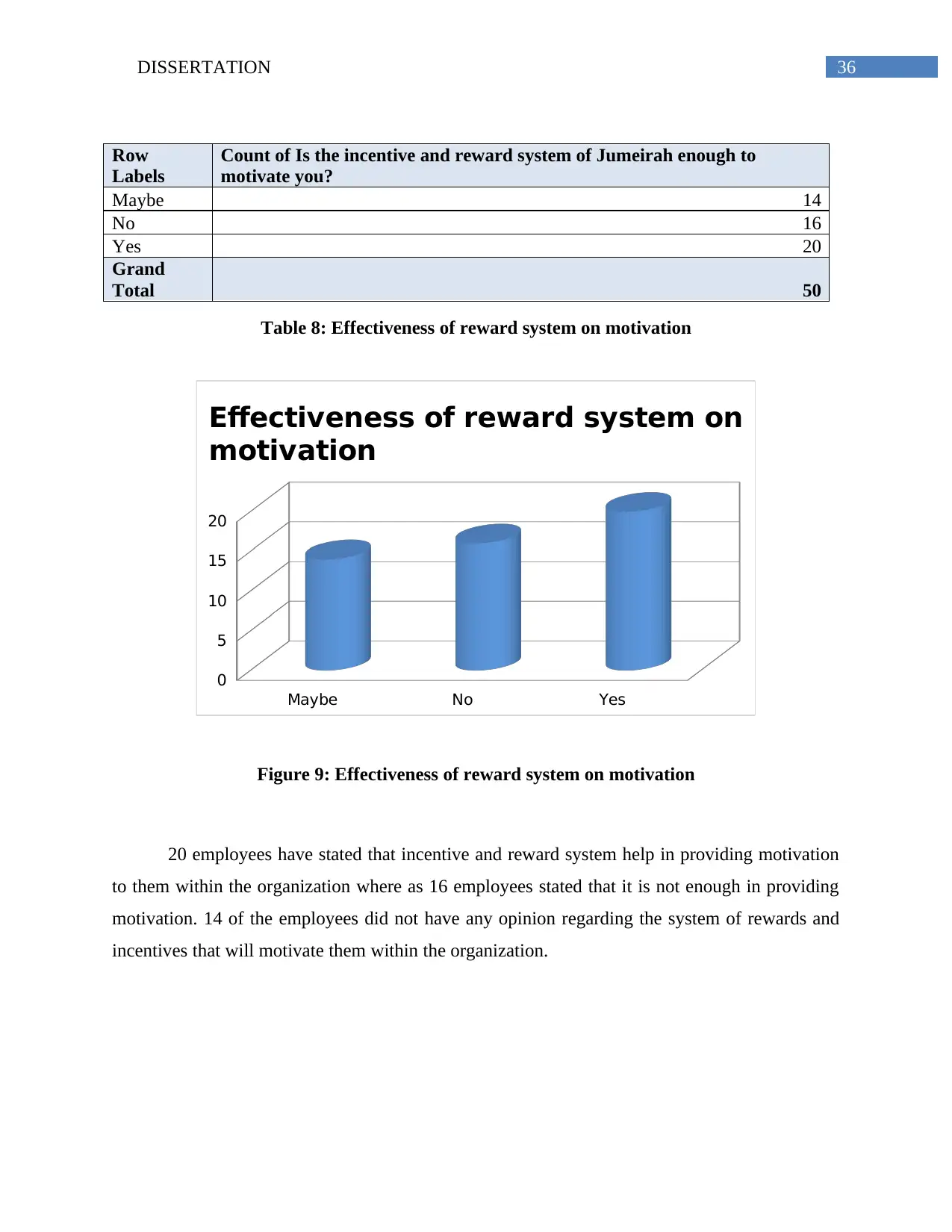
36DISSERTATION
Row
Labels
Count of Is the incentive and reward system of Jumeirah enough to
motivate you?
Maybe 14
No 16
Yes 20
Grand
Total 50
Table 8: Effectiveness of reward system on motivation
Maybe No Yes
0
5
10
15
20
Effectiveness of reward system on
motivation
Figure 9: Effectiveness of reward system on motivation
20 employees have stated that incentive and reward system help in providing motivation
to them within the organization where as 16 employees stated that it is not enough in providing
motivation. 14 of the employees did not have any opinion regarding the system of rewards and
incentives that will motivate them within the organization.
Row
Labels
Count of Is the incentive and reward system of Jumeirah enough to
motivate you?
Maybe 14
No 16
Yes 20
Grand
Total 50
Table 8: Effectiveness of reward system on motivation
Maybe No Yes
0
5
10
15
20
Effectiveness of reward system on
motivation
Figure 9: Effectiveness of reward system on motivation
20 employees have stated that incentive and reward system help in providing motivation
to them within the organization where as 16 employees stated that it is not enough in providing
motivation. 14 of the employees did not have any opinion regarding the system of rewards and
incentives that will motivate them within the organization.
Paraphrase This Document
Need a fresh take? Get an instant paraphrase of this document with our AI Paraphraser
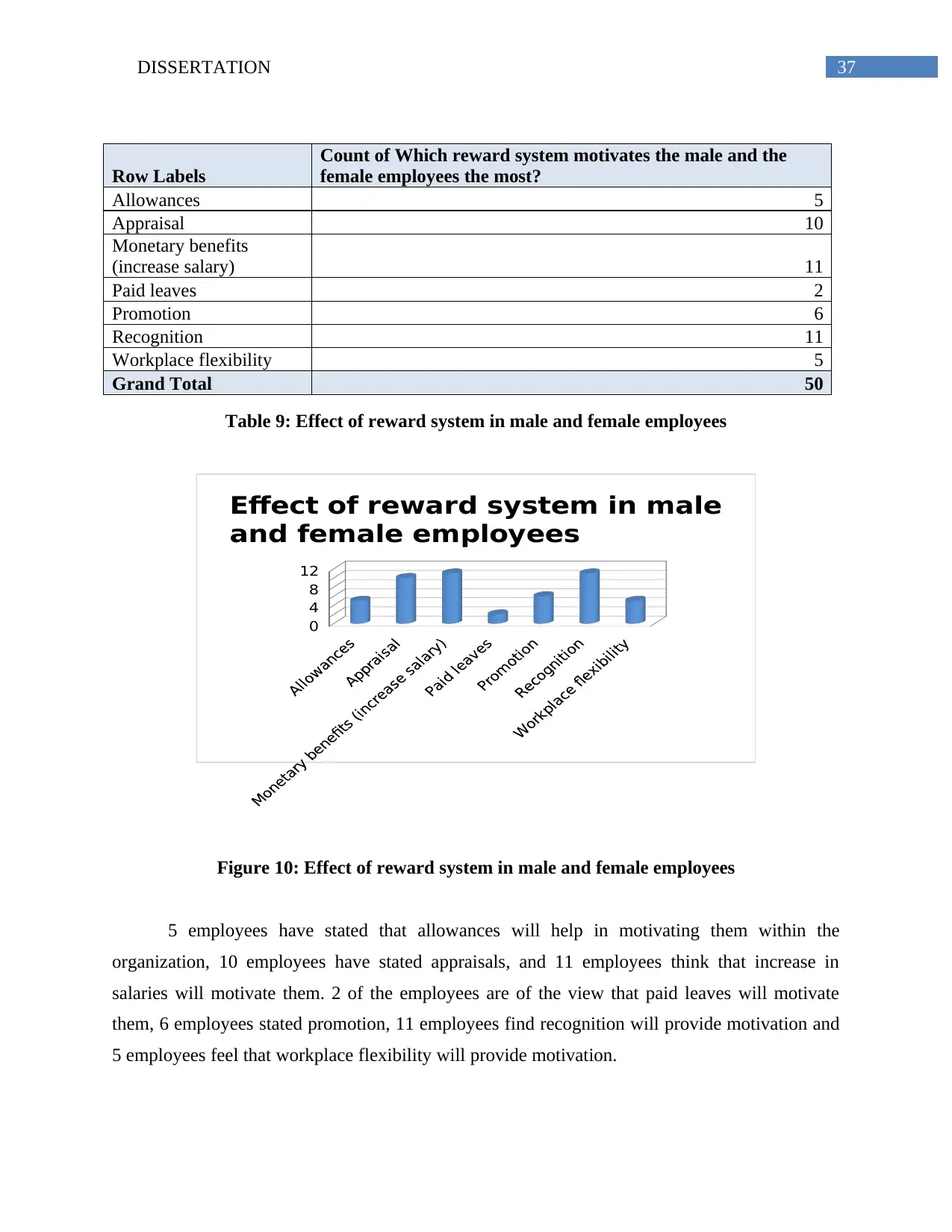
37DISSERTATION
Row Labels
Count of Which reward system motivates the male and the
female employees the most?
Allowances 5
Appraisal 10
Monetary benefits
(increase salary) 11
Paid leaves 2
Promotion 6
Recognition 11
Workplace flexibility 5
Grand Total 50
Table 9: Effect of reward system in male and female employees
0
4
8
12
Effect of reward system in male
and female employees
Figure 10: Effect of reward system in male and female employees
5 employees have stated that allowances will help in motivating them within the
organization, 10 employees have stated appraisals, and 11 employees think that increase in
salaries will motivate them. 2 of the employees are of the view that paid leaves will motivate
them, 6 employees stated promotion, 11 employees find recognition will provide motivation and
5 employees feel that workplace flexibility will provide motivation.
Row Labels
Count of Which reward system motivates the male and the
female employees the most?
Allowances 5
Appraisal 10
Monetary benefits
(increase salary) 11
Paid leaves 2
Promotion 6
Recognition 11
Workplace flexibility 5
Grand Total 50
Table 9: Effect of reward system in male and female employees
0
4
8
12
Effect of reward system in male
and female employees
Figure 10: Effect of reward system in male and female employees
5 employees have stated that allowances will help in motivating them within the
organization, 10 employees have stated appraisals, and 11 employees think that increase in
salaries will motivate them. 2 of the employees are of the view that paid leaves will motivate
them, 6 employees stated promotion, 11 employees find recognition will provide motivation and
5 employees feel that workplace flexibility will provide motivation.
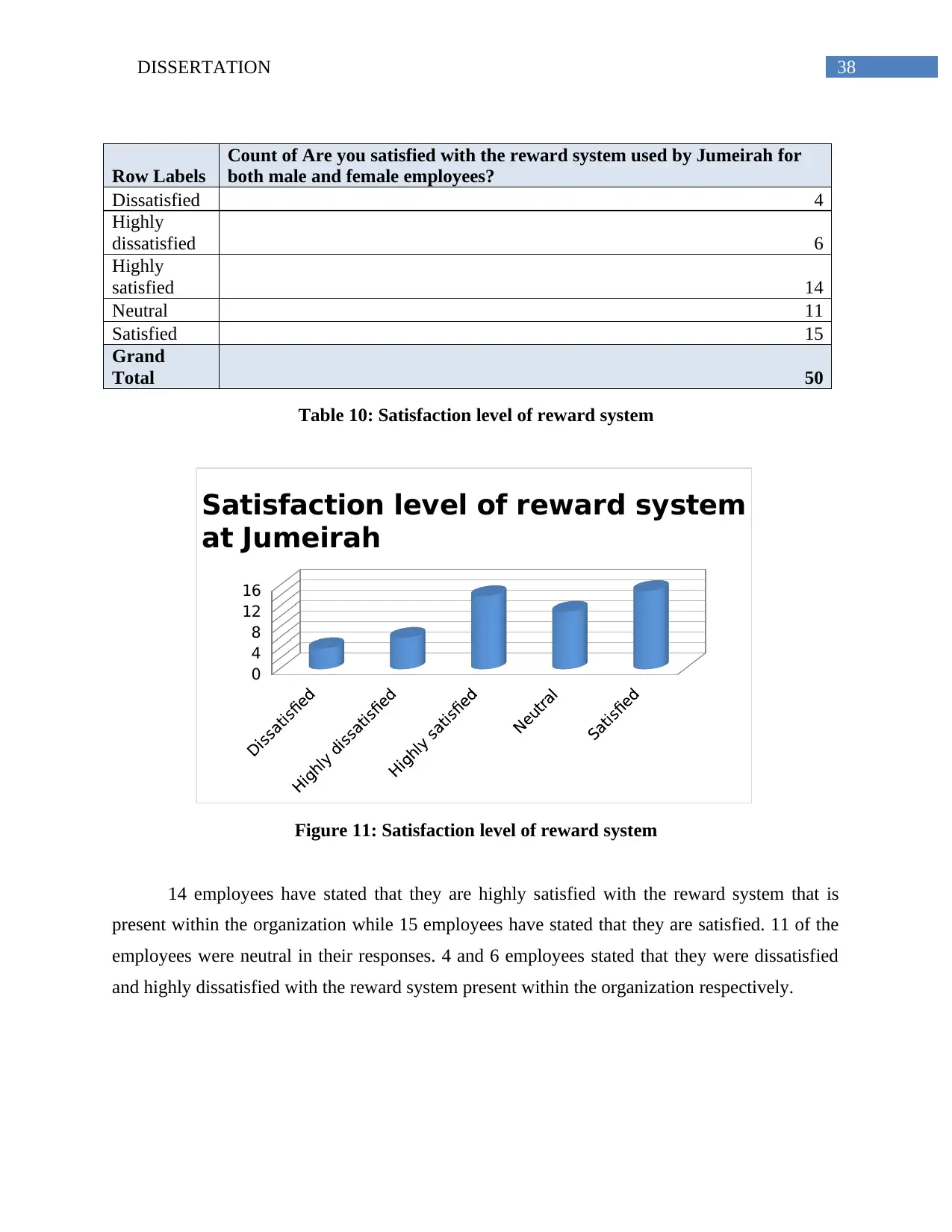
38DISSERTATION
Row Labels
Count of Are you satisfied with the reward system used by Jumeirah for
both male and female employees?
Dissatisfied 4
Highly
dissatisfied 6
Highly
satisfied 14
Neutral 11
Satisfied 15
Grand
Total 50
Table 10: Satisfaction level of reward system
0
4
8
12
16
Satisfaction level of reward system
at Jumeirah
Figure 11: Satisfaction level of reward system
14 employees have stated that they are highly satisfied with the reward system that is
present within the organization while 15 employees have stated that they are satisfied. 11 of the
employees were neutral in their responses. 4 and 6 employees stated that they were dissatisfied
and highly dissatisfied with the reward system present within the organization respectively.
Row Labels
Count of Are you satisfied with the reward system used by Jumeirah for
both male and female employees?
Dissatisfied 4
Highly
dissatisfied 6
Highly
satisfied 14
Neutral 11
Satisfied 15
Grand
Total 50
Table 10: Satisfaction level of reward system
0
4
8
12
16
Satisfaction level of reward system
at Jumeirah
Figure 11: Satisfaction level of reward system
14 employees have stated that they are highly satisfied with the reward system that is
present within the organization while 15 employees have stated that they are satisfied. 11 of the
employees were neutral in their responses. 4 and 6 employees stated that they were dissatisfied
and highly dissatisfied with the reward system present within the organization respectively.
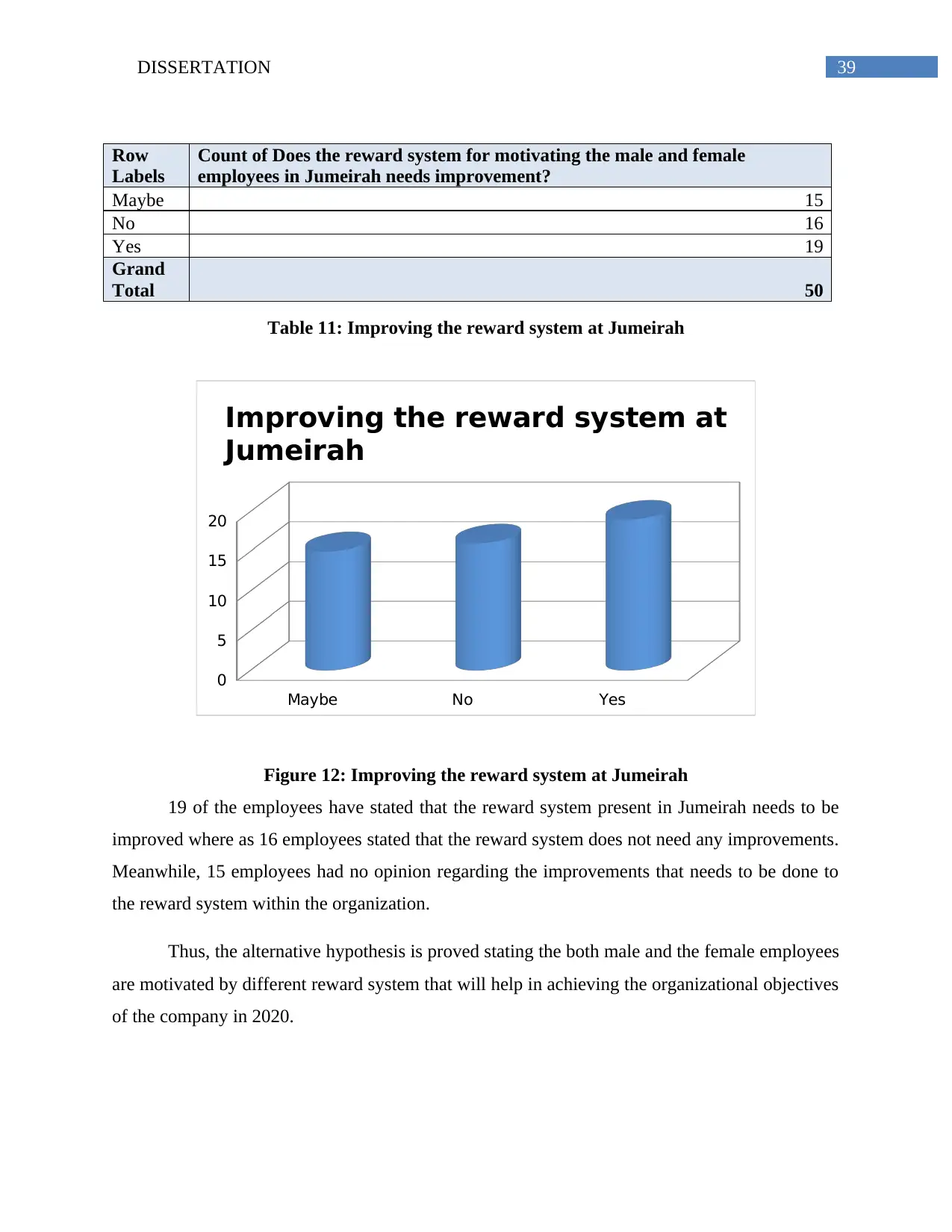
39DISSERTATION
Row
Labels
Count of Does the reward system for motivating the male and female
employees in Jumeirah needs improvement?
Maybe 15
No 16
Yes 19
Grand
Total 50
Table 11: Improving the reward system at Jumeirah
Maybe No Yes
0
5
10
15
20
Improving the reward system at
Jumeirah
Figure 12: Improving the reward system at Jumeirah
19 of the employees have stated that the reward system present in Jumeirah needs to be
improved where as 16 employees stated that the reward system does not need any improvements.
Meanwhile, 15 employees had no opinion regarding the improvements that needs to be done to
the reward system within the organization.
Thus, the alternative hypothesis is proved stating the both male and the female employees
are motivated by different reward system that will help in achieving the organizational objectives
of the company in 2020.
Row
Labels
Count of Does the reward system for motivating the male and female
employees in Jumeirah needs improvement?
Maybe 15
No 16
Yes 19
Grand
Total 50
Table 11: Improving the reward system at Jumeirah
Maybe No Yes
0
5
10
15
20
Improving the reward system at
Jumeirah
Figure 12: Improving the reward system at Jumeirah
19 of the employees have stated that the reward system present in Jumeirah needs to be
improved where as 16 employees stated that the reward system does not need any improvements.
Meanwhile, 15 employees had no opinion regarding the improvements that needs to be done to
the reward system within the organization.
Thus, the alternative hypothesis is proved stating the both male and the female employees
are motivated by different reward system that will help in achieving the organizational objectives
of the company in 2020.
Secure Best Marks with AI Grader
Need help grading? Try our AI Grader for instant feedback on your assignments.

40DISSERTATION
Qualitative data analysis (Interview)
1) What kind of reward system does the company use for motivating the employees?
Male interviewee 1: “At Jumeirah, we use both intrinsic and extrinsic reward system.
Implementing the intrinsic reward system provides an opportunity for us to commit the
employees to a meaningful purpose along with allowing them to select the best way of fulfilling
the purpose.”
Male interviewee 2: “For us at Jumeirah, intrinsic reward system aim towards motivating the
male and the female employees thereby, ensuring employee engagement and commitment. We
also consider the needs of the employees due to which we also use an extrinsic reward system
that mainly emphasizes on financial factors. Rewarding the employees financially makes them
financially independent that motivate them to work better and get rewarded financially more.”
Female interviewee 1: “Both intrinsic and extrinsic reward system used at Jumeirah. This is
because we feel that both extrinsic and intrinsic reward systems are necessary for the
employees.”Female interviewee 2: “Intrinsic reward system helps in motivating the employees
thereby, ensuring better employee engagement and commitment. As a result, the employees go
an extra mile, take initiative for completing their tasks and make it successful. As better
employee engagement results in better results, we appreciate the effort of the employees by using
an extrinsic reward system."
2) What are the differences between the reward systems for male and female employees?
Male interviewee 1: “At Jumeirah, we use different kinds of reward systems based on the needs
and demands of the employees. The basic reward system used by the company for both male and
female staffs includes appraisal, promotion, incentives and monetary benefits.”
Male interviewee 2: “We the managers, tend to communicate with the employees at a regular
interval in order to understand their current needs and use a relevant reward system. However, in
certain instances, it becomes difficult for us to implement a separate reward system for each of
the employees considering the huge number of employees working for us."
Qualitative data analysis (Interview)
1) What kind of reward system does the company use for motivating the employees?
Male interviewee 1: “At Jumeirah, we use both intrinsic and extrinsic reward system.
Implementing the intrinsic reward system provides an opportunity for us to commit the
employees to a meaningful purpose along with allowing them to select the best way of fulfilling
the purpose.”
Male interviewee 2: “For us at Jumeirah, intrinsic reward system aim towards motivating the
male and the female employees thereby, ensuring employee engagement and commitment. We
also consider the needs of the employees due to which we also use an extrinsic reward system
that mainly emphasizes on financial factors. Rewarding the employees financially makes them
financially independent that motivate them to work better and get rewarded financially more.”
Female interviewee 1: “Both intrinsic and extrinsic reward system used at Jumeirah. This is
because we feel that both extrinsic and intrinsic reward systems are necessary for the
employees.”Female interviewee 2: “Intrinsic reward system helps in motivating the employees
thereby, ensuring better employee engagement and commitment. As a result, the employees go
an extra mile, take initiative for completing their tasks and make it successful. As better
employee engagement results in better results, we appreciate the effort of the employees by using
an extrinsic reward system."
2) What are the differences between the reward systems for male and female employees?
Male interviewee 1: “At Jumeirah, we use different kinds of reward systems based on the needs
and demands of the employees. The basic reward system used by the company for both male and
female staffs includes appraisal, promotion, incentives and monetary benefits.”
Male interviewee 2: “We the managers, tend to communicate with the employees at a regular
interval in order to understand their current needs and use a relevant reward system. However, in
certain instances, it becomes difficult for us to implement a separate reward system for each of
the employees considering the huge number of employees working for us."

41DISSERTATION
Female interviewee 1: “Similar reward systems are used for both male and female employees at
Jumeirah. This is because identifying the individual needs and implementing reward system
accordingly becomes extremely difficult and time consuming for us. In addition, having separate
reward system creates conflicts within the existing workforce.
Female interviewee 2: “At Jumeirah, we use some additional reward system for the female
employees other than incentives, appraisal, promotion and monetary benefits. They include paid
leaves, maternity paid leaves, daily conveyances and workplace and work time flexibility. The
additional reward systems for the employees are developed keeping in mind the job of the female
employees they have to do in both their personal and professional life."
3) In what manner have the separate systems for male and female employees been
effective?
Male interviewee 1: "The separate reward system has been effective at Jumeirah, as there lay
some differences in terms of the needs and demands of the male and the female employees.
Better employee engagement and commitment has been noticed due to the implementation of
separate reward system.”
Male interviewee 2: "Implementing a separate reward system for the male and the female
employees has reduced the rate of employee turnover slightly. This highlights that at Jumeirah,
we have been successful in fulfilling the needs and demands of the employees to a certain
extent.”
Female interviewee 1: “The effectiveness of separate reward system can be determined by
analyzing the increased number of female employees at Jumeirah. Rewards such as paid
maternity leaves, daily conveyances and workplace and work time flexibility have strengthened
the association of the female employees with Jumeirah."
Female interviewee 2: “Separate reward system at Jumeirah has provided an opportunity to
continue their career with us, as the company is aiming towards fulfilling the future needs as well
as daily needs of the female employees along with the male employees.”
4) Why do you think it was necessary to implement a separate reward system for male and
female employees?
Female interviewee 1: “Similar reward systems are used for both male and female employees at
Jumeirah. This is because identifying the individual needs and implementing reward system
accordingly becomes extremely difficult and time consuming for us. In addition, having separate
reward system creates conflicts within the existing workforce.
Female interviewee 2: “At Jumeirah, we use some additional reward system for the female
employees other than incentives, appraisal, promotion and monetary benefits. They include paid
leaves, maternity paid leaves, daily conveyances and workplace and work time flexibility. The
additional reward systems for the employees are developed keeping in mind the job of the female
employees they have to do in both their personal and professional life."
3) In what manner have the separate systems for male and female employees been
effective?
Male interviewee 1: "The separate reward system has been effective at Jumeirah, as there lay
some differences in terms of the needs and demands of the male and the female employees.
Better employee engagement and commitment has been noticed due to the implementation of
separate reward system.”
Male interviewee 2: "Implementing a separate reward system for the male and the female
employees has reduced the rate of employee turnover slightly. This highlights that at Jumeirah,
we have been successful in fulfilling the needs and demands of the employees to a certain
extent.”
Female interviewee 1: “The effectiveness of separate reward system can be determined by
analyzing the increased number of female employees at Jumeirah. Rewards such as paid
maternity leaves, daily conveyances and workplace and work time flexibility have strengthened
the association of the female employees with Jumeirah."
Female interviewee 2: “Separate reward system at Jumeirah has provided an opportunity to
continue their career with us, as the company is aiming towards fulfilling the future needs as well
as daily needs of the female employees along with the male employees.”
4) Why do you think it was necessary to implement a separate reward system for male and
female employees?
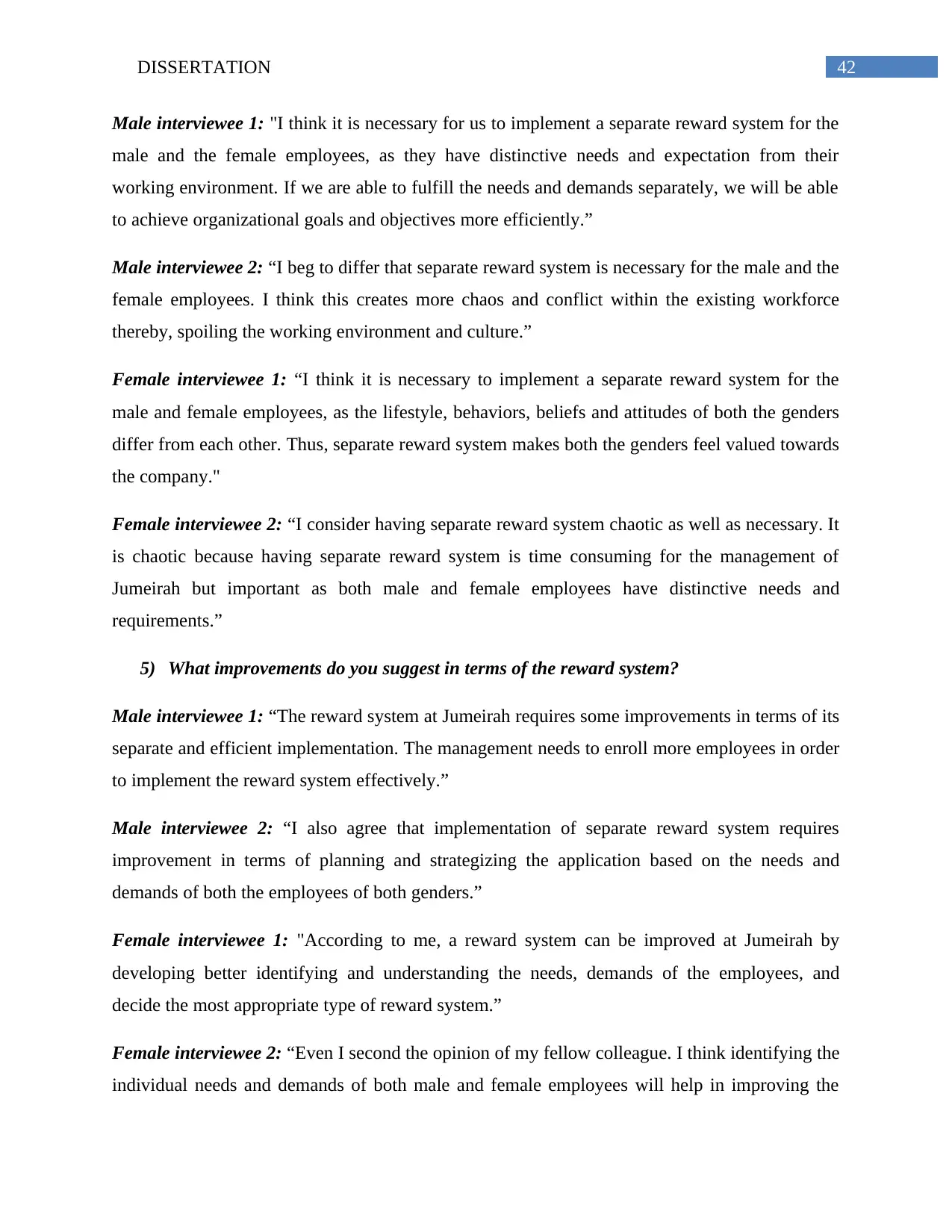
42DISSERTATION
Male interviewee 1: "I think it is necessary for us to implement a separate reward system for the
male and the female employees, as they have distinctive needs and expectation from their
working environment. If we are able to fulfill the needs and demands separately, we will be able
to achieve organizational goals and objectives more efficiently.”
Male interviewee 2: “I beg to differ that separate reward system is necessary for the male and the
female employees. I think this creates more chaos and conflict within the existing workforce
thereby, spoiling the working environment and culture.”
Female interviewee 1: “I think it is necessary to implement a separate reward system for the
male and female employees, as the lifestyle, behaviors, beliefs and attitudes of both the genders
differ from each other. Thus, separate reward system makes both the genders feel valued towards
the company."
Female interviewee 2: “I consider having separate reward system chaotic as well as necessary. It
is chaotic because having separate reward system is time consuming for the management of
Jumeirah but important as both male and female employees have distinctive needs and
requirements.”
5) What improvements do you suggest in terms of the reward system?
Male interviewee 1: “The reward system at Jumeirah requires some improvements in terms of its
separate and efficient implementation. The management needs to enroll more employees in order
to implement the reward system effectively.”
Male interviewee 2: “I also agree that implementation of separate reward system requires
improvement in terms of planning and strategizing the application based on the needs and
demands of both the employees of both genders.”
Female interviewee 1: "According to me, a reward system can be improved at Jumeirah by
developing better identifying and understanding the needs, demands of the employees, and
decide the most appropriate type of reward system.”
Female interviewee 2: “Even I second the opinion of my fellow colleague. I think identifying the
individual needs and demands of both male and female employees will help in improving the
Male interviewee 1: "I think it is necessary for us to implement a separate reward system for the
male and the female employees, as they have distinctive needs and expectation from their
working environment. If we are able to fulfill the needs and demands separately, we will be able
to achieve organizational goals and objectives more efficiently.”
Male interviewee 2: “I beg to differ that separate reward system is necessary for the male and the
female employees. I think this creates more chaos and conflict within the existing workforce
thereby, spoiling the working environment and culture.”
Female interviewee 1: “I think it is necessary to implement a separate reward system for the
male and female employees, as the lifestyle, behaviors, beliefs and attitudes of both the genders
differ from each other. Thus, separate reward system makes both the genders feel valued towards
the company."
Female interviewee 2: “I consider having separate reward system chaotic as well as necessary. It
is chaotic because having separate reward system is time consuming for the management of
Jumeirah but important as both male and female employees have distinctive needs and
requirements.”
5) What improvements do you suggest in terms of the reward system?
Male interviewee 1: “The reward system at Jumeirah requires some improvements in terms of its
separate and efficient implementation. The management needs to enroll more employees in order
to implement the reward system effectively.”
Male interviewee 2: “I also agree that implementation of separate reward system requires
improvement in terms of planning and strategizing the application based on the needs and
demands of both the employees of both genders.”
Female interviewee 1: "According to me, a reward system can be improved at Jumeirah by
developing better identifying and understanding the needs, demands of the employees, and
decide the most appropriate type of reward system.”
Female interviewee 2: “Even I second the opinion of my fellow colleague. I think identifying the
individual needs and demands of both male and female employees will help in improving the
Paraphrase This Document
Need a fresh take? Get an instant paraphrase of this document with our AI Paraphraser
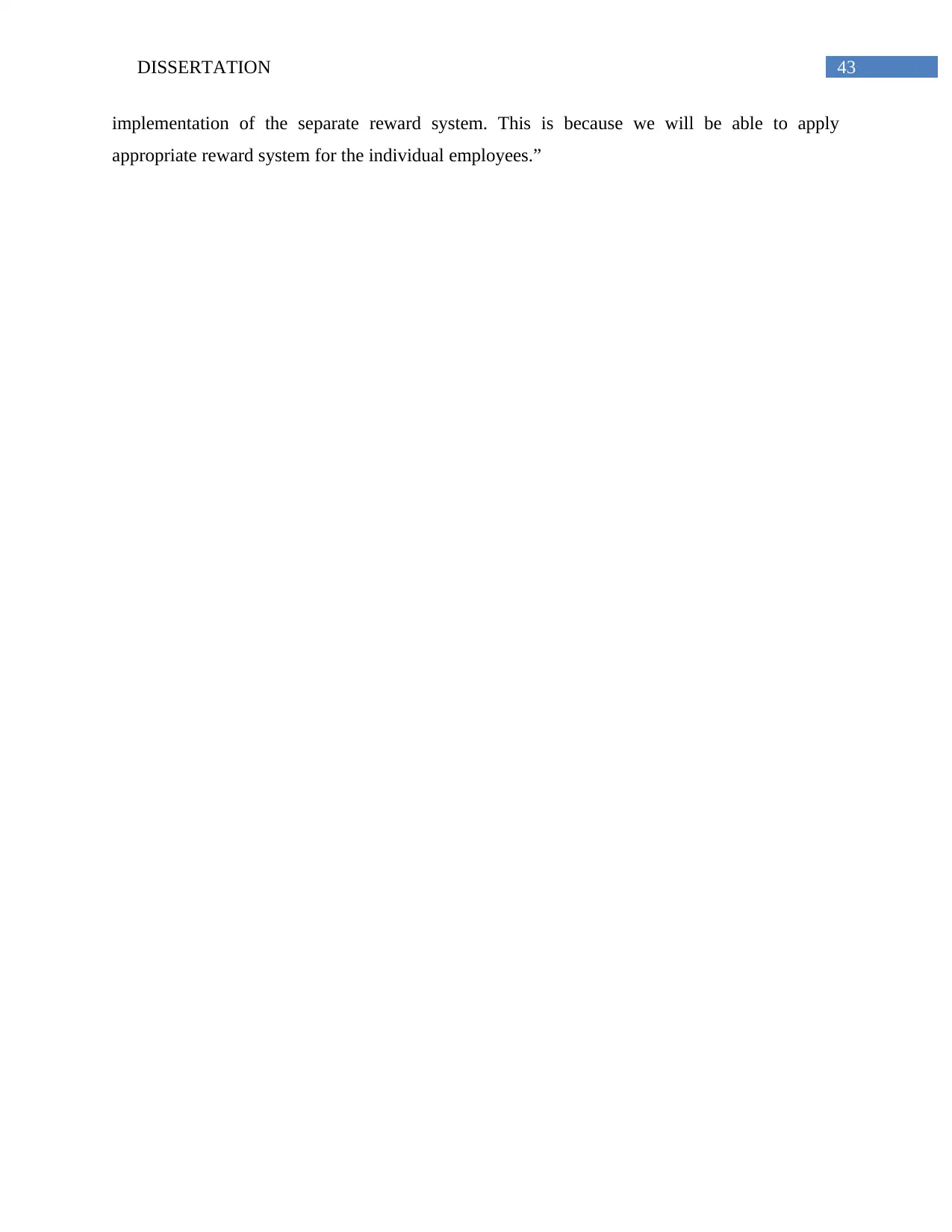
43DISSERTATION
implementation of the separate reward system. This is because we will be able to apply
appropriate reward system for the individual employees.”
implementation of the separate reward system. This is because we will be able to apply
appropriate reward system for the individual employees.”
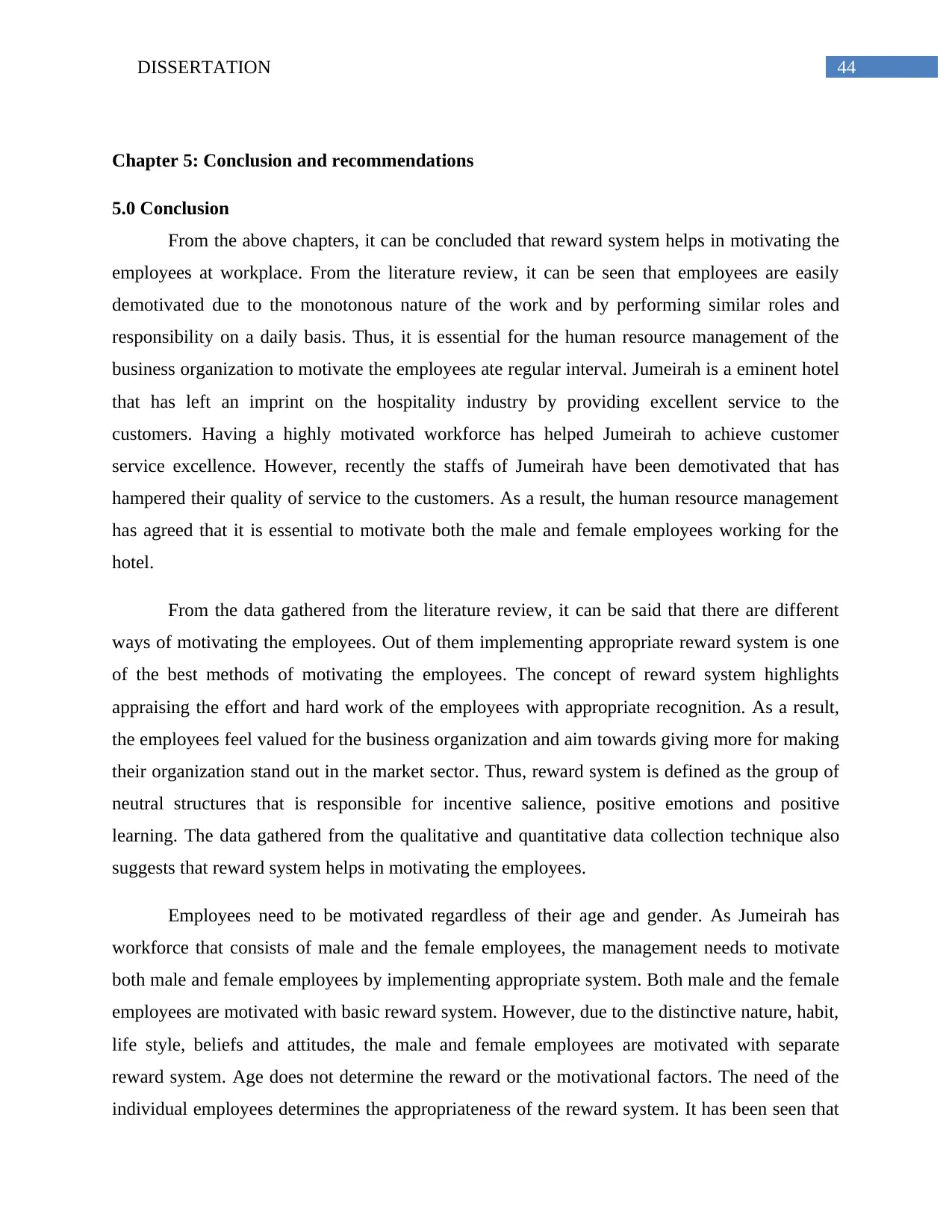
44DISSERTATION
Chapter 5: Conclusion and recommendations
5.0 Conclusion
From the above chapters, it can be concluded that reward system helps in motivating the
employees at workplace. From the literature review, it can be seen that employees are easily
demotivated due to the monotonous nature of the work and by performing similar roles and
responsibility on a daily basis. Thus, it is essential for the human resource management of the
business organization to motivate the employees ate regular interval. Jumeirah is a eminent hotel
that has left an imprint on the hospitality industry by providing excellent service to the
customers. Having a highly motivated workforce has helped Jumeirah to achieve customer
service excellence. However, recently the staffs of Jumeirah have been demotivated that has
hampered their quality of service to the customers. As a result, the human resource management
has agreed that it is essential to motivate both the male and female employees working for the
hotel.
From the data gathered from the literature review, it can be said that there are different
ways of motivating the employees. Out of them implementing appropriate reward system is one
of the best methods of motivating the employees. The concept of reward system highlights
appraising the effort and hard work of the employees with appropriate recognition. As a result,
the employees feel valued for the business organization and aim towards giving more for making
their organization stand out in the market sector. Thus, reward system is defined as the group of
neutral structures that is responsible for incentive salience, positive emotions and positive
learning. The data gathered from the qualitative and quantitative data collection technique also
suggests that reward system helps in motivating the employees.
Employees need to be motivated regardless of their age and gender. As Jumeirah has
workforce that consists of male and the female employees, the management needs to motivate
both male and female employees by implementing appropriate system. Both male and the female
employees are motivated with basic reward system. However, due to the distinctive nature, habit,
life style, beliefs and attitudes, the male and female employees are motivated with separate
reward system. Age does not determine the reward or the motivational factors. The need of the
individual employees determines the appropriateness of the reward system. It has been seen that
Chapter 5: Conclusion and recommendations
5.0 Conclusion
From the above chapters, it can be concluded that reward system helps in motivating the
employees at workplace. From the literature review, it can be seen that employees are easily
demotivated due to the monotonous nature of the work and by performing similar roles and
responsibility on a daily basis. Thus, it is essential for the human resource management of the
business organization to motivate the employees ate regular interval. Jumeirah is a eminent hotel
that has left an imprint on the hospitality industry by providing excellent service to the
customers. Having a highly motivated workforce has helped Jumeirah to achieve customer
service excellence. However, recently the staffs of Jumeirah have been demotivated that has
hampered their quality of service to the customers. As a result, the human resource management
has agreed that it is essential to motivate both the male and female employees working for the
hotel.
From the data gathered from the literature review, it can be said that there are different
ways of motivating the employees. Out of them implementing appropriate reward system is one
of the best methods of motivating the employees. The concept of reward system highlights
appraising the effort and hard work of the employees with appropriate recognition. As a result,
the employees feel valued for the business organization and aim towards giving more for making
their organization stand out in the market sector. Thus, reward system is defined as the group of
neutral structures that is responsible for incentive salience, positive emotions and positive
learning. The data gathered from the qualitative and quantitative data collection technique also
suggests that reward system helps in motivating the employees.
Employees need to be motivated regardless of their age and gender. As Jumeirah has
workforce that consists of male and the female employees, the management needs to motivate
both male and female employees by implementing appropriate system. Both male and the female
employees are motivated with basic reward system. However, due to the distinctive nature, habit,
life style, beliefs and attitudes, the male and female employees are motivated with separate
reward system. Age does not determine the reward or the motivational factors. The need of the
individual employees determines the appropriateness of the reward system. It has been seen that
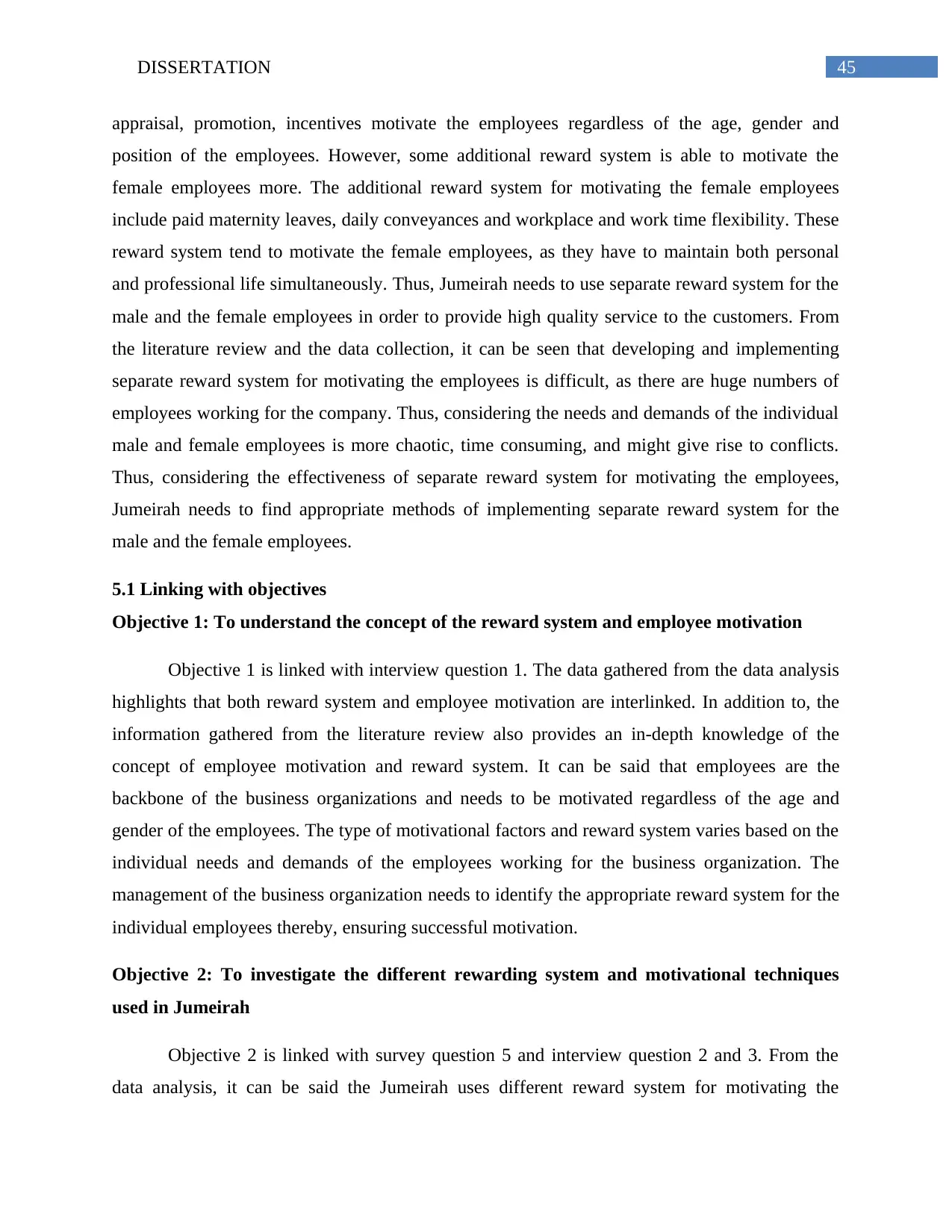
45DISSERTATION
appraisal, promotion, incentives motivate the employees regardless of the age, gender and
position of the employees. However, some additional reward system is able to motivate the
female employees more. The additional reward system for motivating the female employees
include paid maternity leaves, daily conveyances and workplace and work time flexibility. These
reward system tend to motivate the female employees, as they have to maintain both personal
and professional life simultaneously. Thus, Jumeirah needs to use separate reward system for the
male and the female employees in order to provide high quality service to the customers. From
the literature review and the data collection, it can be seen that developing and implementing
separate reward system for motivating the employees is difficult, as there are huge numbers of
employees working for the company. Thus, considering the needs and demands of the individual
male and female employees is more chaotic, time consuming, and might give rise to conflicts.
Thus, considering the effectiveness of separate reward system for motivating the employees,
Jumeirah needs to find appropriate methods of implementing separate reward system for the
male and the female employees.
5.1 Linking with objectives
Objective 1: To understand the concept of the reward system and employee motivation
Objective 1 is linked with interview question 1. The data gathered from the data analysis
highlights that both reward system and employee motivation are interlinked. In addition to, the
information gathered from the literature review also provides an in-depth knowledge of the
concept of employee motivation and reward system. It can be said that employees are the
backbone of the business organizations and needs to be motivated regardless of the age and
gender of the employees. The type of motivational factors and reward system varies based on the
individual needs and demands of the employees working for the business organization. The
management of the business organization needs to identify the appropriate reward system for the
individual employees thereby, ensuring successful motivation.
Objective 2: To investigate the different rewarding system and motivational techniques
used in Jumeirah
Objective 2 is linked with survey question 5 and interview question 2 and 3. From the
data analysis, it can be said the Jumeirah uses different reward system for motivating the
appraisal, promotion, incentives motivate the employees regardless of the age, gender and
position of the employees. However, some additional reward system is able to motivate the
female employees more. The additional reward system for motivating the female employees
include paid maternity leaves, daily conveyances and workplace and work time flexibility. These
reward system tend to motivate the female employees, as they have to maintain both personal
and professional life simultaneously. Thus, Jumeirah needs to use separate reward system for the
male and the female employees in order to provide high quality service to the customers. From
the literature review and the data collection, it can be seen that developing and implementing
separate reward system for motivating the employees is difficult, as there are huge numbers of
employees working for the company. Thus, considering the needs and demands of the individual
male and female employees is more chaotic, time consuming, and might give rise to conflicts.
Thus, considering the effectiveness of separate reward system for motivating the employees,
Jumeirah needs to find appropriate methods of implementing separate reward system for the
male and the female employees.
5.1 Linking with objectives
Objective 1: To understand the concept of the reward system and employee motivation
Objective 1 is linked with interview question 1. The data gathered from the data analysis
highlights that both reward system and employee motivation are interlinked. In addition to, the
information gathered from the literature review also provides an in-depth knowledge of the
concept of employee motivation and reward system. It can be said that employees are the
backbone of the business organizations and needs to be motivated regardless of the age and
gender of the employees. The type of motivational factors and reward system varies based on the
individual needs and demands of the employees working for the business organization. The
management of the business organization needs to identify the appropriate reward system for the
individual employees thereby, ensuring successful motivation.
Objective 2: To investigate the different rewarding system and motivational techniques
used in Jumeirah
Objective 2 is linked with survey question 5 and interview question 2 and 3. From the
data analysis, it can be said the Jumeirah uses different reward system for motivating the
Secure Best Marks with AI Grader
Need help grading? Try our AI Grader for instant feedback on your assignments.
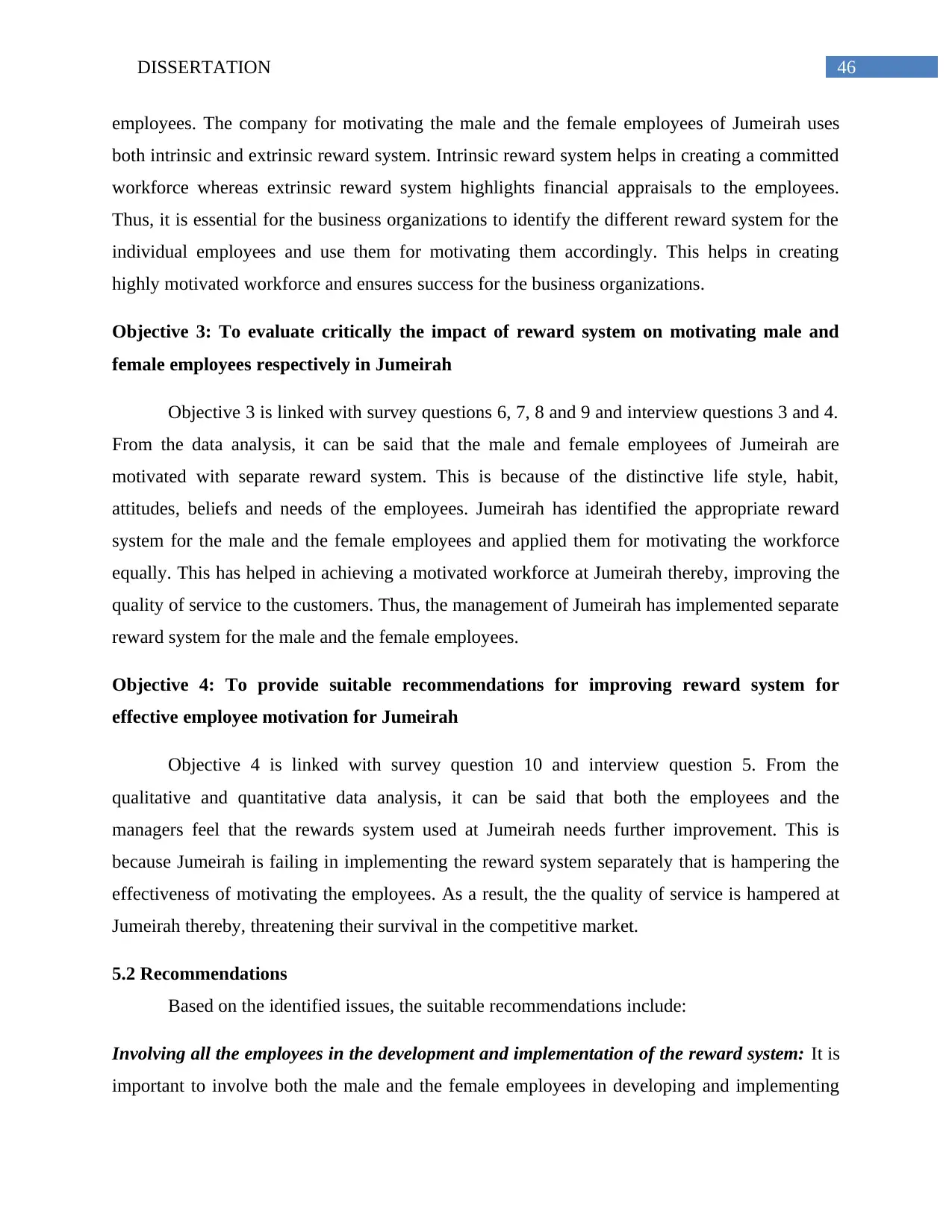
46DISSERTATION
employees. The company for motivating the male and the female employees of Jumeirah uses
both intrinsic and extrinsic reward system. Intrinsic reward system helps in creating a committed
workforce whereas extrinsic reward system highlights financial appraisals to the employees.
Thus, it is essential for the business organizations to identify the different reward system for the
individual employees and use them for motivating them accordingly. This helps in creating
highly motivated workforce and ensures success for the business organizations.
Objective 3: To evaluate critically the impact of reward system on motivating male and
female employees respectively in Jumeirah
Objective 3 is linked with survey questions 6, 7, 8 and 9 and interview questions 3 and 4.
From the data analysis, it can be said that the male and female employees of Jumeirah are
motivated with separate reward system. This is because of the distinctive life style, habit,
attitudes, beliefs and needs of the employees. Jumeirah has identified the appropriate reward
system for the male and the female employees and applied them for motivating the workforce
equally. This has helped in achieving a motivated workforce at Jumeirah thereby, improving the
quality of service to the customers. Thus, the management of Jumeirah has implemented separate
reward system for the male and the female employees.
Objective 4: To provide suitable recommendations for improving reward system for
effective employee motivation for Jumeirah
Objective 4 is linked with survey question 10 and interview question 5. From the
qualitative and quantitative data analysis, it can be said that both the employees and the
managers feel that the rewards system used at Jumeirah needs further improvement. This is
because Jumeirah is failing in implementing the reward system separately that is hampering the
effectiveness of motivating the employees. As a result, the the quality of service is hampered at
Jumeirah thereby, threatening their survival in the competitive market.
5.2 Recommendations
Based on the identified issues, the suitable recommendations include:
Involving all the employees in the development and implementation of the reward system: It is
important to involve both the male and the female employees in developing and implementing
employees. The company for motivating the male and the female employees of Jumeirah uses
both intrinsic and extrinsic reward system. Intrinsic reward system helps in creating a committed
workforce whereas extrinsic reward system highlights financial appraisals to the employees.
Thus, it is essential for the business organizations to identify the different reward system for the
individual employees and use them for motivating them accordingly. This helps in creating
highly motivated workforce and ensures success for the business organizations.
Objective 3: To evaluate critically the impact of reward system on motivating male and
female employees respectively in Jumeirah
Objective 3 is linked with survey questions 6, 7, 8 and 9 and interview questions 3 and 4.
From the data analysis, it can be said that the male and female employees of Jumeirah are
motivated with separate reward system. This is because of the distinctive life style, habit,
attitudes, beliefs and needs of the employees. Jumeirah has identified the appropriate reward
system for the male and the female employees and applied them for motivating the workforce
equally. This has helped in achieving a motivated workforce at Jumeirah thereby, improving the
quality of service to the customers. Thus, the management of Jumeirah has implemented separate
reward system for the male and the female employees.
Objective 4: To provide suitable recommendations for improving reward system for
effective employee motivation for Jumeirah
Objective 4 is linked with survey question 10 and interview question 5. From the
qualitative and quantitative data analysis, it can be said that both the employees and the
managers feel that the rewards system used at Jumeirah needs further improvement. This is
because Jumeirah is failing in implementing the reward system separately that is hampering the
effectiveness of motivating the employees. As a result, the the quality of service is hampered at
Jumeirah thereby, threatening their survival in the competitive market.
5.2 Recommendations
Based on the identified issues, the suitable recommendations include:
Involving all the employees in the development and implementation of the reward system: It is
important to involve both the male and the female employees in developing and implementing
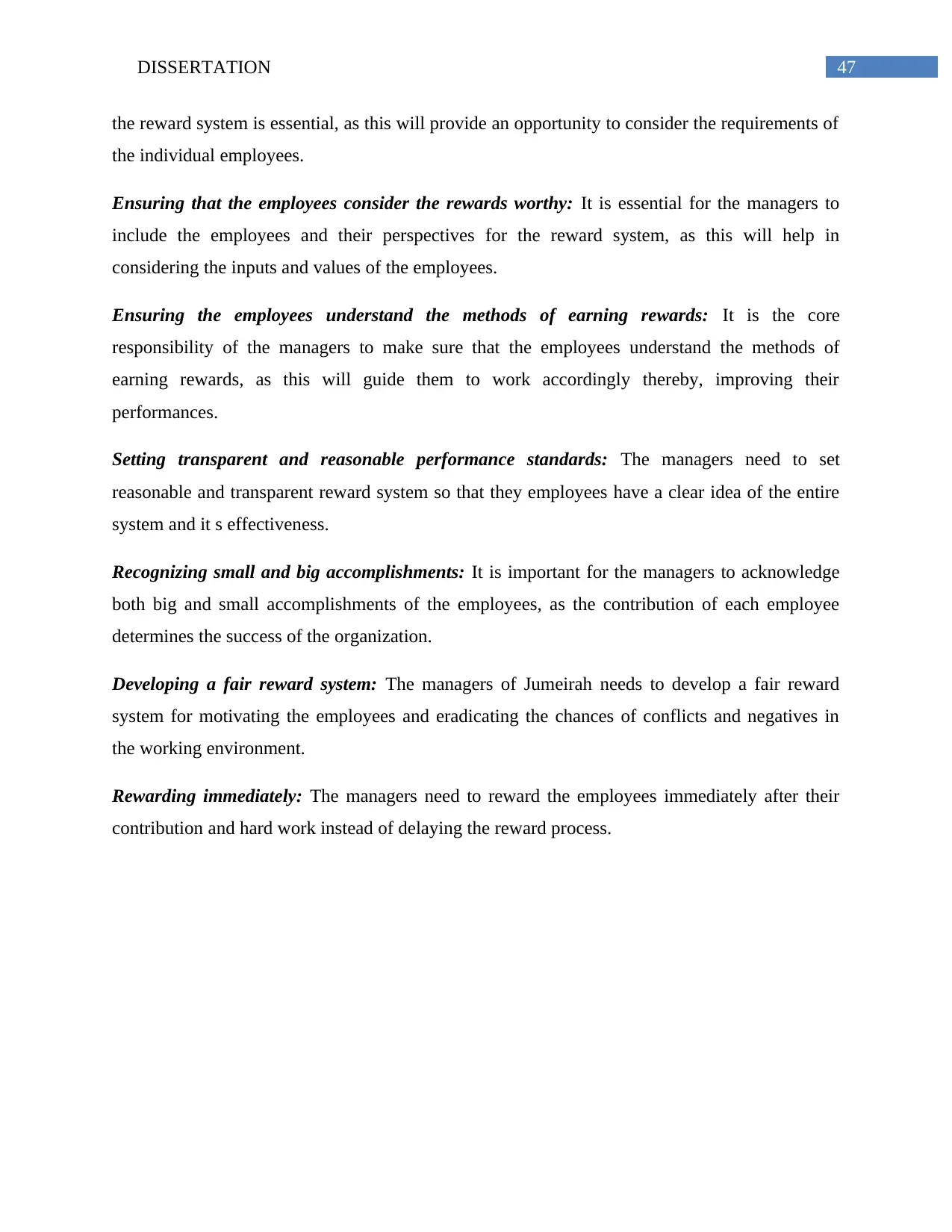
47DISSERTATION
the reward system is essential, as this will provide an opportunity to consider the requirements of
the individual employees.
Ensuring that the employees consider the rewards worthy: It is essential for the managers to
include the employees and their perspectives for the reward system, as this will help in
considering the inputs and values of the employees.
Ensuring the employees understand the methods of earning rewards: It is the core
responsibility of the managers to make sure that the employees understand the methods of
earning rewards, as this will guide them to work accordingly thereby, improving their
performances.
Setting transparent and reasonable performance standards: The managers need to set
reasonable and transparent reward system so that they employees have a clear idea of the entire
system and it s effectiveness.
Recognizing small and big accomplishments: It is important for the managers to acknowledge
both big and small accomplishments of the employees, as the contribution of each employee
determines the success of the organization.
Developing a fair reward system: The managers of Jumeirah needs to develop a fair reward
system for motivating the employees and eradicating the chances of conflicts and negatives in
the working environment.
Rewarding immediately: The managers need to reward the employees immediately after their
contribution and hard work instead of delaying the reward process.
the reward system is essential, as this will provide an opportunity to consider the requirements of
the individual employees.
Ensuring that the employees consider the rewards worthy: It is essential for the managers to
include the employees and their perspectives for the reward system, as this will help in
considering the inputs and values of the employees.
Ensuring the employees understand the methods of earning rewards: It is the core
responsibility of the managers to make sure that the employees understand the methods of
earning rewards, as this will guide them to work accordingly thereby, improving their
performances.
Setting transparent and reasonable performance standards: The managers need to set
reasonable and transparent reward system so that they employees have a clear idea of the entire
system and it s effectiveness.
Recognizing small and big accomplishments: It is important for the managers to acknowledge
both big and small accomplishments of the employees, as the contribution of each employee
determines the success of the organization.
Developing a fair reward system: The managers of Jumeirah needs to develop a fair reward
system for motivating the employees and eradicating the chances of conflicts and negatives in
the working environment.
Rewarding immediately: The managers need to reward the employees immediately after their
contribution and hard work instead of delaying the reward process.
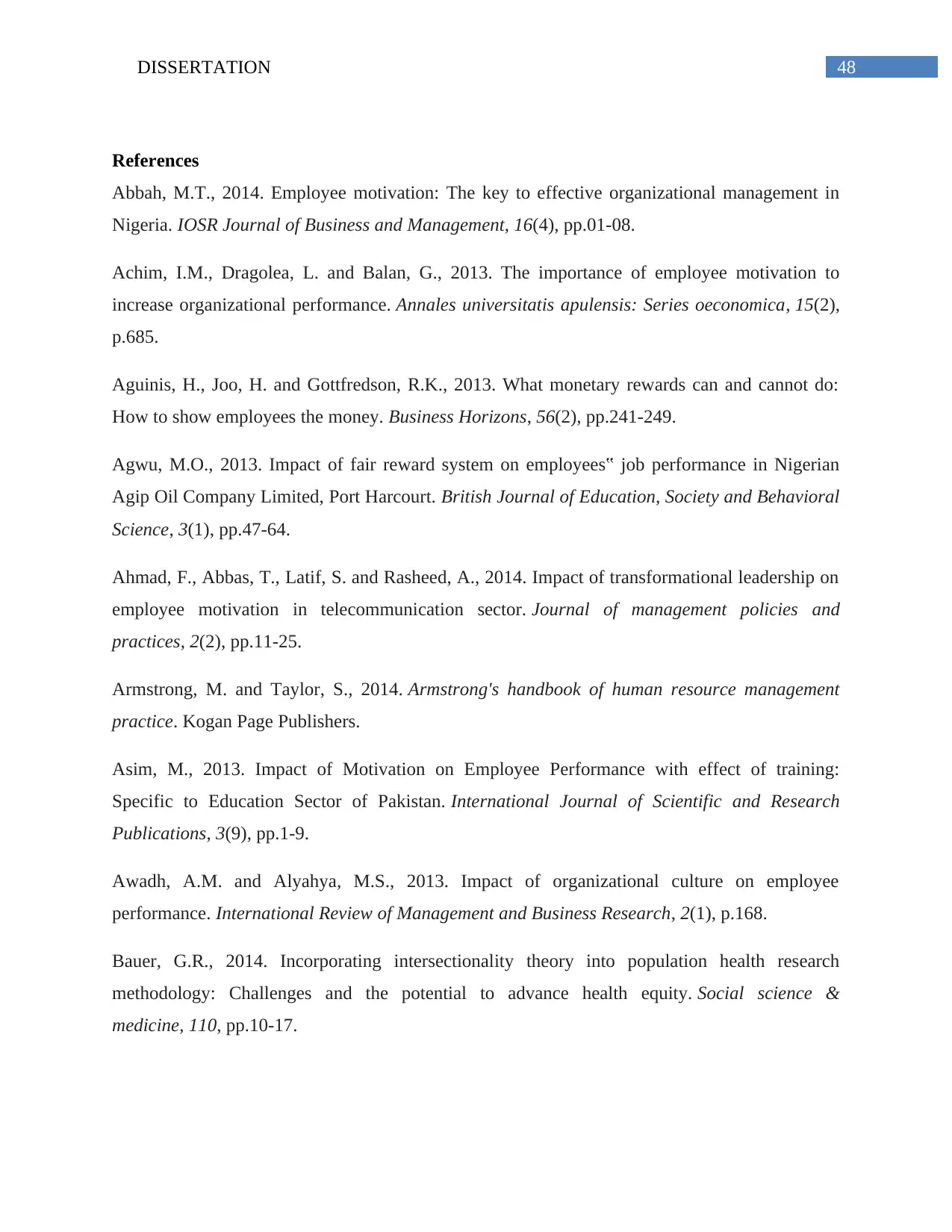
48DISSERTATION
References
Abbah, M.T., 2014. Employee motivation: The key to effective organizational management in
Nigeria. IOSR Journal of Business and Management, 16(4), pp.01-08.
Achim, I.M., Dragolea, L. and Balan, G., 2013. The importance of employee motivation to
increase organizational performance. Annales universitatis apulensis: Series oeconomica, 15(2),
p.685.
Aguinis, H., Joo, H. and Gottfredson, R.K., 2013. What monetary rewards can and cannot do:
How to show employees the money. Business Horizons, 56(2), pp.241-249.
Agwu, M.O., 2013. Impact of fair reward system on employees‟ job performance in Nigerian
Agip Oil Company Limited, Port Harcourt. British Journal of Education, Society and Behavioral
Science, 3(1), pp.47-64.
Ahmad, F., Abbas, T., Latif, S. and Rasheed, A., 2014. Impact of transformational leadership on
employee motivation in telecommunication sector. Journal of management policies and
practices, 2(2), pp.11-25.
Armstrong, M. and Taylor, S., 2014. Armstrong's handbook of human resource management
practice. Kogan Page Publishers.
Asim, M., 2013. Impact of Motivation on Employee Performance with effect of training:
Specific to Education Sector of Pakistan. International Journal of Scientific and Research
Publications, 3(9), pp.1-9.
Awadh, A.M. and Alyahya, M.S., 2013. Impact of organizational culture on employee
performance. International Review of Management and Business Research, 2(1), p.168.
Bauer, G.R., 2014. Incorporating intersectionality theory into population health research
methodology: Challenges and the potential to advance health equity. Social science &
medicine, 110, pp.10-17.
References
Abbah, M.T., 2014. Employee motivation: The key to effective organizational management in
Nigeria. IOSR Journal of Business and Management, 16(4), pp.01-08.
Achim, I.M., Dragolea, L. and Balan, G., 2013. The importance of employee motivation to
increase organizational performance. Annales universitatis apulensis: Series oeconomica, 15(2),
p.685.
Aguinis, H., Joo, H. and Gottfredson, R.K., 2013. What monetary rewards can and cannot do:
How to show employees the money. Business Horizons, 56(2), pp.241-249.
Agwu, M.O., 2013. Impact of fair reward system on employees‟ job performance in Nigerian
Agip Oil Company Limited, Port Harcourt. British Journal of Education, Society and Behavioral
Science, 3(1), pp.47-64.
Ahmad, F., Abbas, T., Latif, S. and Rasheed, A., 2014. Impact of transformational leadership on
employee motivation in telecommunication sector. Journal of management policies and
practices, 2(2), pp.11-25.
Armstrong, M. and Taylor, S., 2014. Armstrong's handbook of human resource management
practice. Kogan Page Publishers.
Asim, M., 2013. Impact of Motivation on Employee Performance with effect of training:
Specific to Education Sector of Pakistan. International Journal of Scientific and Research
Publications, 3(9), pp.1-9.
Awadh, A.M. and Alyahya, M.S., 2013. Impact of organizational culture on employee
performance. International Review of Management and Business Research, 2(1), p.168.
Bauer, G.R., 2014. Incorporating intersectionality theory into population health research
methodology: Challenges and the potential to advance health equity. Social science &
medicine, 110, pp.10-17.
Paraphrase This Document
Need a fresh take? Get an instant paraphrase of this document with our AI Paraphraser
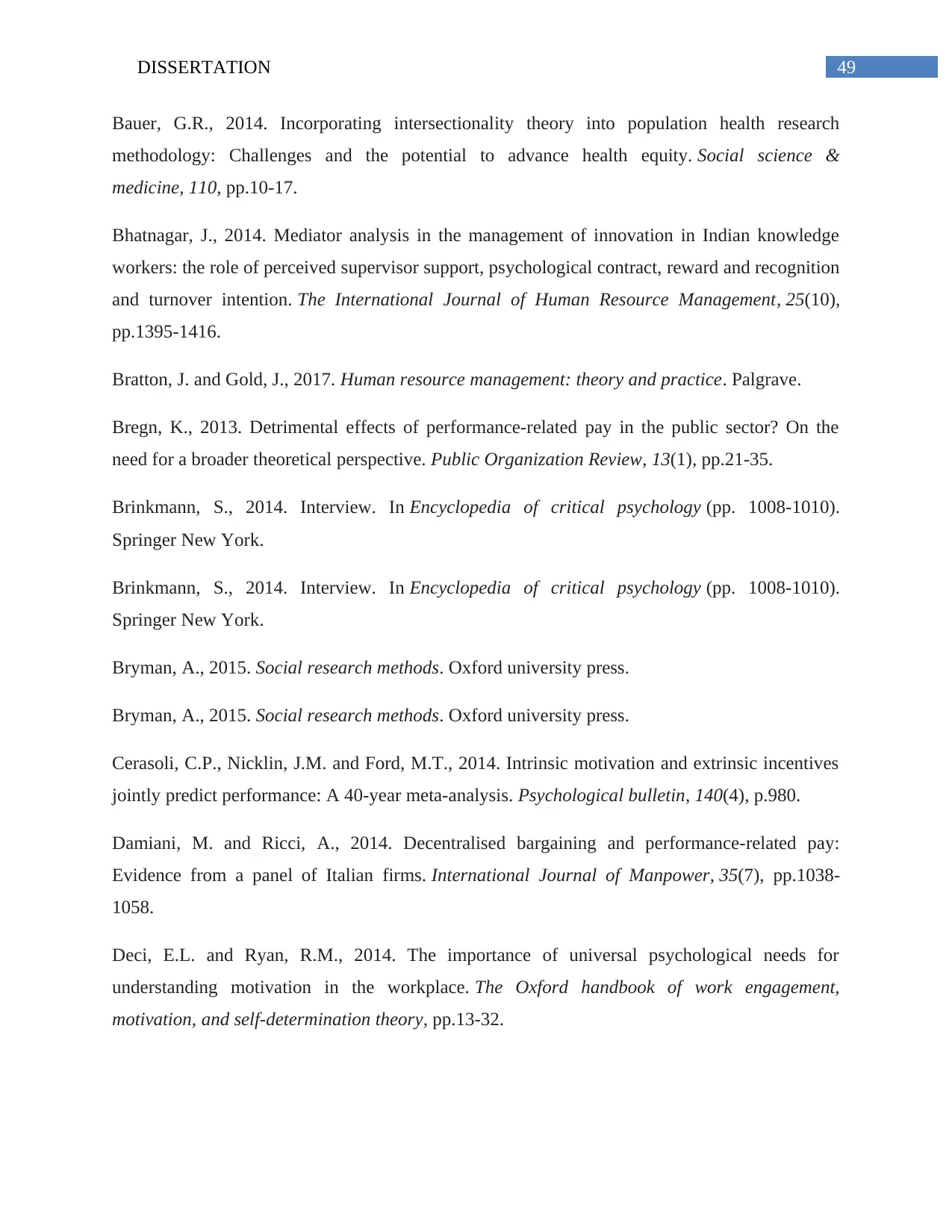
49DISSERTATION
Bauer, G.R., 2014. Incorporating intersectionality theory into population health research
methodology: Challenges and the potential to advance health equity. Social science &
medicine, 110, pp.10-17.
Bhatnagar, J., 2014. Mediator analysis in the management of innovation in Indian knowledge
workers: the role of perceived supervisor support, psychological contract, reward and recognition
and turnover intention. The International Journal of Human Resource Management, 25(10),
pp.1395-1416.
Bratton, J. and Gold, J., 2017. Human resource management: theory and practice. Palgrave.
Bregn, K., 2013. Detrimental effects of performance-related pay in the public sector? On the
need for a broader theoretical perspective. Public Organization Review, 13(1), pp.21-35.
Brinkmann, S., 2014. Interview. In Encyclopedia of critical psychology (pp. 1008-1010).
Springer New York.
Brinkmann, S., 2014. Interview. In Encyclopedia of critical psychology (pp. 1008-1010).
Springer New York.
Bryman, A., 2015. Social research methods. Oxford university press.
Bryman, A., 2015. Social research methods. Oxford university press.
Cerasoli, C.P., Nicklin, J.M. and Ford, M.T., 2014. Intrinsic motivation and extrinsic incentives
jointly predict performance: A 40-year meta-analysis. Psychological bulletin, 140(4), p.980.
Damiani, M. and Ricci, A., 2014. Decentralised bargaining and performance-related pay:
Evidence from a panel of Italian firms. International Journal of Manpower, 35(7), pp.1038-
1058.
Deci, E.L. and Ryan, R.M., 2014. The importance of universal psychological needs for
understanding motivation in the workplace. The Oxford handbook of work engagement,
motivation, and self-determination theory, pp.13-32.
Bauer, G.R., 2014. Incorporating intersectionality theory into population health research
methodology: Challenges and the potential to advance health equity. Social science &
medicine, 110, pp.10-17.
Bhatnagar, J., 2014. Mediator analysis in the management of innovation in Indian knowledge
workers: the role of perceived supervisor support, psychological contract, reward and recognition
and turnover intention. The International Journal of Human Resource Management, 25(10),
pp.1395-1416.
Bratton, J. and Gold, J., 2017. Human resource management: theory and practice. Palgrave.
Bregn, K., 2013. Detrimental effects of performance-related pay in the public sector? On the
need for a broader theoretical perspective. Public Organization Review, 13(1), pp.21-35.
Brinkmann, S., 2014. Interview. In Encyclopedia of critical psychology (pp. 1008-1010).
Springer New York.
Brinkmann, S., 2014. Interview. In Encyclopedia of critical psychology (pp. 1008-1010).
Springer New York.
Bryman, A., 2015. Social research methods. Oxford university press.
Bryman, A., 2015. Social research methods. Oxford university press.
Cerasoli, C.P., Nicklin, J.M. and Ford, M.T., 2014. Intrinsic motivation and extrinsic incentives
jointly predict performance: A 40-year meta-analysis. Psychological bulletin, 140(4), p.980.
Damiani, M. and Ricci, A., 2014. Decentralised bargaining and performance-related pay:
Evidence from a panel of Italian firms. International Journal of Manpower, 35(7), pp.1038-
1058.
Deci, E.L. and Ryan, R.M., 2014. The importance of universal psychological needs for
understanding motivation in the workplace. The Oxford handbook of work engagement,
motivation, and self-determination theory, pp.13-32.
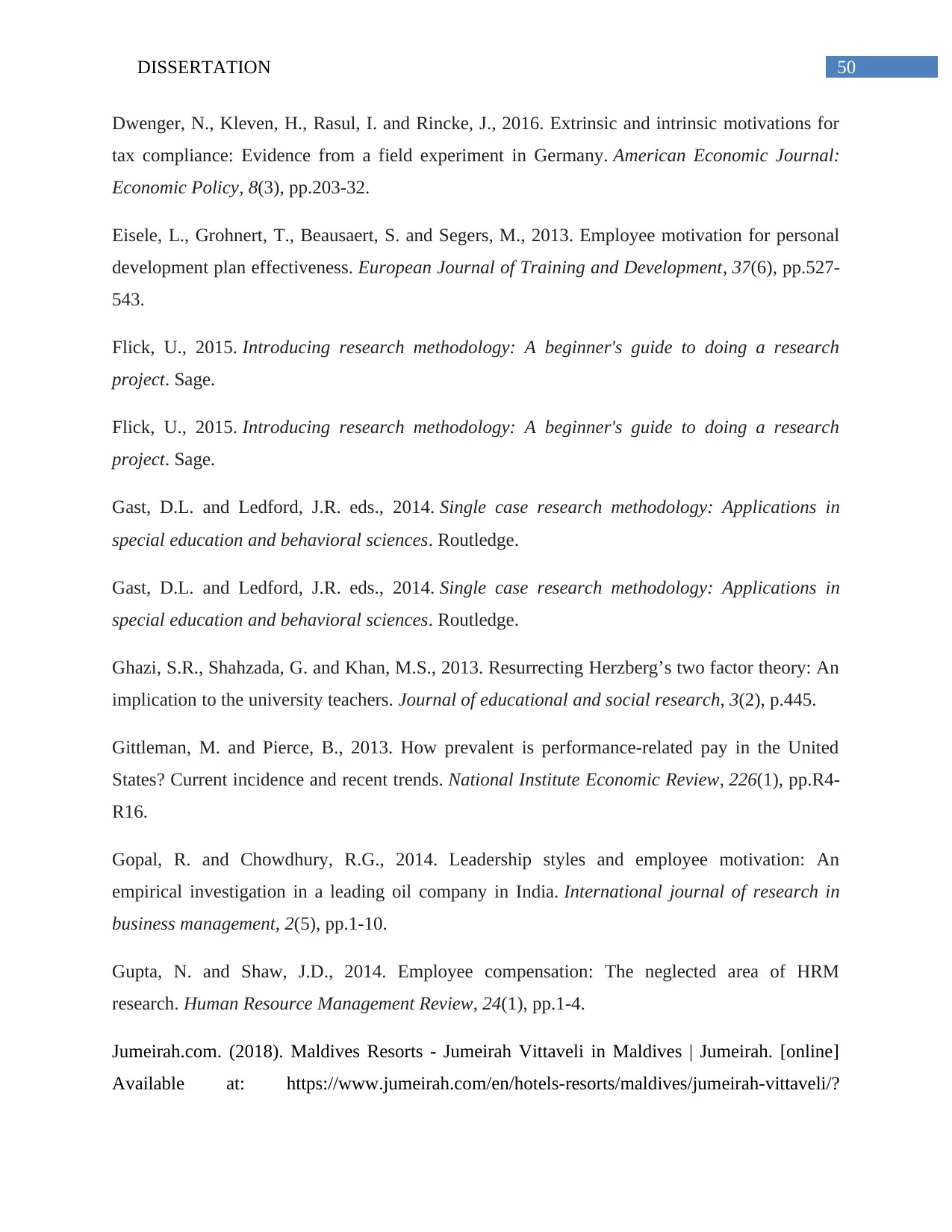
50DISSERTATION
Dwenger, N., Kleven, H., Rasul, I. and Rincke, J., 2016. Extrinsic and intrinsic motivations for
tax compliance: Evidence from a field experiment in Germany. American Economic Journal:
Economic Policy, 8(3), pp.203-32.
Eisele, L., Grohnert, T., Beausaert, S. and Segers, M., 2013. Employee motivation for personal
development plan effectiveness. European Journal of Training and Development, 37(6), pp.527-
543.
Flick, U., 2015. Introducing research methodology: A beginner's guide to doing a research
project. Sage.
Flick, U., 2015. Introducing research methodology: A beginner's guide to doing a research
project. Sage.
Gast, D.L. and Ledford, J.R. eds., 2014. Single case research methodology: Applications in
special education and behavioral sciences. Routledge.
Gast, D.L. and Ledford, J.R. eds., 2014. Single case research methodology: Applications in
special education and behavioral sciences. Routledge.
Ghazi, S.R., Shahzada, G. and Khan, M.S., 2013. Resurrecting Herzberg’s two factor theory: An
implication to the university teachers. Journal of educational and social research, 3(2), p.445.
Gittleman, M. and Pierce, B., 2013. How prevalent is performance-related pay in the United
States? Current incidence and recent trends. National Institute Economic Review, 226(1), pp.R4-
R16.
Gopal, R. and Chowdhury, R.G., 2014. Leadership styles and employee motivation: An
empirical investigation in a leading oil company in India. International journal of research in
business management, 2(5), pp.1-10.
Gupta, N. and Shaw, J.D., 2014. Employee compensation: The neglected area of HRM
research. Human Resource Management Review, 24(1), pp.1-4.
Jumeirah.com. (2018). Maldives Resorts - Jumeirah Vittaveli in Maldives | Jumeirah. [online]
Available at: https://www.jumeirah.com/en/hotels-resorts/maldives/jumeirah-vittaveli/?
Dwenger, N., Kleven, H., Rasul, I. and Rincke, J., 2016. Extrinsic and intrinsic motivations for
tax compliance: Evidence from a field experiment in Germany. American Economic Journal:
Economic Policy, 8(3), pp.203-32.
Eisele, L., Grohnert, T., Beausaert, S. and Segers, M., 2013. Employee motivation for personal
development plan effectiveness. European Journal of Training and Development, 37(6), pp.527-
543.
Flick, U., 2015. Introducing research methodology: A beginner's guide to doing a research
project. Sage.
Flick, U., 2015. Introducing research methodology: A beginner's guide to doing a research
project. Sage.
Gast, D.L. and Ledford, J.R. eds., 2014. Single case research methodology: Applications in
special education and behavioral sciences. Routledge.
Gast, D.L. and Ledford, J.R. eds., 2014. Single case research methodology: Applications in
special education and behavioral sciences. Routledge.
Ghazi, S.R., Shahzada, G. and Khan, M.S., 2013. Resurrecting Herzberg’s two factor theory: An
implication to the university teachers. Journal of educational and social research, 3(2), p.445.
Gittleman, M. and Pierce, B., 2013. How prevalent is performance-related pay in the United
States? Current incidence and recent trends. National Institute Economic Review, 226(1), pp.R4-
R16.
Gopal, R. and Chowdhury, R.G., 2014. Leadership styles and employee motivation: An
empirical investigation in a leading oil company in India. International journal of research in
business management, 2(5), pp.1-10.
Gupta, N. and Shaw, J.D., 2014. Employee compensation: The neglected area of HRM
research. Human Resource Management Review, 24(1), pp.1-4.
Jumeirah.com. (2018). Maldives Resorts - Jumeirah Vittaveli in Maldives | Jumeirah. [online]
Available at: https://www.jumeirah.com/en/hotels-resorts/maldives/jumeirah-vittaveli/?
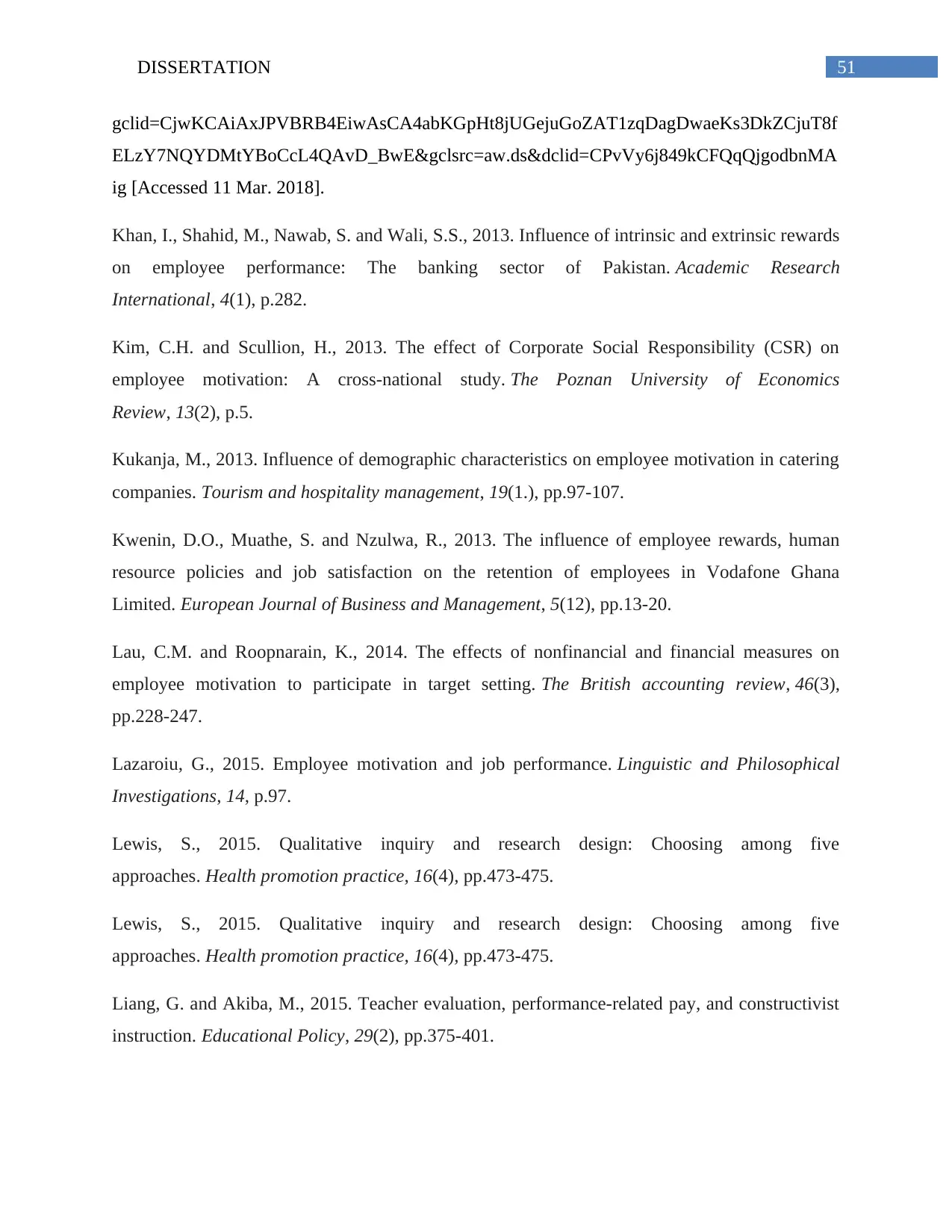
51DISSERTATION
gclid=CjwKCAiAxJPVBRB4EiwAsCA4abKGpHt8jUGejuGoZAT1zqDagDwaeKs3DkZCjuT8f
ELzY7NQYDMtYBoCcL4QAvD_BwE&gclsrc=aw.ds&dclid=CPvVy6j849kCFQqQjgodbnMA
ig [Accessed 11 Mar. 2018].
Khan, I., Shahid, M., Nawab, S. and Wali, S.S., 2013. Influence of intrinsic and extrinsic rewards
on employee performance: The banking sector of Pakistan. Academic Research
International, 4(1), p.282.
Kim, C.H. and Scullion, H., 2013. The effect of Corporate Social Responsibility (CSR) on
employee motivation: A cross-national study. The Poznan University of Economics
Review, 13(2), p.5.
Kukanja, M., 2013. Influence of demographic characteristics on employee motivation in catering
companies. Tourism and hospitality management, 19(1.), pp.97-107.
Kwenin, D.O., Muathe, S. and Nzulwa, R., 2013. The influence of employee rewards, human
resource policies and job satisfaction on the retention of employees in Vodafone Ghana
Limited. European Journal of Business and Management, 5(12), pp.13-20.
Lau, C.M. and Roopnarain, K., 2014. The effects of nonfinancial and financial measures on
employee motivation to participate in target setting. The British accounting review, 46(3),
pp.228-247.
Lazaroiu, G., 2015. Employee motivation and job performance. Linguistic and Philosophical
Investigations, 14, p.97.
Lewis, S., 2015. Qualitative inquiry and research design: Choosing among five
approaches. Health promotion practice, 16(4), pp.473-475.
Lewis, S., 2015. Qualitative inquiry and research design: Choosing among five
approaches. Health promotion practice, 16(4), pp.473-475.
Liang, G. and Akiba, M., 2015. Teacher evaluation, performance-related pay, and constructivist
instruction. Educational Policy, 29(2), pp.375-401.
gclid=CjwKCAiAxJPVBRB4EiwAsCA4abKGpHt8jUGejuGoZAT1zqDagDwaeKs3DkZCjuT8f
ELzY7NQYDMtYBoCcL4QAvD_BwE&gclsrc=aw.ds&dclid=CPvVy6j849kCFQqQjgodbnMA
ig [Accessed 11 Mar. 2018].
Khan, I., Shahid, M., Nawab, S. and Wali, S.S., 2013. Influence of intrinsic and extrinsic rewards
on employee performance: The banking sector of Pakistan. Academic Research
International, 4(1), p.282.
Kim, C.H. and Scullion, H., 2013. The effect of Corporate Social Responsibility (CSR) on
employee motivation: A cross-national study. The Poznan University of Economics
Review, 13(2), p.5.
Kukanja, M., 2013. Influence of demographic characteristics on employee motivation in catering
companies. Tourism and hospitality management, 19(1.), pp.97-107.
Kwenin, D.O., Muathe, S. and Nzulwa, R., 2013. The influence of employee rewards, human
resource policies and job satisfaction on the retention of employees in Vodafone Ghana
Limited. European Journal of Business and Management, 5(12), pp.13-20.
Lau, C.M. and Roopnarain, K., 2014. The effects of nonfinancial and financial measures on
employee motivation to participate in target setting. The British accounting review, 46(3),
pp.228-247.
Lazaroiu, G., 2015. Employee motivation and job performance. Linguistic and Philosophical
Investigations, 14, p.97.
Lewis, S., 2015. Qualitative inquiry and research design: Choosing among five
approaches. Health promotion practice, 16(4), pp.473-475.
Lewis, S., 2015. Qualitative inquiry and research design: Choosing among five
approaches. Health promotion practice, 16(4), pp.473-475.
Liang, G. and Akiba, M., 2015. Teacher evaluation, performance-related pay, and constructivist
instruction. Educational Policy, 29(2), pp.375-401.
Secure Best Marks with AI Grader
Need help grading? Try our AI Grader for instant feedback on your assignments.
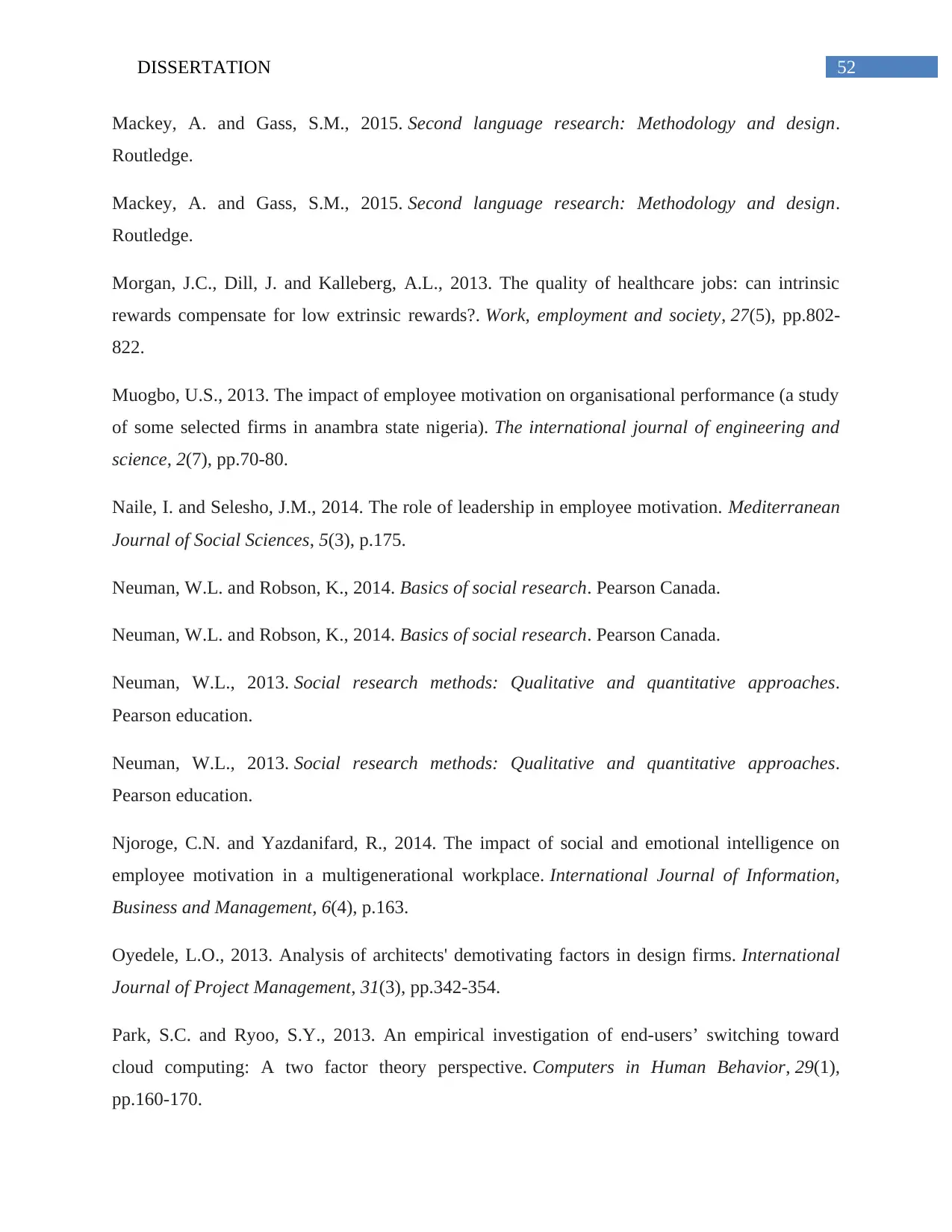
52DISSERTATION
Mackey, A. and Gass, S.M., 2015. Second language research: Methodology and design.
Routledge.
Mackey, A. and Gass, S.M., 2015. Second language research: Methodology and design.
Routledge.
Morgan, J.C., Dill, J. and Kalleberg, A.L., 2013. The quality of healthcare jobs: can intrinsic
rewards compensate for low extrinsic rewards?. Work, employment and society, 27(5), pp.802-
822.
Muogbo, U.S., 2013. The impact of employee motivation on organisational performance (a study
of some selected firms in anambra state nigeria). The international journal of engineering and
science, 2(7), pp.70-80.
Naile, I. and Selesho, J.M., 2014. The role of leadership in employee motivation. Mediterranean
Journal of Social Sciences, 5(3), p.175.
Neuman, W.L. and Robson, K., 2014. Basics of social research. Pearson Canada.
Neuman, W.L. and Robson, K., 2014. Basics of social research. Pearson Canada.
Neuman, W.L., 2013. Social research methods: Qualitative and quantitative approaches.
Pearson education.
Neuman, W.L., 2013. Social research methods: Qualitative and quantitative approaches.
Pearson education.
Njoroge, C.N. and Yazdanifard, R., 2014. The impact of social and emotional intelligence on
employee motivation in a multigenerational workplace. International Journal of Information,
Business and Management, 6(4), p.163.
Oyedele, L.O., 2013. Analysis of architects' demotivating factors in design firms. International
Journal of Project Management, 31(3), pp.342-354.
Park, S.C. and Ryoo, S.Y., 2013. An empirical investigation of end-users’ switching toward
cloud computing: A two factor theory perspective. Computers in Human Behavior, 29(1),
pp.160-170.
Mackey, A. and Gass, S.M., 2015. Second language research: Methodology and design.
Routledge.
Mackey, A. and Gass, S.M., 2015. Second language research: Methodology and design.
Routledge.
Morgan, J.C., Dill, J. and Kalleberg, A.L., 2013. The quality of healthcare jobs: can intrinsic
rewards compensate for low extrinsic rewards?. Work, employment and society, 27(5), pp.802-
822.
Muogbo, U.S., 2013. The impact of employee motivation on organisational performance (a study
of some selected firms in anambra state nigeria). The international journal of engineering and
science, 2(7), pp.70-80.
Naile, I. and Selesho, J.M., 2014. The role of leadership in employee motivation. Mediterranean
Journal of Social Sciences, 5(3), p.175.
Neuman, W.L. and Robson, K., 2014. Basics of social research. Pearson Canada.
Neuman, W.L. and Robson, K., 2014. Basics of social research. Pearson Canada.
Neuman, W.L., 2013. Social research methods: Qualitative and quantitative approaches.
Pearson education.
Neuman, W.L., 2013. Social research methods: Qualitative and quantitative approaches.
Pearson education.
Njoroge, C.N. and Yazdanifard, R., 2014. The impact of social and emotional intelligence on
employee motivation in a multigenerational workplace. International Journal of Information,
Business and Management, 6(4), p.163.
Oyedele, L.O., 2013. Analysis of architects' demotivating factors in design firms. International
Journal of Project Management, 31(3), pp.342-354.
Park, S.C. and Ryoo, S.Y., 2013. An empirical investigation of end-users’ switching toward
cloud computing: A two factor theory perspective. Computers in Human Behavior, 29(1),
pp.160-170.
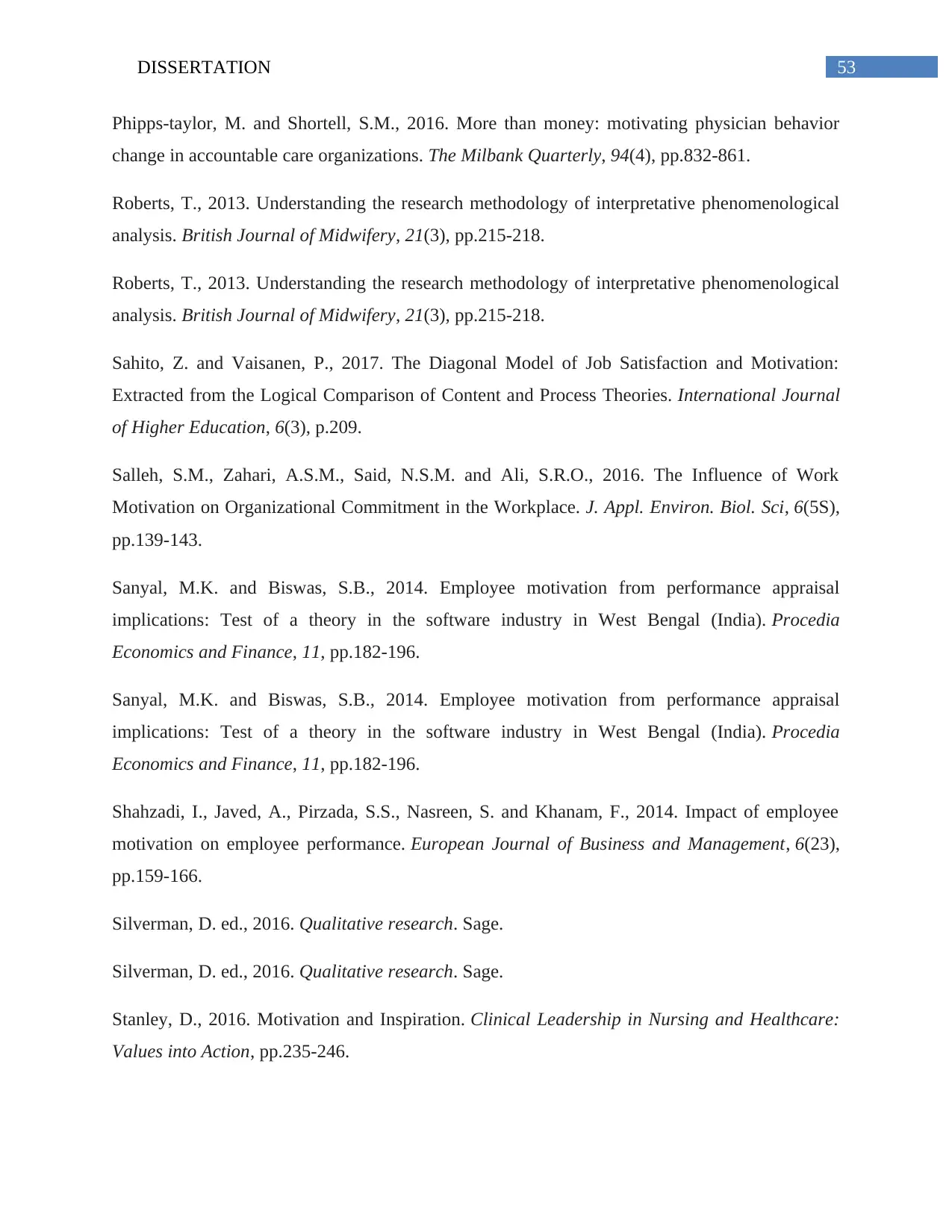
53DISSERTATION
Phipps‐taylor, M. and Shortell, S.M., 2016. More than money: motivating physician behavior
change in accountable care organizations. The Milbank Quarterly, 94(4), pp.832-861.
Roberts, T., 2013. Understanding the research methodology of interpretative phenomenological
analysis. British Journal of Midwifery, 21(3), pp.215-218.
Roberts, T., 2013. Understanding the research methodology of interpretative phenomenological
analysis. British Journal of Midwifery, 21(3), pp.215-218.
Sahito, Z. and Vaisanen, P., 2017. The Diagonal Model of Job Satisfaction and Motivation:
Extracted from the Logical Comparison of Content and Process Theories. International Journal
of Higher Education, 6(3), p.209.
Salleh, S.M., Zahari, A.S.M., Said, N.S.M. and Ali, S.R.O., 2016. The Influence of Work
Motivation on Organizational Commitment in the Workplace. J. Appl. Environ. Biol. Sci, 6(5S),
pp.139-143.
Sanyal, M.K. and Biswas, S.B., 2014. Employee motivation from performance appraisal
implications: Test of a theory in the software industry in West Bengal (India). Procedia
Economics and Finance, 11, pp.182-196.
Sanyal, M.K. and Biswas, S.B., 2014. Employee motivation from performance appraisal
implications: Test of a theory in the software industry in West Bengal (India). Procedia
Economics and Finance, 11, pp.182-196.
Shahzadi, I., Javed, A., Pirzada, S.S., Nasreen, S. and Khanam, F., 2014. Impact of employee
motivation on employee performance. European Journal of Business and Management, 6(23),
pp.159-166.
Silverman, D. ed., 2016. Qualitative research. Sage.
Silverman, D. ed., 2016. Qualitative research. Sage.
Stanley, D., 2016. Motivation and Inspiration. Clinical Leadership in Nursing and Healthcare:
Values into Action, pp.235-246.
Phipps‐taylor, M. and Shortell, S.M., 2016. More than money: motivating physician behavior
change in accountable care organizations. The Milbank Quarterly, 94(4), pp.832-861.
Roberts, T., 2013. Understanding the research methodology of interpretative phenomenological
analysis. British Journal of Midwifery, 21(3), pp.215-218.
Roberts, T., 2013. Understanding the research methodology of interpretative phenomenological
analysis. British Journal of Midwifery, 21(3), pp.215-218.
Sahito, Z. and Vaisanen, P., 2017. The Diagonal Model of Job Satisfaction and Motivation:
Extracted from the Logical Comparison of Content and Process Theories. International Journal
of Higher Education, 6(3), p.209.
Salleh, S.M., Zahari, A.S.M., Said, N.S.M. and Ali, S.R.O., 2016. The Influence of Work
Motivation on Organizational Commitment in the Workplace. J. Appl. Environ. Biol. Sci, 6(5S),
pp.139-143.
Sanyal, M.K. and Biswas, S.B., 2014. Employee motivation from performance appraisal
implications: Test of a theory in the software industry in West Bengal (India). Procedia
Economics and Finance, 11, pp.182-196.
Sanyal, M.K. and Biswas, S.B., 2014. Employee motivation from performance appraisal
implications: Test of a theory in the software industry in West Bengal (India). Procedia
Economics and Finance, 11, pp.182-196.
Shahzadi, I., Javed, A., Pirzada, S.S., Nasreen, S. and Khanam, F., 2014. Impact of employee
motivation on employee performance. European Journal of Business and Management, 6(23),
pp.159-166.
Silverman, D. ed., 2016. Qualitative research. Sage.
Silverman, D. ed., 2016. Qualitative research. Sage.
Stanley, D., 2016. Motivation and Inspiration. Clinical Leadership in Nursing and Healthcare:
Values into Action, pp.235-246.
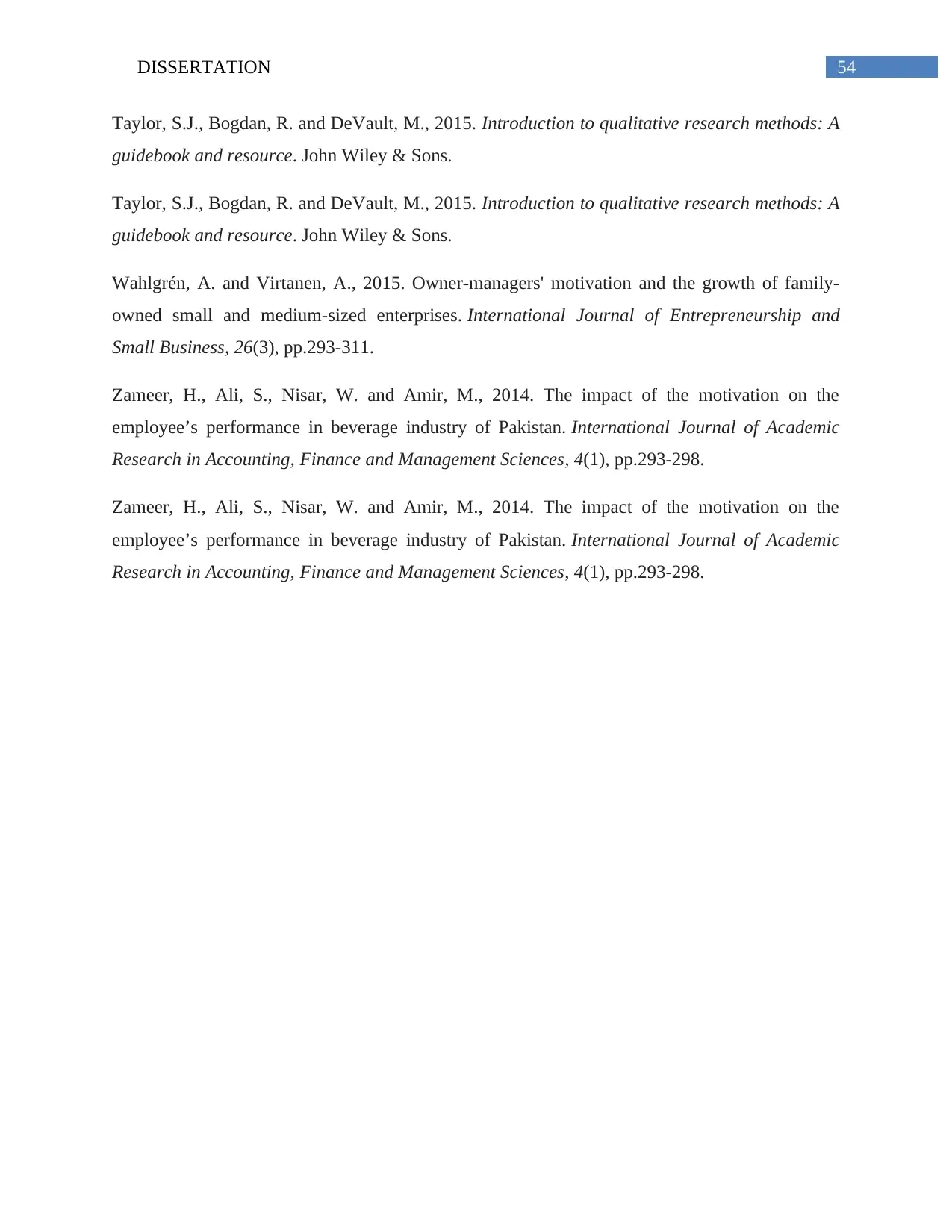
54DISSERTATION
Taylor, S.J., Bogdan, R. and DeVault, M., 2015. Introduction to qualitative research methods: A
guidebook and resource. John Wiley & Sons.
Taylor, S.J., Bogdan, R. and DeVault, M., 2015. Introduction to qualitative research methods: A
guidebook and resource. John Wiley & Sons.
Wahlgrén, A. and Virtanen, A., 2015. Owner-managers' motivation and the growth of family-
owned small and medium-sized enterprises. International Journal of Entrepreneurship and
Small Business, 26(3), pp.293-311.
Zameer, H., Ali, S., Nisar, W. and Amir, M., 2014. The impact of the motivation on the
employee’s performance in beverage industry of Pakistan. International Journal of Academic
Research in Accounting, Finance and Management Sciences, 4(1), pp.293-298.
Zameer, H., Ali, S., Nisar, W. and Amir, M., 2014. The impact of the motivation on the
employee’s performance in beverage industry of Pakistan. International Journal of Academic
Research in Accounting, Finance and Management Sciences, 4(1), pp.293-298.
Taylor, S.J., Bogdan, R. and DeVault, M., 2015. Introduction to qualitative research methods: A
guidebook and resource. John Wiley & Sons.
Taylor, S.J., Bogdan, R. and DeVault, M., 2015. Introduction to qualitative research methods: A
guidebook and resource. John Wiley & Sons.
Wahlgrén, A. and Virtanen, A., 2015. Owner-managers' motivation and the growth of family-
owned small and medium-sized enterprises. International Journal of Entrepreneurship and
Small Business, 26(3), pp.293-311.
Zameer, H., Ali, S., Nisar, W. and Amir, M., 2014. The impact of the motivation on the
employee’s performance in beverage industry of Pakistan. International Journal of Academic
Research in Accounting, Finance and Management Sciences, 4(1), pp.293-298.
Zameer, H., Ali, S., Nisar, W. and Amir, M., 2014. The impact of the motivation on the
employee’s performance in beverage industry of Pakistan. International Journal of Academic
Research in Accounting, Finance and Management Sciences, 4(1), pp.293-298.
Paraphrase This Document
Need a fresh take? Get an instant paraphrase of this document with our AI Paraphraser
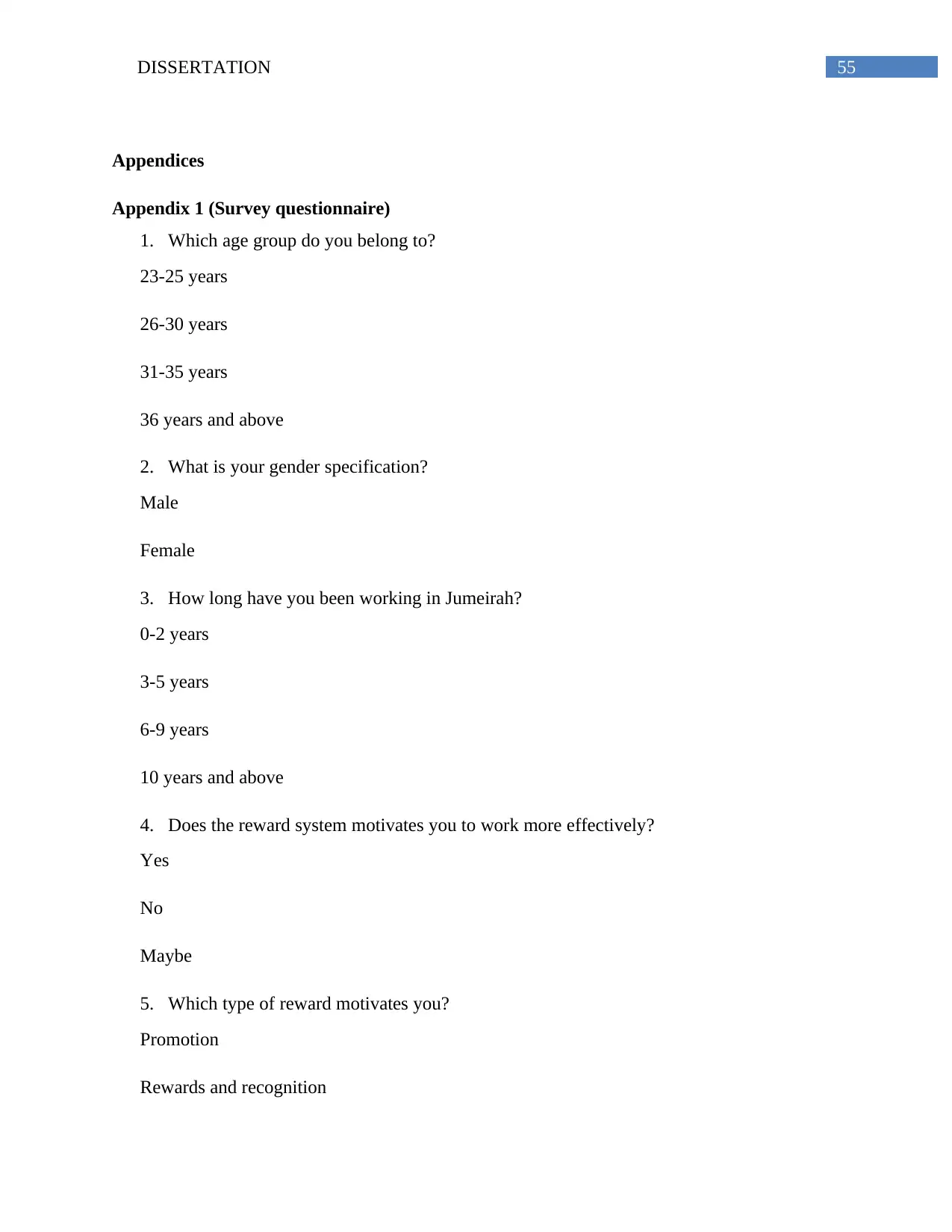
55DISSERTATION
Appendices
Appendix 1 (Survey questionnaire)
1. Which age group do you belong to?
23-25 years
26-30 years
31-35 years
36 years and above
2. What is your gender specification?
Male
Female
3. How long have you been working in Jumeirah?
0-2 years
3-5 years
6-9 years
10 years and above
4. Does the reward system motivates you to work more effectively?
Yes
No
Maybe
5. Which type of reward motivates you?
Promotion
Rewards and recognition
Appendices
Appendix 1 (Survey questionnaire)
1. Which age group do you belong to?
23-25 years
26-30 years
31-35 years
36 years and above
2. What is your gender specification?
Male
Female
3. How long have you been working in Jumeirah?
0-2 years
3-5 years
6-9 years
10 years and above
4. Does the reward system motivates you to work more effectively?
Yes
No
Maybe
5. Which type of reward motivates you?
Promotion
Rewards and recognition
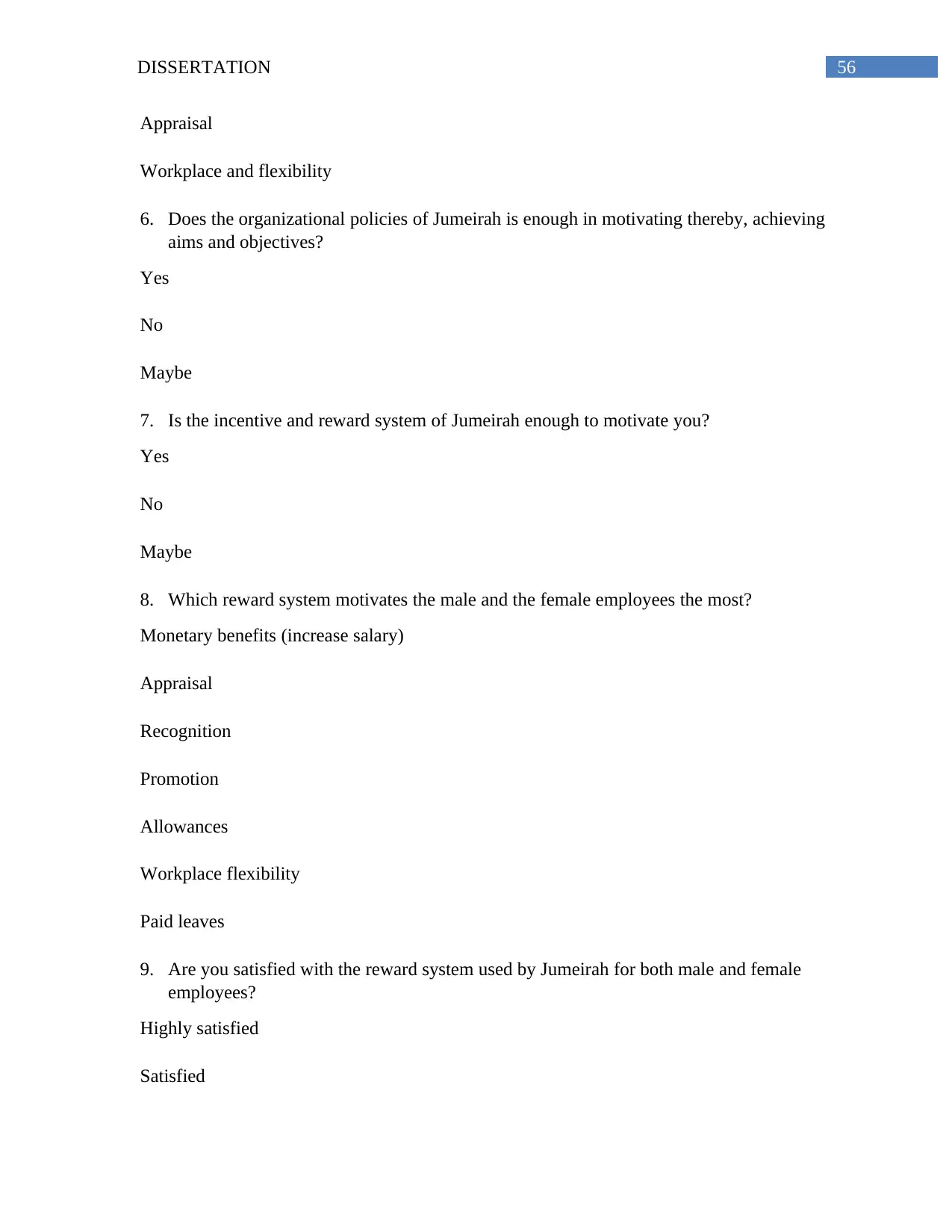
56DISSERTATION
Appraisal
Workplace and flexibility
6. Does the organizational policies of Jumeirah is enough in motivating thereby, achieving
aims and objectives?
Yes
No
Maybe
7. Is the incentive and reward system of Jumeirah enough to motivate you?
Yes
No
Maybe
8. Which reward system motivates the male and the female employees the most?
Monetary benefits (increase salary)
Appraisal
Recognition
Promotion
Allowances
Workplace flexibility
Paid leaves
9. Are you satisfied with the reward system used by Jumeirah for both male and female
employees?
Highly satisfied
Satisfied
Appraisal
Workplace and flexibility
6. Does the organizational policies of Jumeirah is enough in motivating thereby, achieving
aims and objectives?
Yes
No
Maybe
7. Is the incentive and reward system of Jumeirah enough to motivate you?
Yes
No
Maybe
8. Which reward system motivates the male and the female employees the most?
Monetary benefits (increase salary)
Appraisal
Recognition
Promotion
Allowances
Workplace flexibility
Paid leaves
9. Are you satisfied with the reward system used by Jumeirah for both male and female
employees?
Highly satisfied
Satisfied
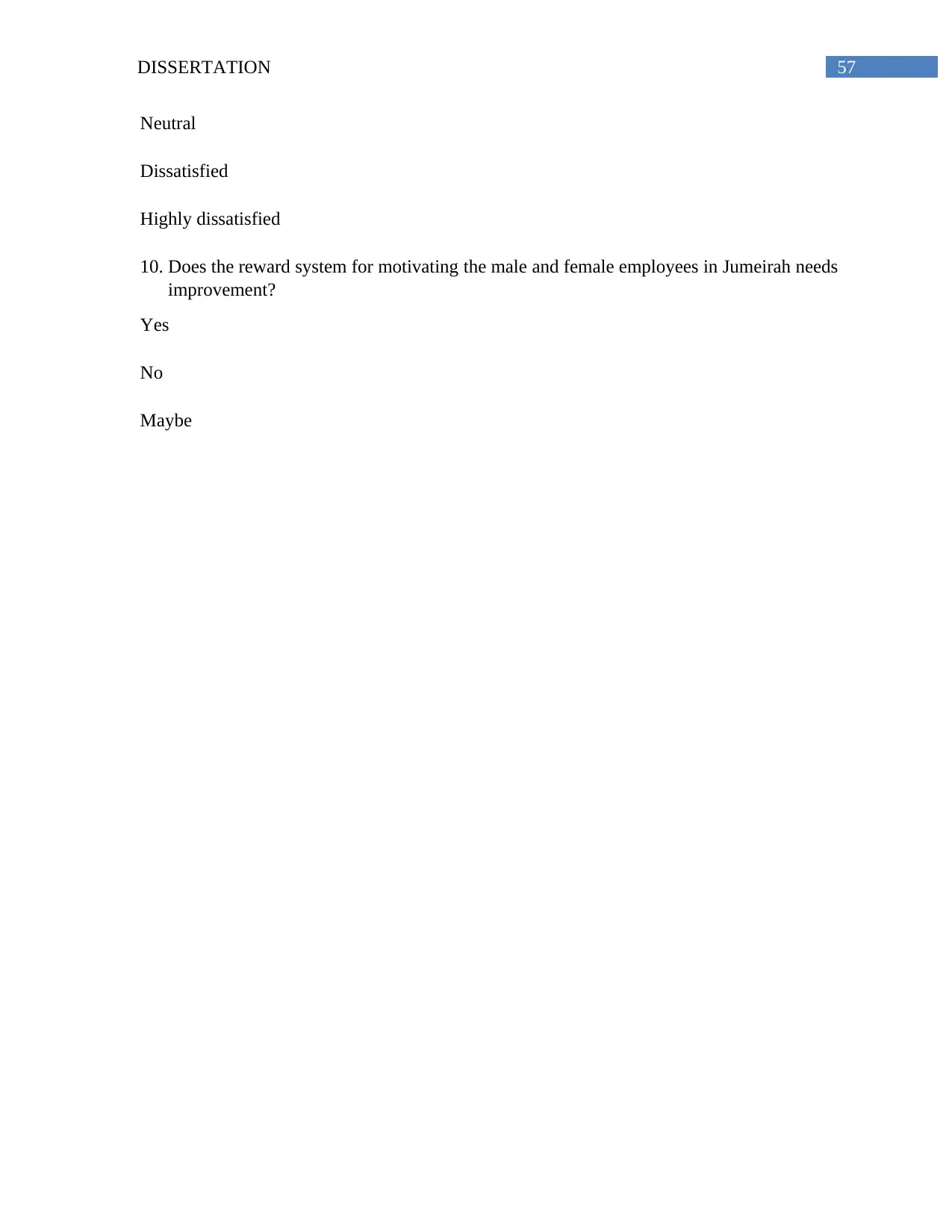
57DISSERTATION
Neutral
Dissatisfied
Highly dissatisfied
10. Does the reward system for motivating the male and female employees in Jumeirah needs
improvement?
Yes
No
Maybe
Neutral
Dissatisfied
Highly dissatisfied
10. Does the reward system for motivating the male and female employees in Jumeirah needs
improvement?
Yes
No
Maybe
Secure Best Marks with AI Grader
Need help grading? Try our AI Grader for instant feedback on your assignments.
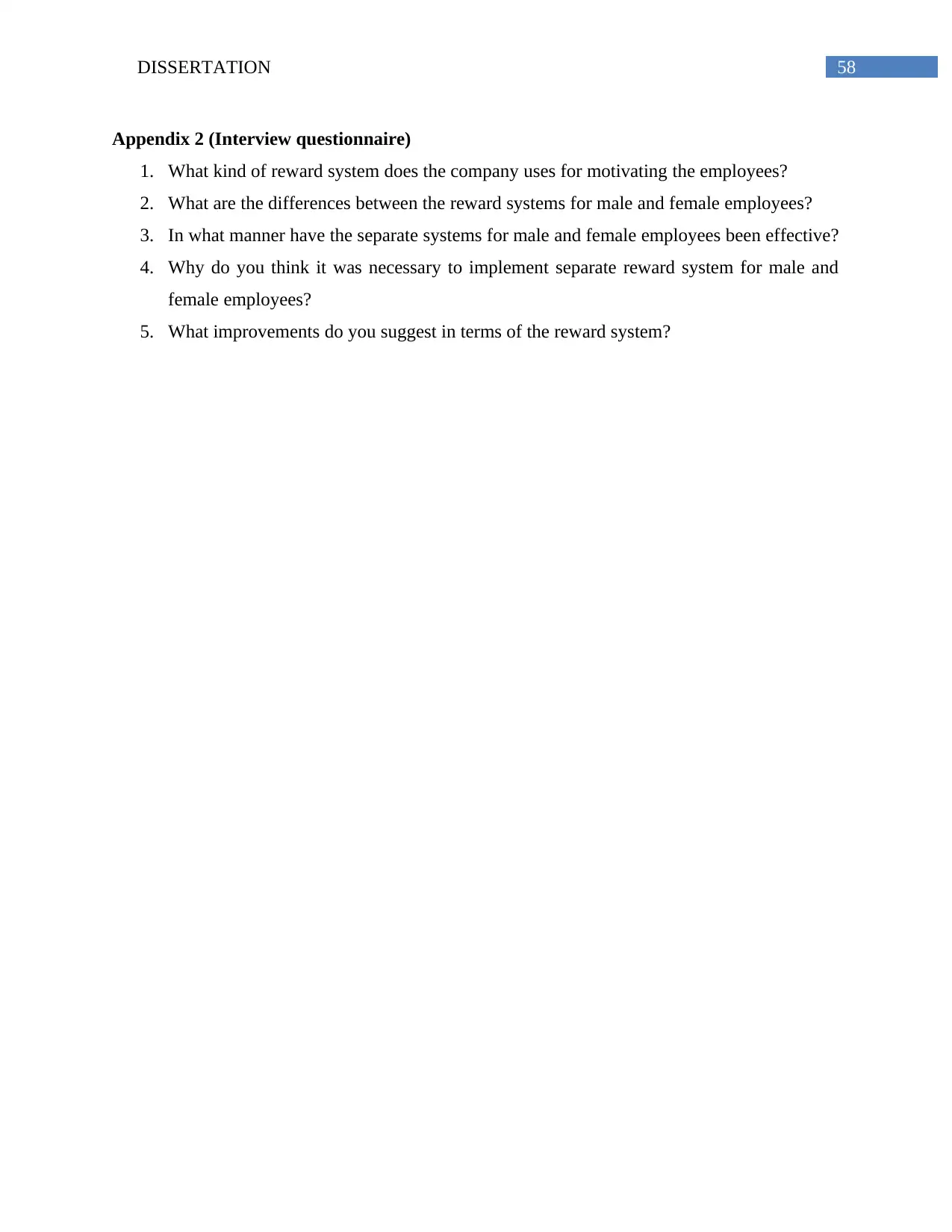
58DISSERTATION
Appendix 2 (Interview questionnaire)
1. What kind of reward system does the company uses for motivating the employees?
2. What are the differences between the reward systems for male and female employees?
3. In what manner have the separate systems for male and female employees been effective?
4. Why do you think it was necessary to implement separate reward system for male and
female employees?
5. What improvements do you suggest in terms of the reward system?
Appendix 2 (Interview questionnaire)
1. What kind of reward system does the company uses for motivating the employees?
2. What are the differences between the reward systems for male and female employees?
3. In what manner have the separate systems for male and female employees been effective?
4. Why do you think it was necessary to implement separate reward system for male and
female employees?
5. What improvements do you suggest in terms of the reward system?
1 out of 59
Related Documents
Your All-in-One AI-Powered Toolkit for Academic Success.
+13062052269
info@desklib.com
Available 24*7 on WhatsApp / Email
![[object Object]](/_next/static/media/star-bottom.7253800d.svg)
Unlock your academic potential
© 2024 | Zucol Services PVT LTD | All rights reserved.





